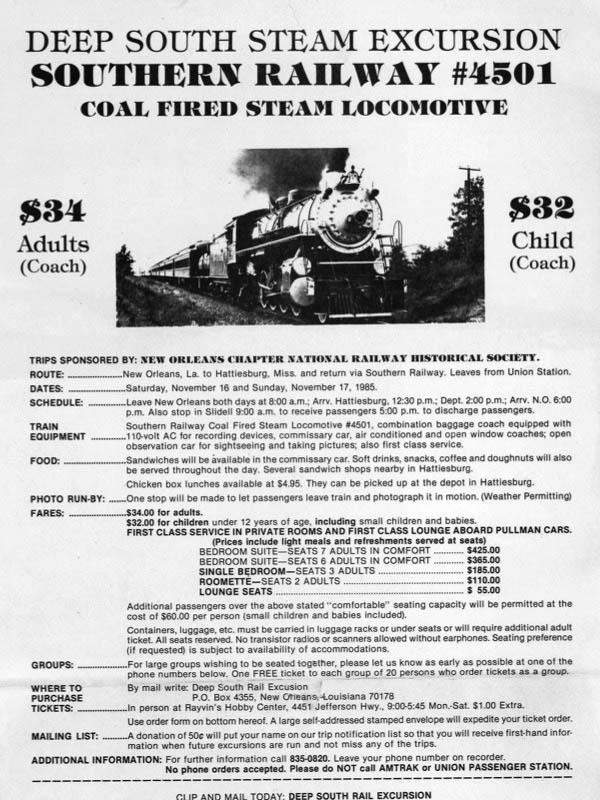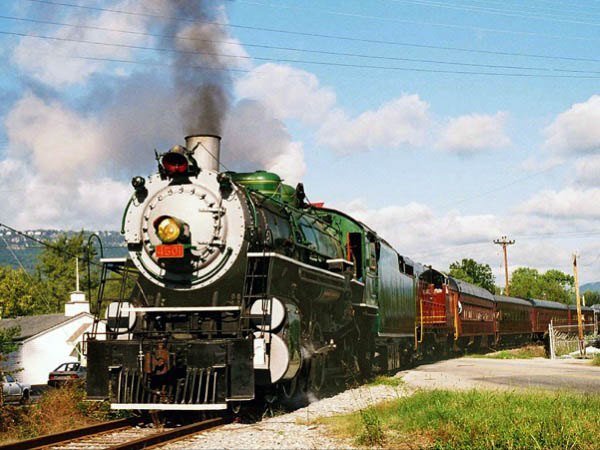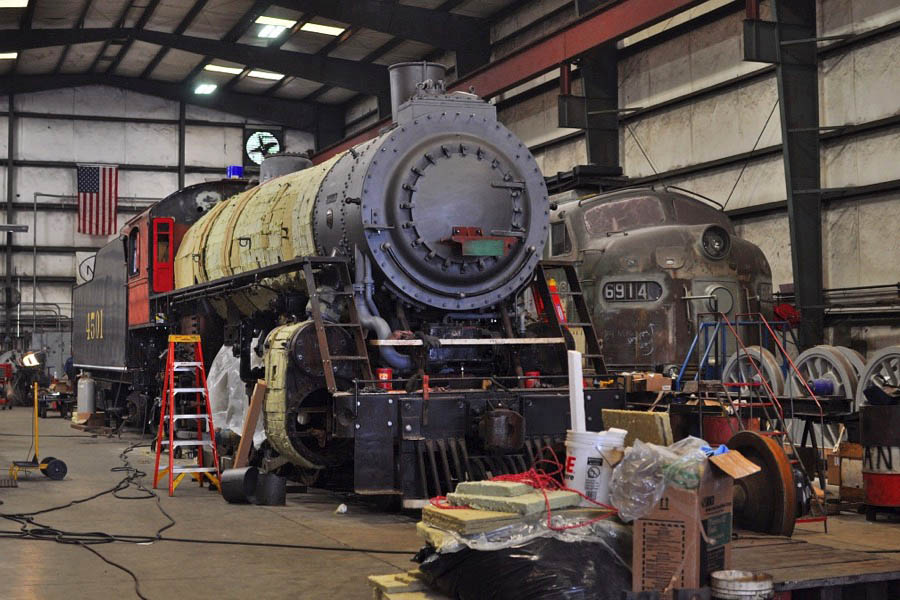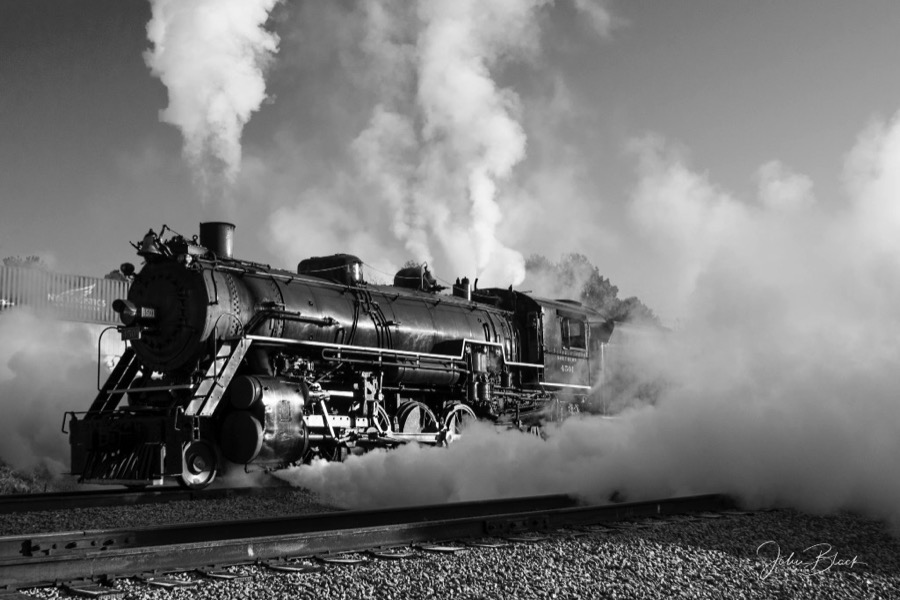
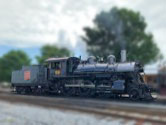



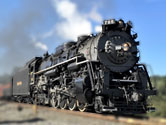
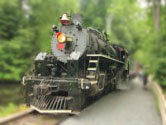

Steam
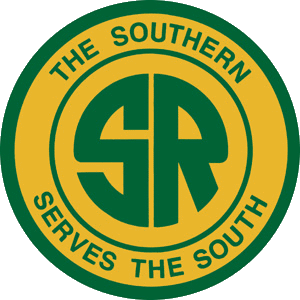 |
Southern Railway #4501The ORIGINAL mainline steam excursion locomotive |

Andy Fletcher drawing / collection

 ocomotive 4501 is very much the story of all steam — the rail locomotion that overcame America's seaboard and riverfront isolation, created our cities, and hauled us through two world wars. For Baldwin-built No. 4501 was and is a typical workaday coal-burning, raucous-whistling engine — the breed that urged farm boys to leave the plow and by which father set his watch. She (only the feminine gender is appropriate) hauled tonnage across the South for her owner Southern Railway for close on four decades, finished up her revenue life on a Kentucky short line, and would have been scrapped but for the intervention of a DuPont researchist who was determined that she bcome an antidote to the diesel. Because of him, and the railway professionals and the amateur train-watchers he enlisted in his cause, No. 4501 began life anew, discarding her black work garb for passenger green and gold, and going forth in 1966 to remind a region of the steam season when train time as the event of the day, when the depot was the only place to be.
ocomotive 4501 is very much the story of all steam — the rail locomotion that overcame America's seaboard and riverfront isolation, created our cities, and hauled us through two world wars. For Baldwin-built No. 4501 was and is a typical workaday coal-burning, raucous-whistling engine — the breed that urged farm boys to leave the plow and by which father set his watch. She (only the feminine gender is appropriate) hauled tonnage across the South for her owner Southern Railway for close on four decades, finished up her revenue life on a Kentucky short line, and would have been scrapped but for the intervention of a DuPont researchist who was determined that she bcome an antidote to the diesel. Because of him, and the railway professionals and the amateur train-watchers he enlisted in his cause, No. 4501 began life anew, discarding her black work garb for passenger green and gold, and going forth in 1966 to remind a region of the steam season when train time as the event of the day, when the depot was the only place to be.
David P. Morgan / Locomotive 4501 / 1968
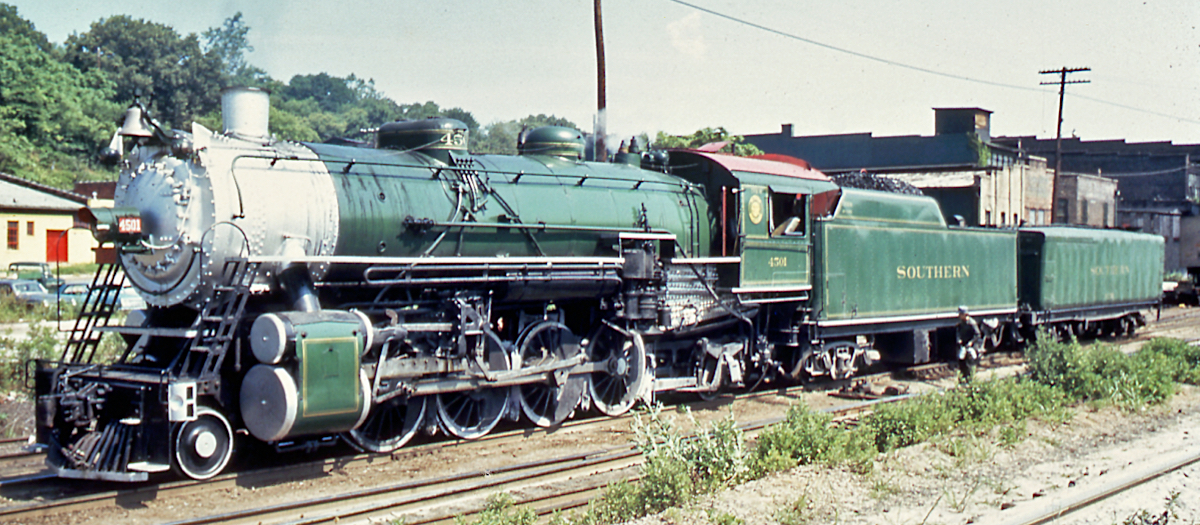
Asheville, NC / Jul 1972 / collection
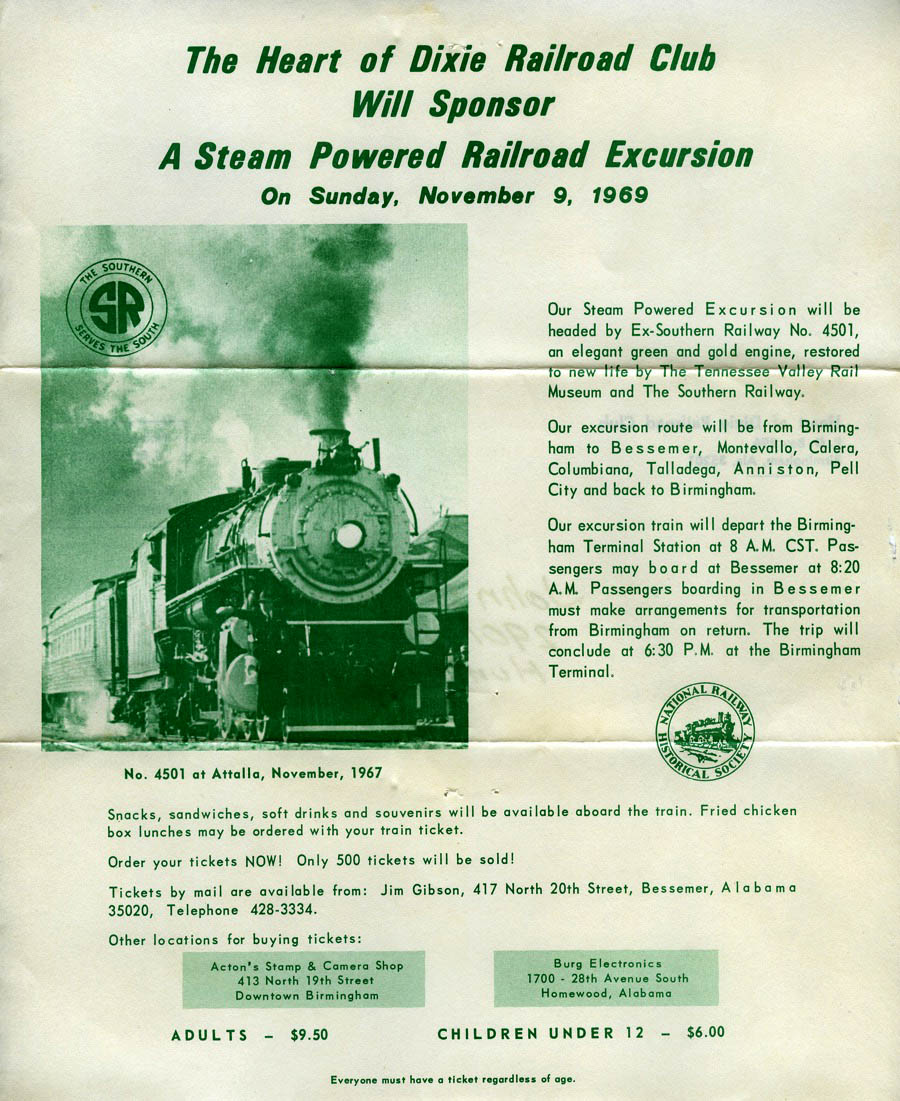
collection

One could not be a railfan in the southeastern United States in the latter half of the 20th century and not be acquainted with Southern's well-traveled Mikado #4501. Following Paul Merriman's recovery of the locomotive from the Kentucky & Tennessee, my dad followed the progress of the little Mike during many of her earlier excursions — including an early trip from her former home in Stearns, Kentucky, back to Chattanooga after repairs and break-in runs. He later rode many trips out of Chattanooga, Huntsville, and Birgmingham in the years that followed her excursion debut. Later on, in the 1980's, together we road several 4501 trips between New Orleans and Hattiesburg, Mississippi. For both us, this 1911 Baldwin and a half dozen heavyweight Southern coaches make for the quintessential deep south excursion train. Mr. Merriman's Mike set the standard for every other excursion performer, even locomotives twice her size and much more sophisticated in design. She is a cornerstone in our railfan memories. I remain grateful to the Tennessee Valley Railroad Museum for keeping her alive in her fourth act.
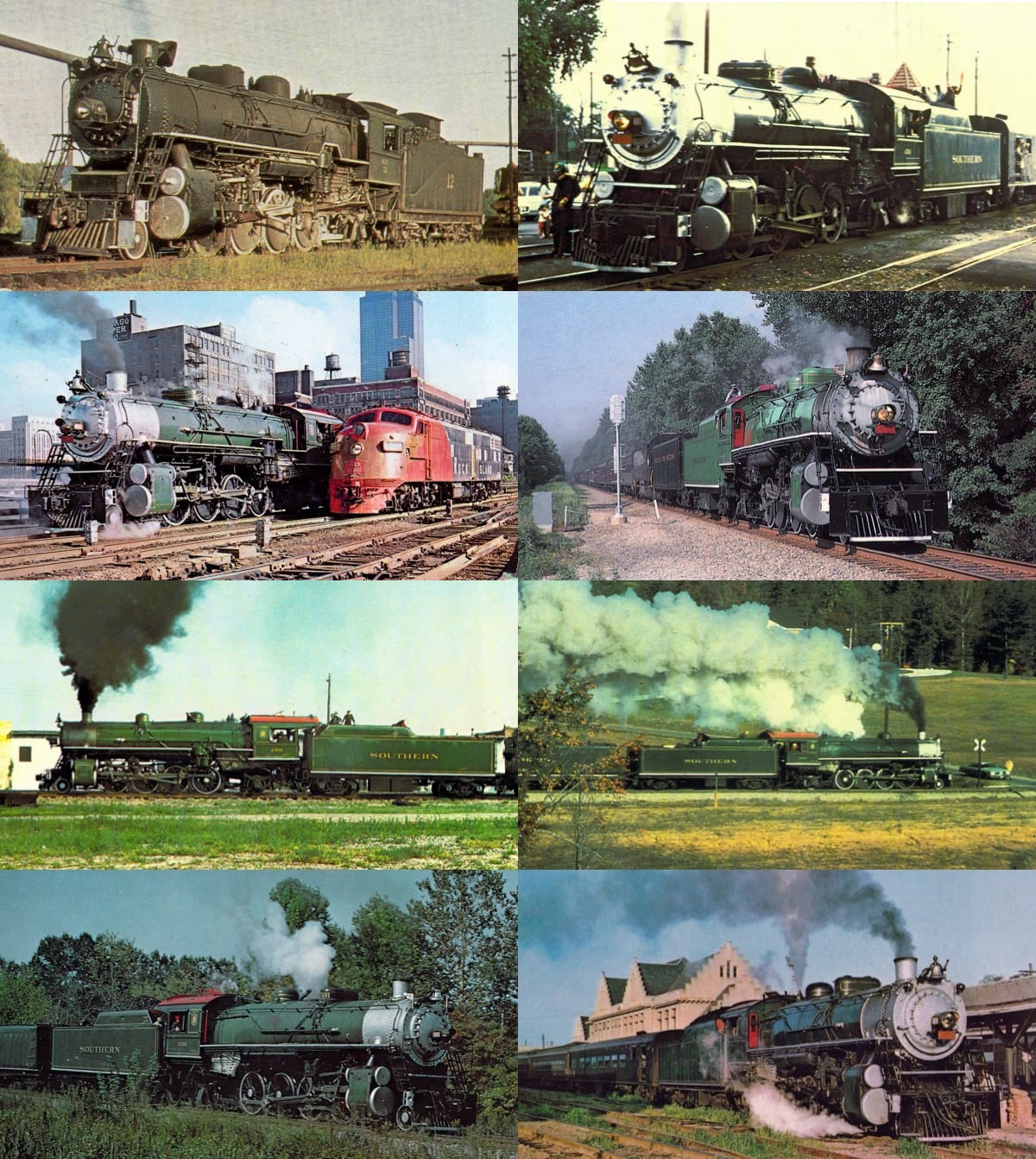
postcard collage from collection / RWH
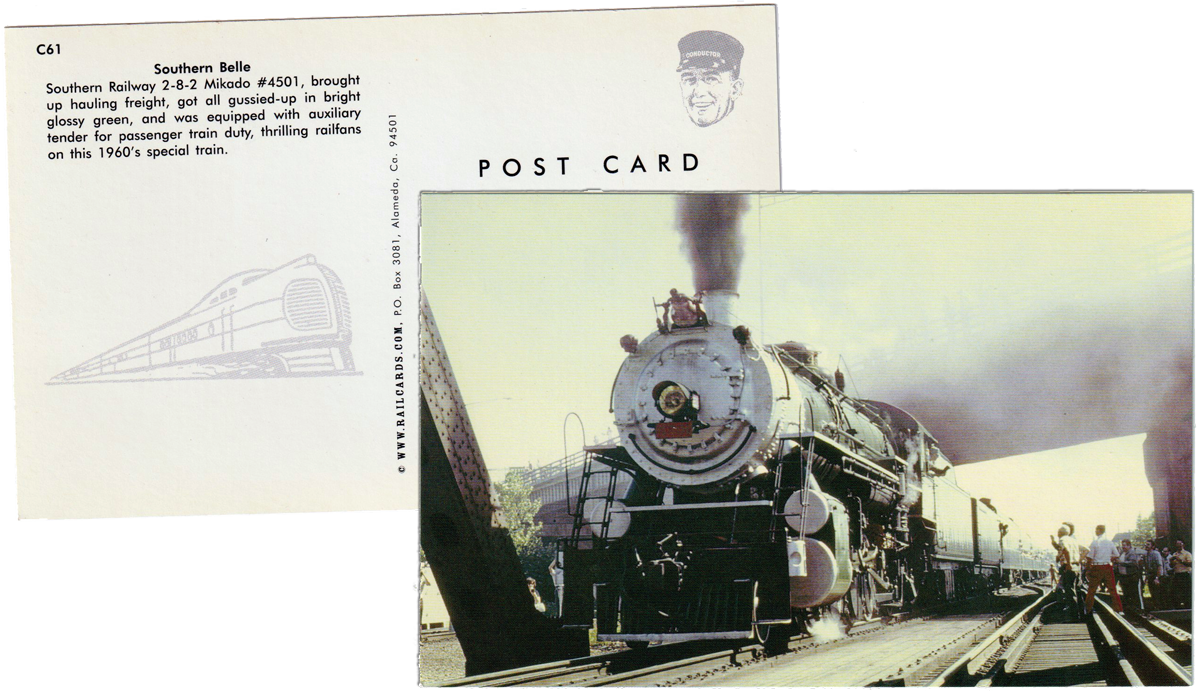
postcard / collection
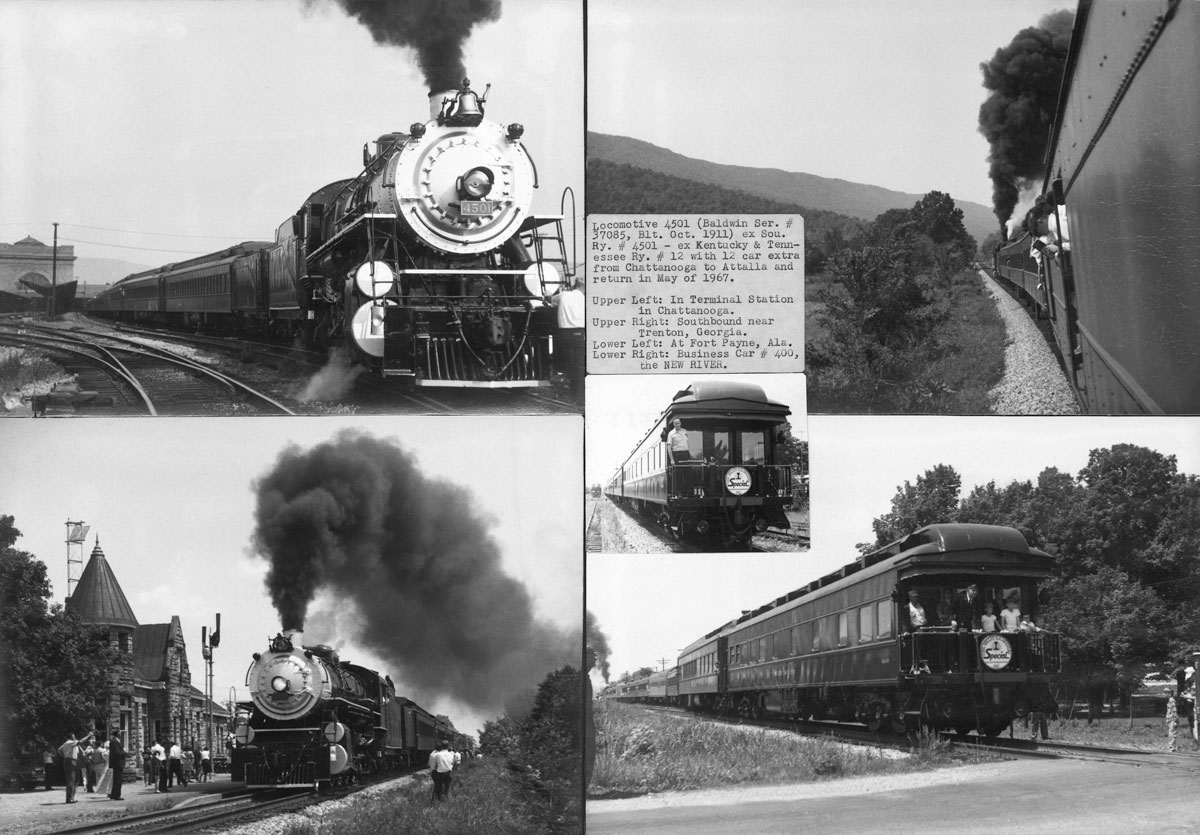
Chattanooga excursion photo array / May 1967 / JCH
Specifications

Southern Class Ms drawing / collection
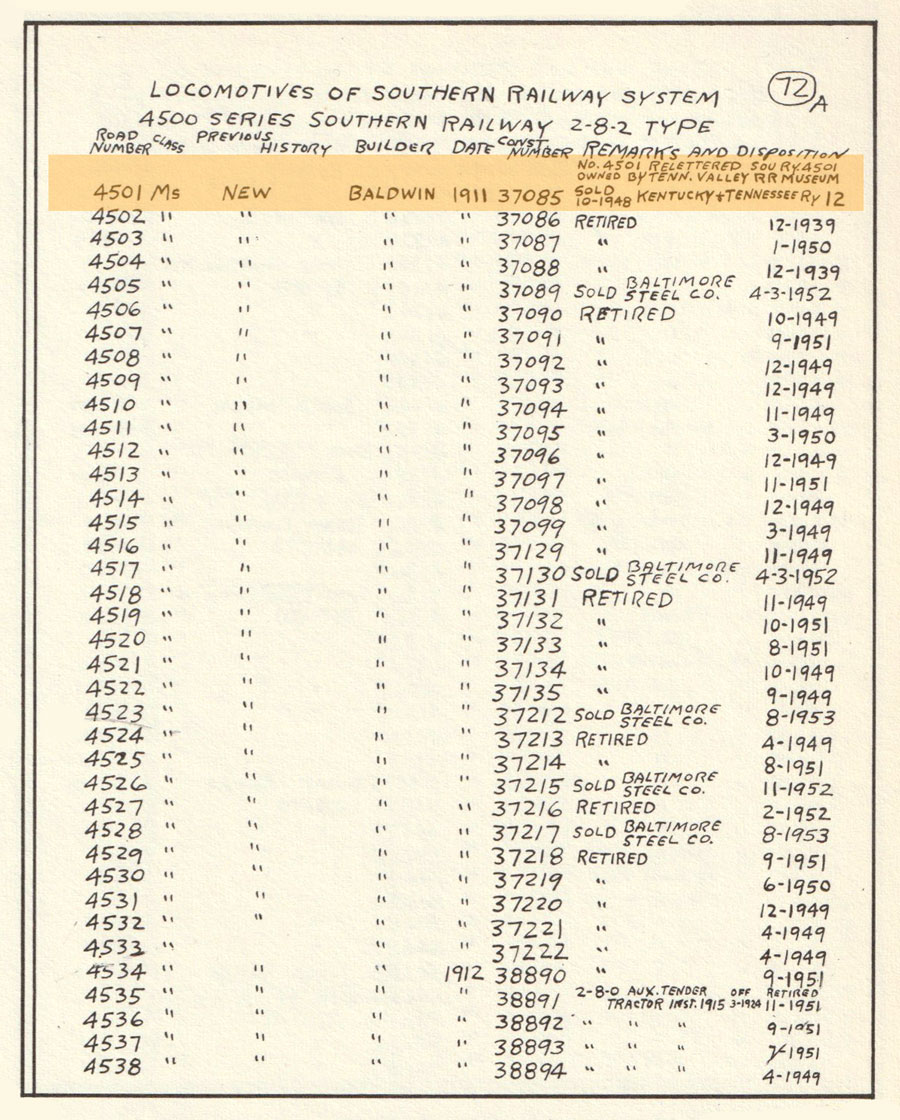
fron Southern Rwy Steam - Richard Prince / collection

| Classification | Ms (Mikado superheated) Ms63 27/30 53.9 |
Builder | Baldwin Locomotive Works | |
| Configuration | 2-8-2 "Mikado" type | Class | 1 of 182 in class Ms | |
| Cylinder size | 27 x 30 inches | Build date | October 1911, Baldwin #37085 | |
| Valve gear | Walschaerts type | Retired | 1963 (revenue) 1998 (excursion) |
|
| Driver size | 63 inches | Current owner | Tennessee Valley Railway Museum | |
| Fuel type | soft coal / water | Current status | In operation at TVRM |
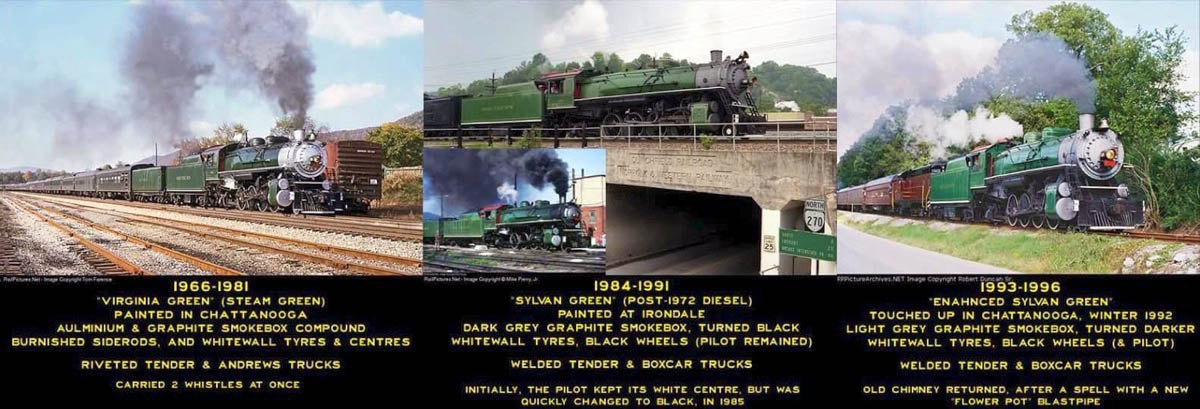
4501 paint schemes / collection
History

collection
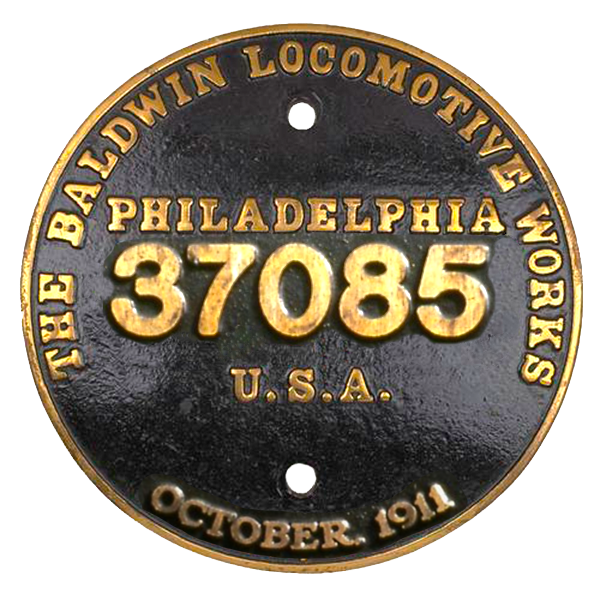
 outhern Railway #4501 was built in October of 1911 by the Baldwin Locomotive Works of Philadelphia. The engine was a 2-8-2 locomotive of the "Mikado" type — named as a nod to the first kettle of this arrangement, built in the 1890s for railways in Japan. 4501 was the first specimen among many of that wheel arrangement the Southern Railway owned. For many years the Southern had relied heavily on the similar 2-8-0 "Consolidation" type, but 4501 and her large class marked the mainline's transition to a heavier, more powerful hauler: the one-axle trailing truck allowing for a larger firebox and therefore greater heating and steaming capacity. 4501 worked on many different divisions of the Southern Railway system from 1911 until her mainline retirement in 1948, including the Tennessee, Virginia, Kentucky, and finally service in the Indiana division.
outhern Railway #4501 was built in October of 1911 by the Baldwin Locomotive Works of Philadelphia. The engine was a 2-8-2 locomotive of the "Mikado" type — named as a nod to the first kettle of this arrangement, built in the 1890s for railways in Japan. 4501 was the first specimen among many of that wheel arrangement the Southern Railway owned. For many years the Southern had relied heavily on the similar 2-8-0 "Consolidation" type, but 4501 and her large class marked the mainline's transition to a heavier, more powerful hauler: the one-axle trailing truck allowing for a larger firebox and therefore greater heating and steaming capacity. 4501 worked on many different divisions of the Southern Railway system from 1911 until her mainline retirement in 1948, including the Tennessee, Virginia, Kentucky, and finally service in the Indiana division.
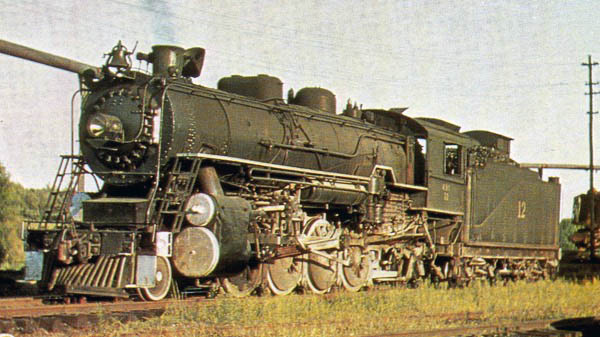 In 1948, L.C. Bruce, general manager of the little Kentucky & Tennessee Railway in Stearns, Kentucky, was in need of a third steam locomotive to supplement his numbers 10 & 11, which had been built new for the shortline. K&T was a coal-hauling shortline on the border of its namesake states, taking loads from its mines out to the Southern's busy "Rathole" Division mainline.
Being a former Southern man himself, Bruce naturally headed back to the Southern's dead line — specifically, in Princeton, Indiana — to find and secure the eldest of the Southern’s 2-8-2’s, which would become his K&T #12. She was the largest and most powerful locomotive the shortline ever owned, spending fifteen years working the mine runs with heavy cuts of loaded hoppers. K&T crews called her "The Big Engine."
In 1948, L.C. Bruce, general manager of the little Kentucky & Tennessee Railway in Stearns, Kentucky, was in need of a third steam locomotive to supplement his numbers 10 & 11, which had been built new for the shortline. K&T was a coal-hauling shortline on the border of its namesake states, taking loads from its mines out to the Southern's busy "Rathole" Division mainline.
Being a former Southern man himself, Bruce naturally headed back to the Southern's dead line — specifically, in Princeton, Indiana — to find and secure the eldest of the Southern’s 2-8-2’s, which would become his K&T #12. She was the largest and most powerful locomotive the shortline ever owned, spending fifteen years working the mine runs with heavy cuts of loaded hoppers. K&T crews called her "The Big Engine."
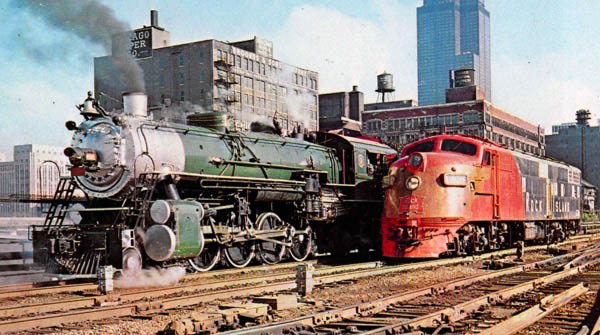 When big #12 was retired by the little Kentucky & Tennessee in 1963, a Chattanooga railfan with a keen interest in steam, Paul H. Merriman, purchased the locomotive with $5,000 he raised for the cause of saving steam. Together with Robert Soule, he created The 4501 Corporation, and with much help from railfans and retired steam masters he restored the engine for excursion use on the Southern Railway system. In this way, the rehabilitated 4501 launched the Southern Railway's well known and long-running steam excursion program, which operated across the Southeast for many decades ... until it was dropped in 1994 by Southern's successor Norfolk Southern. Dressed in passenger "Virginia Green," 4501 headed up hundreds of weekend trips from a great many bases, including some double- and triple-headed action with the larger locomotives at the end of the excursion era. Periods of mainline excursion service spanned many years: 1966-81, 1984-85, 1989, 1991-98 and mostly recently 2015.
When big #12 was retired by the little Kentucky & Tennessee in 1963, a Chattanooga railfan with a keen interest in steam, Paul H. Merriman, purchased the locomotive with $5,000 he raised for the cause of saving steam. Together with Robert Soule, he created The 4501 Corporation, and with much help from railfans and retired steam masters he restored the engine for excursion use on the Southern Railway system. In this way, the rehabilitated 4501 launched the Southern Railway's well known and long-running steam excursion program, which operated across the Southeast for many decades ... until it was dropped in 1994 by Southern's successor Norfolk Southern. Dressed in passenger "Virginia Green," 4501 headed up hundreds of weekend trips from a great many bases, including some double- and triple-headed action with the larger locomotives at the end of the excursion era. Periods of mainline excursion service spanned many years: 1966-81, 1984-85, 1989, 1991-98 and mostly recently 2015.
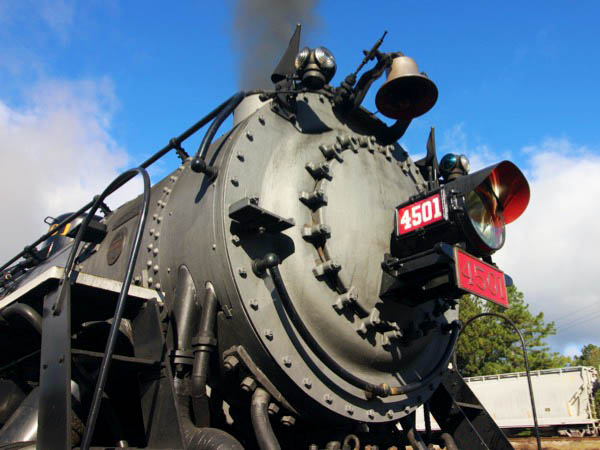 #4501 is owned by the Tennessee Valley Railroad Museum in East Chattanooga, Tennessee
(which Merriman founded with Bob Soule and others), where she remains on the National Historic Register of places and equipment and continues in excursion service both on the museum's trackage and for frequent off-property trips. Her final runs in the Norfolk Southern era steam program took place in 1998, and for more than a decade the locomotive was stored at TVRM awaiting a complete overhaul. Rejuvenation for her fifth act as a working steamer came in 2011, when Norfolk Southern's 21st Century Steam program prompted a long-awaited overhaul. Soule Shops at TVRM returned the locomotive to the basic black freight paint scheme proper to her origins as a Southern Railway freight hauler. A few other modifications were made as well in this rebuild, including the addition of a mechanical stoker and a feedwater heater. Today she can be found occasionally handling the museum's Missionary Ridge local trains, but more often in charge of the longer, offsite excursions requiring her greater power. No doubt Paul Merriman would be pleased that his rescue of 4501 has resulted in a locomotive still making steam 110 years after her construction.
#4501 is owned by the Tennessee Valley Railroad Museum in East Chattanooga, Tennessee
(which Merriman founded with Bob Soule and others), where she remains on the National Historic Register of places and equipment and continues in excursion service both on the museum's trackage and for frequent off-property trips. Her final runs in the Norfolk Southern era steam program took place in 1998, and for more than a decade the locomotive was stored at TVRM awaiting a complete overhaul. Rejuvenation for her fifth act as a working steamer came in 2011, when Norfolk Southern's 21st Century Steam program prompted a long-awaited overhaul. Soule Shops at TVRM returned the locomotive to the basic black freight paint scheme proper to her origins as a Southern Railway freight hauler. A few other modifications were made as well in this rebuild, including the addition of a mechanical stoker and a feedwater heater. Today she can be found occasionally handling the museum's Missionary Ridge local trains, but more often in charge of the longer, offsite excursions requiring her greater power. No doubt Paul Merriman would be pleased that his rescue of 4501 has resulted in a locomotive still making steam 110 years after her construction.

 t happens so often, one man's self-appointed mission changed the course of history. The man was Paul Merriman, and if it hadn't been for him and the personal risk he took, none of what follows might have transpired. Merriman earned this place in the history of railway preservation with a few strokes of a pen. He saved a solitary steam locomotive and set in motion a series of events that would prove nothing less than amazing.
t happens so often, one man's self-appointed mission changed the course of history. The man was Paul Merriman, and if it hadn't been for him and the personal risk he took, none of what follows might have transpired. Merriman earned this place in the history of railway preservation with a few strokes of a pen. He saved a solitary steam locomotive and set in motion a series of events that would prove nothing less than amazing.
Jim Wrinn / Steam's Camelot: Southern and Norfolk Southern Excursions in Color
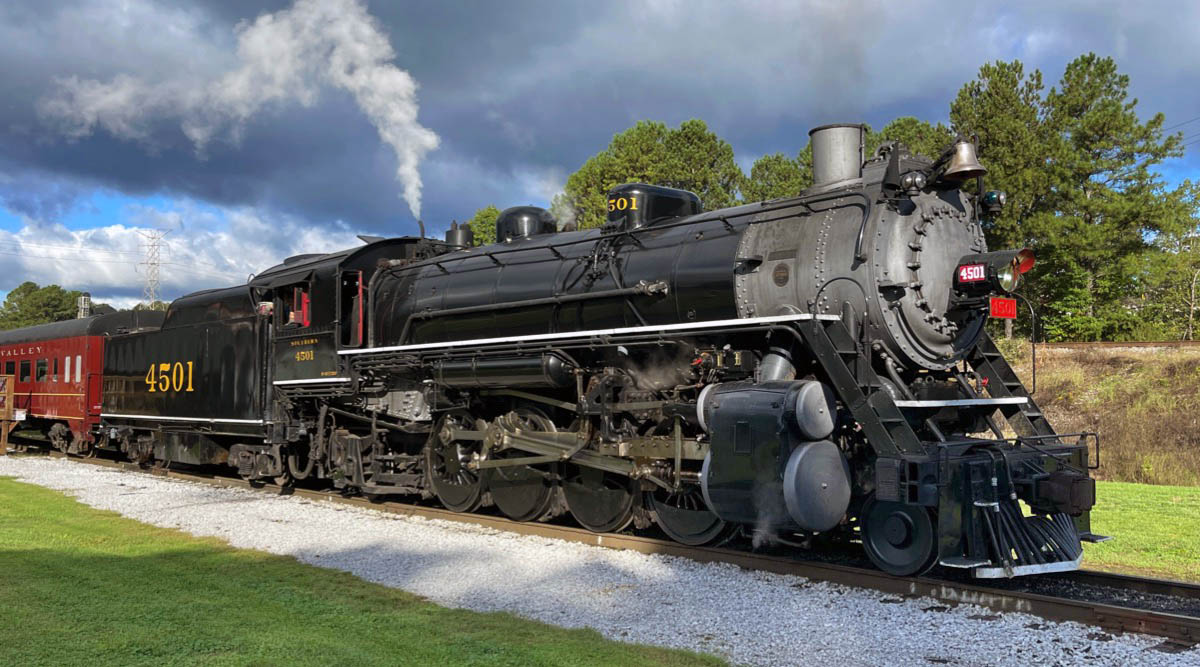
East Chattanooga, Tn / Oct 2021 / RWH
Memories / Images

 I always thought that #4501 had the correct proportions and the right look for a steam locomotive. The trailing truck was just in the right place, the stack was the right height over the smoke box, it had a visor over the headlight, and so on. Over the years, I've ridden at least 2000 miles behind 4501 in a number of different locations.
I always thought that #4501 had the correct proportions and the right look for a steam locomotive. The trailing truck was just in the right place, the stack was the right height over the smoke box, it had a visor over the headlight, and so on. Over the years, I've ridden at least 2000 miles behind 4501 in a number of different locations.
1967

In May of 1967, an excursion was operated from Chattanooga, Tennessee, down to Attalla, Alabama, using 4501. Two of us from Huntsville took Southern Railway local train #36 to Chattanooga and once there we boarded the excursion at the station (now the Chattanooga Choo Choo hotel). We rode behind 4501 all day, to Attalla and back. When we returned to Chattanooga that evening, we could see from the excursion train that local #36 was ready to depart ... without us. We lamented to the excursion conductor that we would surely miss our train. When he understood what our problem was, he said, "I can take care of that for you." He radioed #36 and asked them to wait for two passengers for Huntsville. They did ... and we walked across the tracks, right into #36's single coach. Now that's real Southern service!
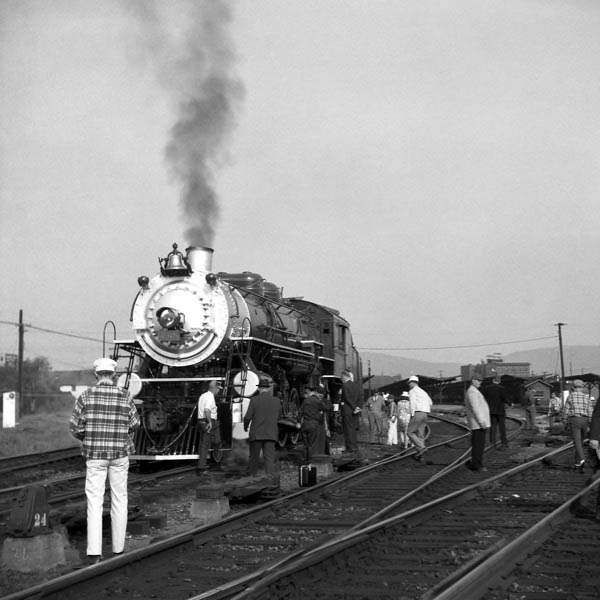
Chattanooga, Tn / May 1967 / JCH
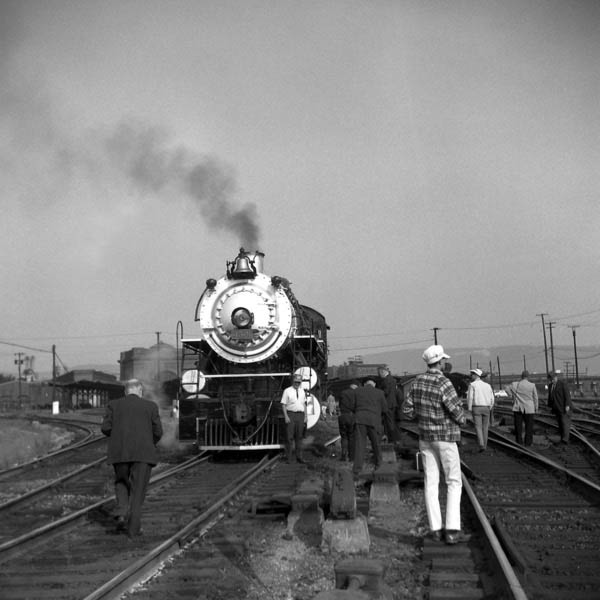
Chattanooga, Tn / May 1967 / JCH
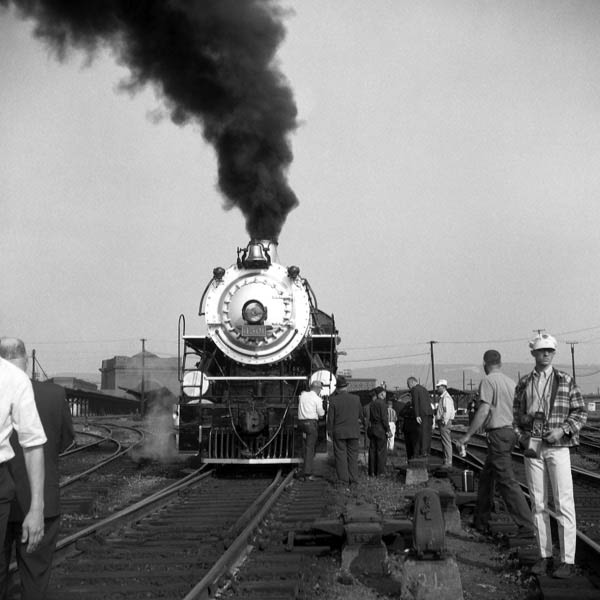
Chattanooga, Tn / May 1967 / JCH
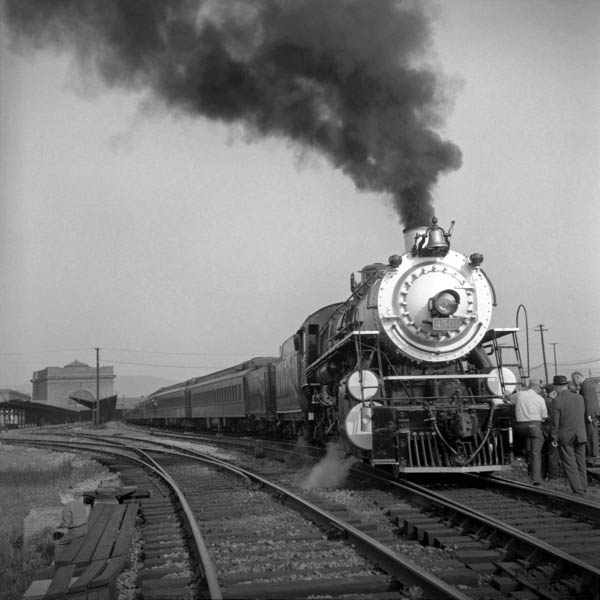
Chattanooga, Tn / May 1967 / JCH
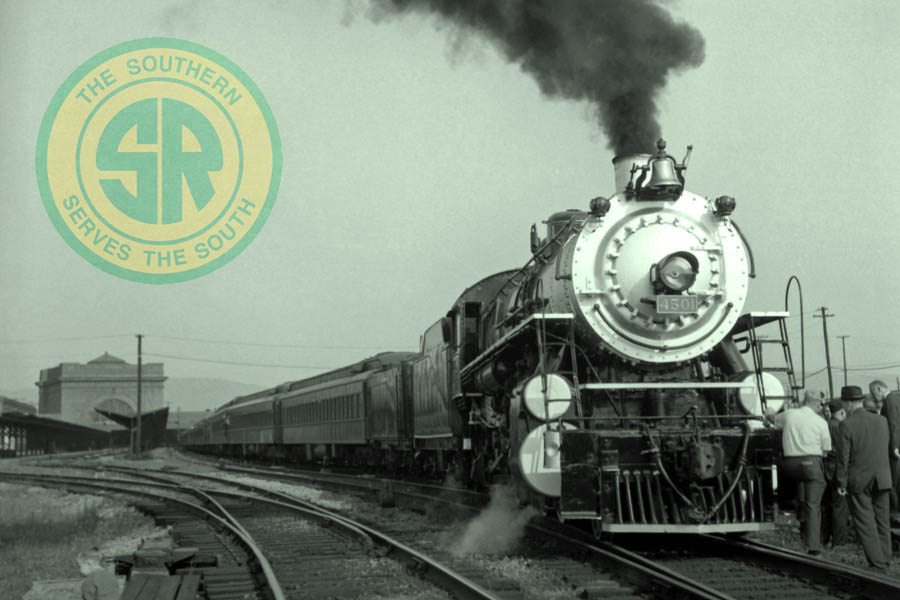
Chattanooga, Tn / May 1967 / JCH

Fort Payne, Al / May 1967 / JCH
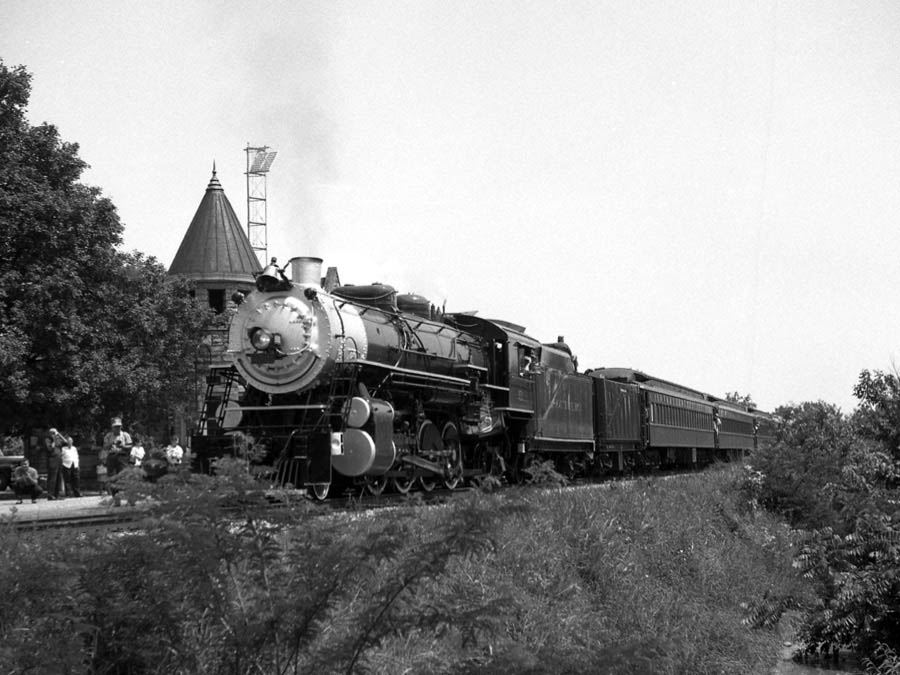
Fort Payne, Al / May 1967 / JCH

Reece City, Al / May 1967 / JCH

Reece City, Al / May 1967 / JCH
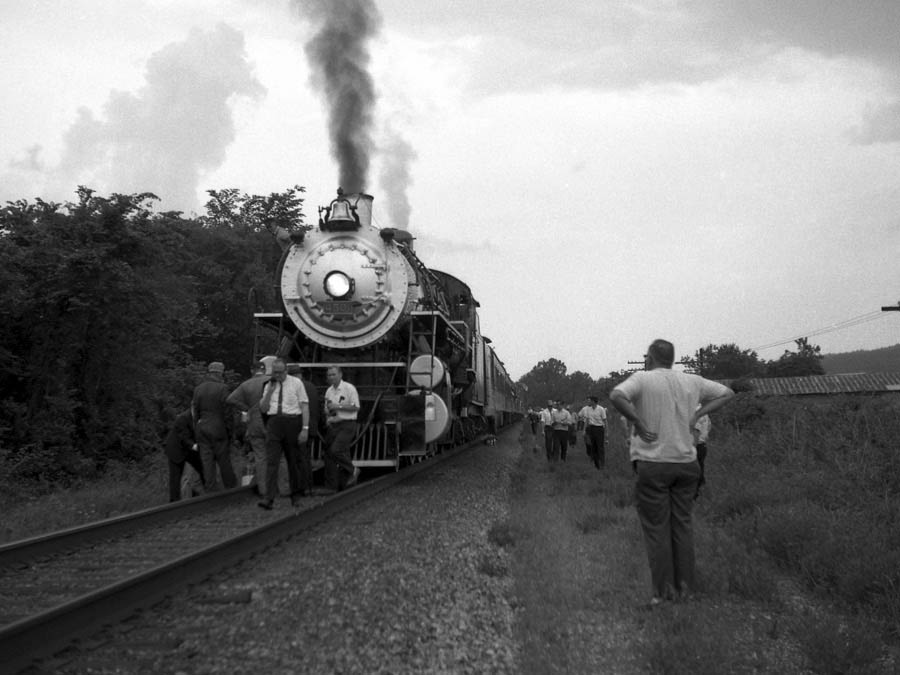
Reece City, Al / May 1967 / JCH
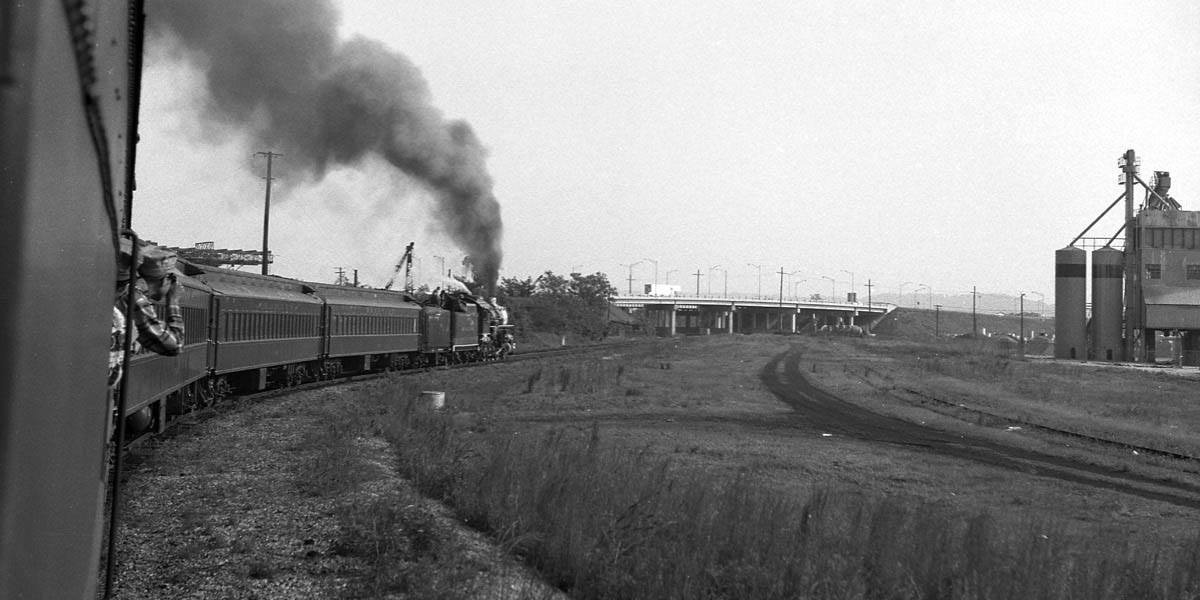
Attalla, Al / May 1967 / JCH
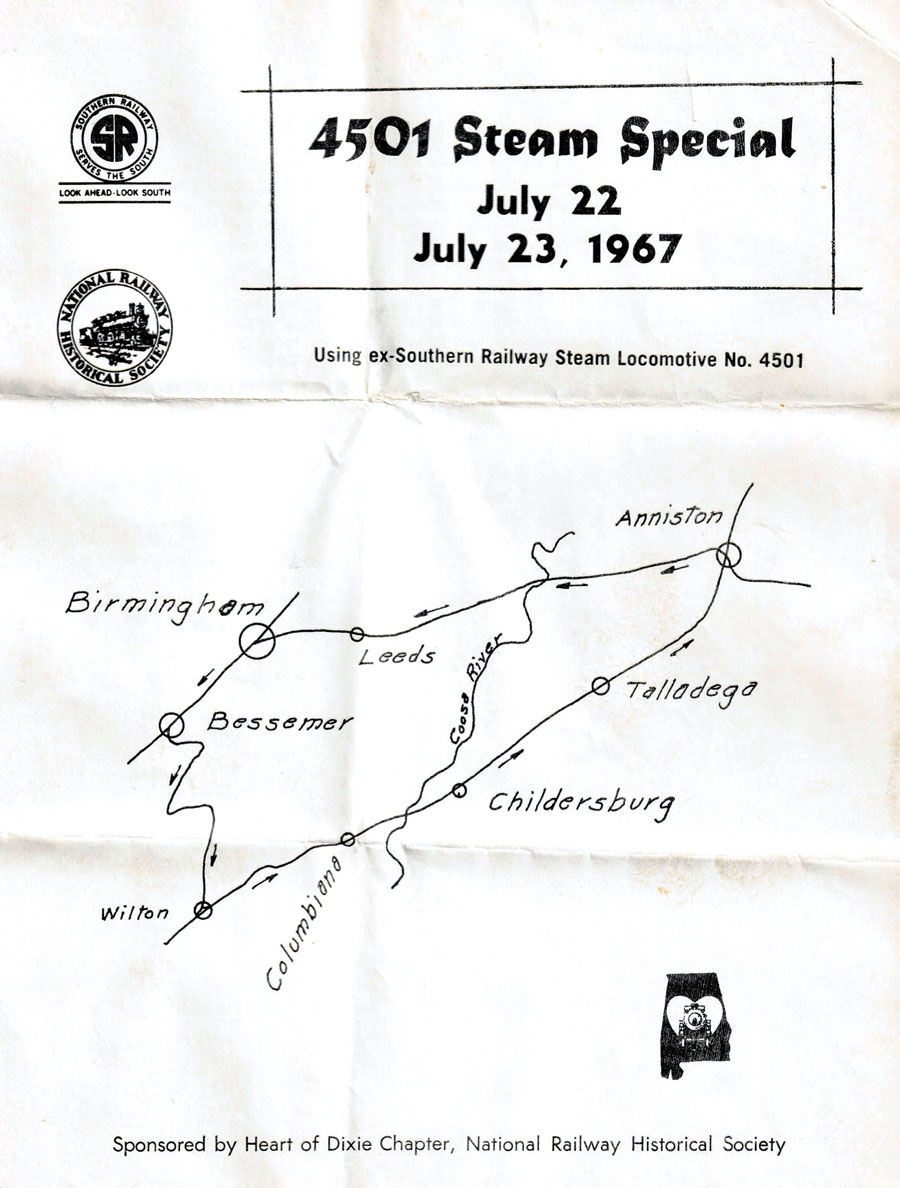
1967 excursion handout / collection
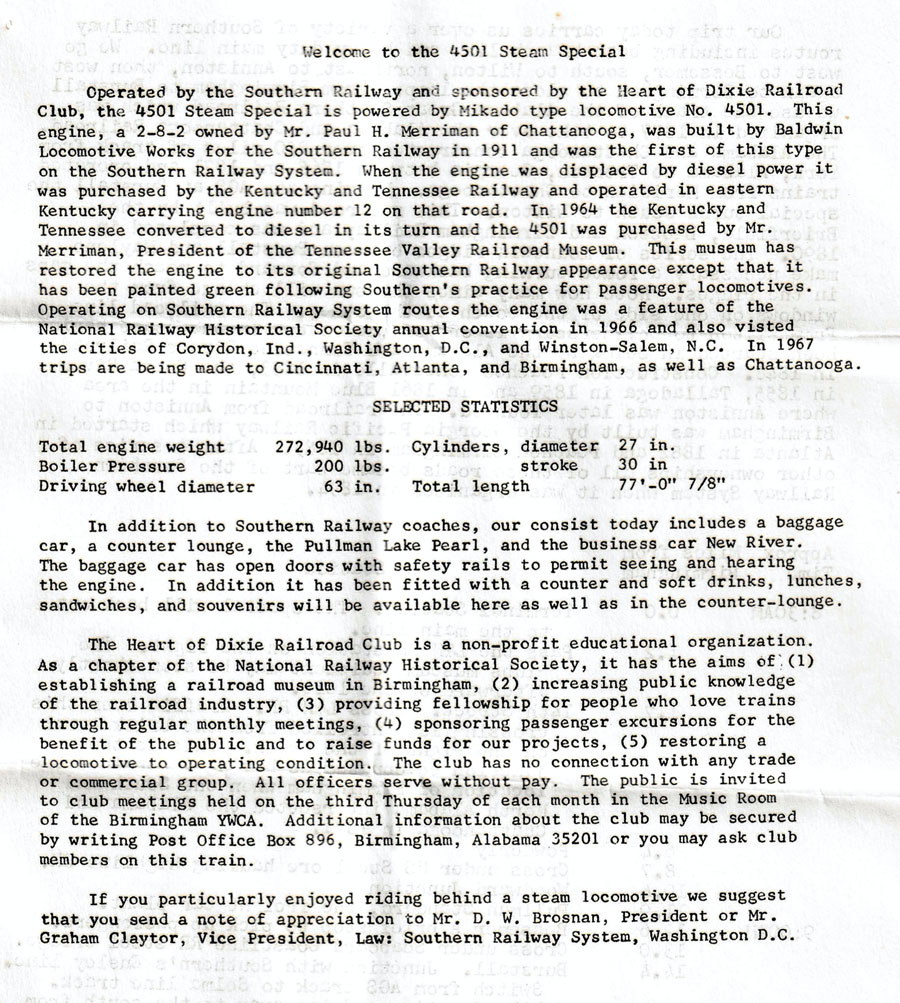
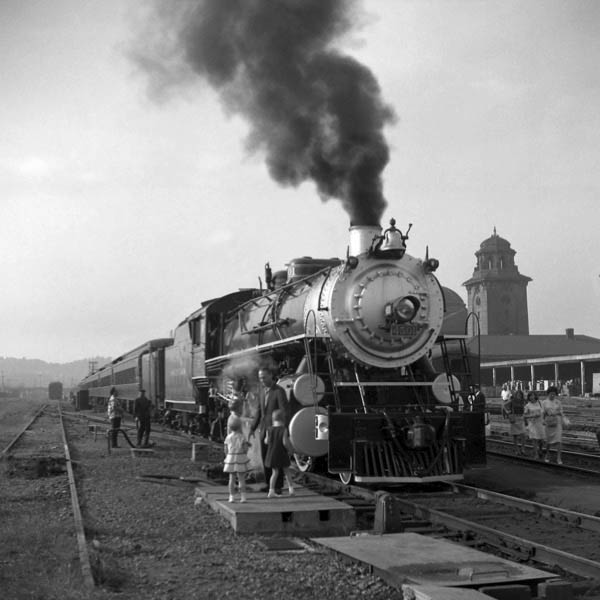
Birmingham, Al / Jul 1967 / JCH
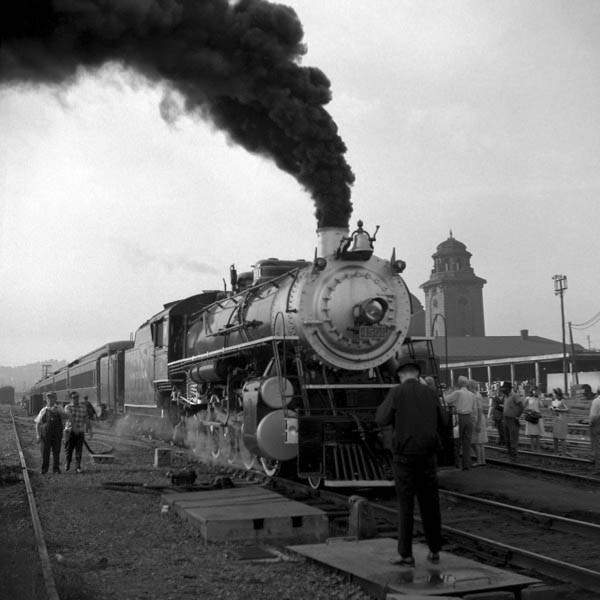
Birmingham, Al / Jul 1967 / JCH
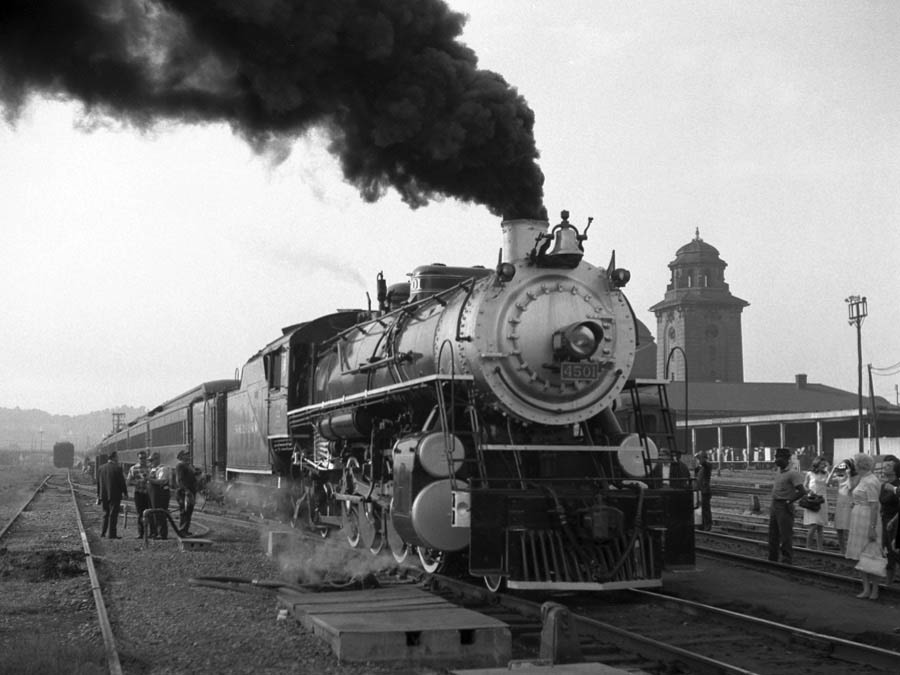
Birmingham, Al / Jul 1967 / JCH
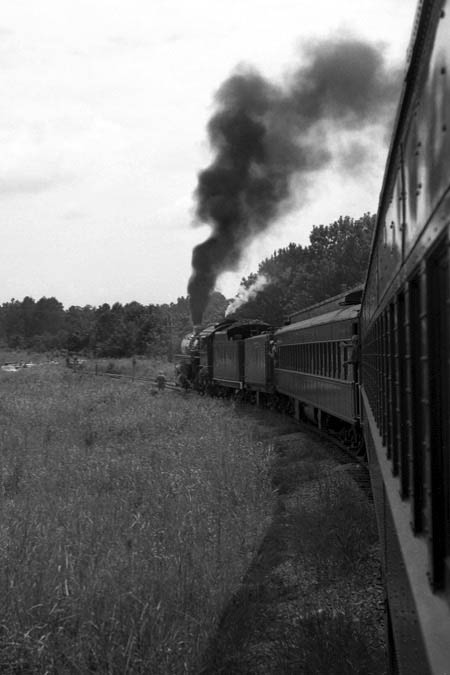
Jul 1967 / JCH
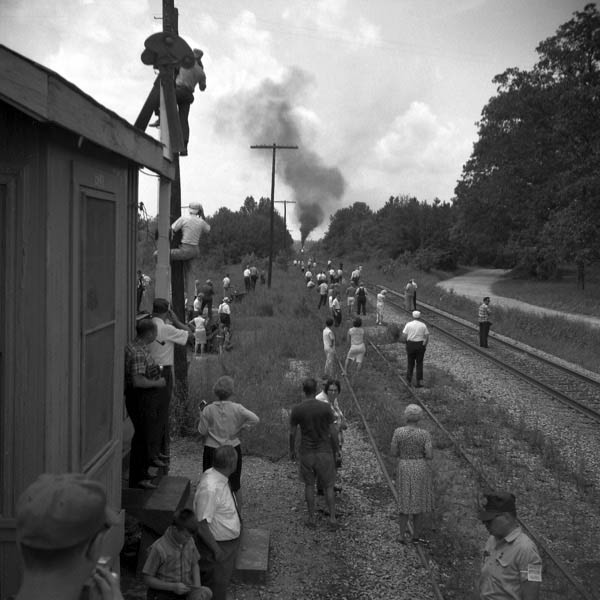
Columbiana, Al / Jul 1967 / JCH
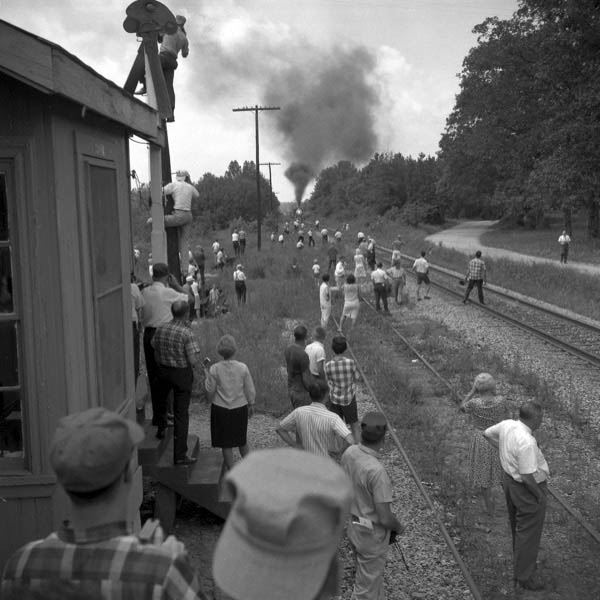
Columbiana, Al / Jul 1967 / JCH
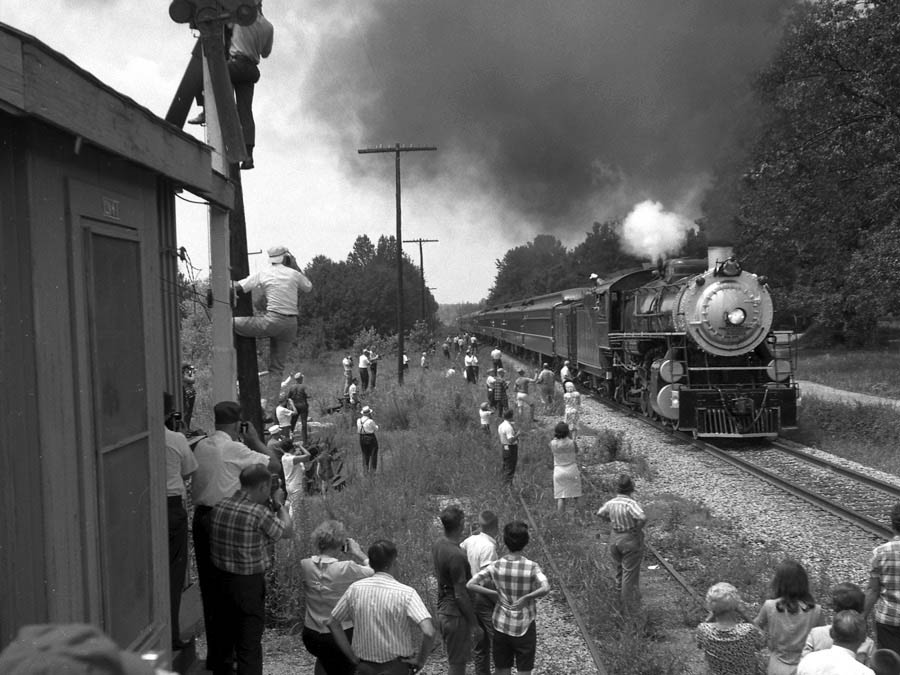
Columbiana, Al / Jul 1967 / JCH
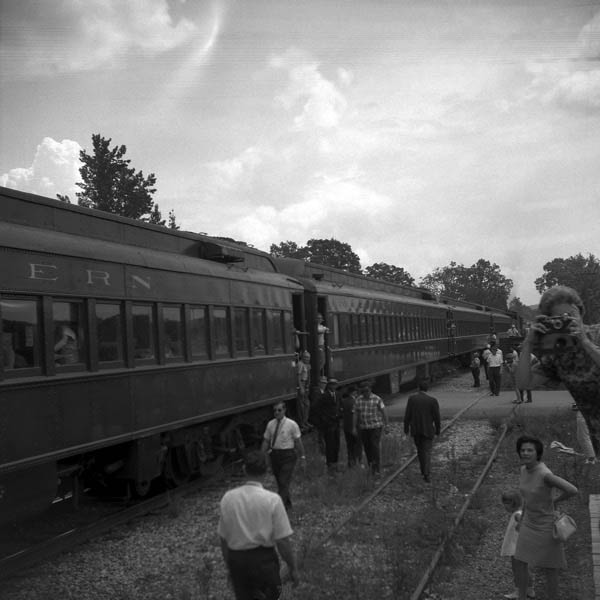
Columbiana, Al / Jul 1967 / JCH

Columbiana, Al / Jul 1967 / JCH
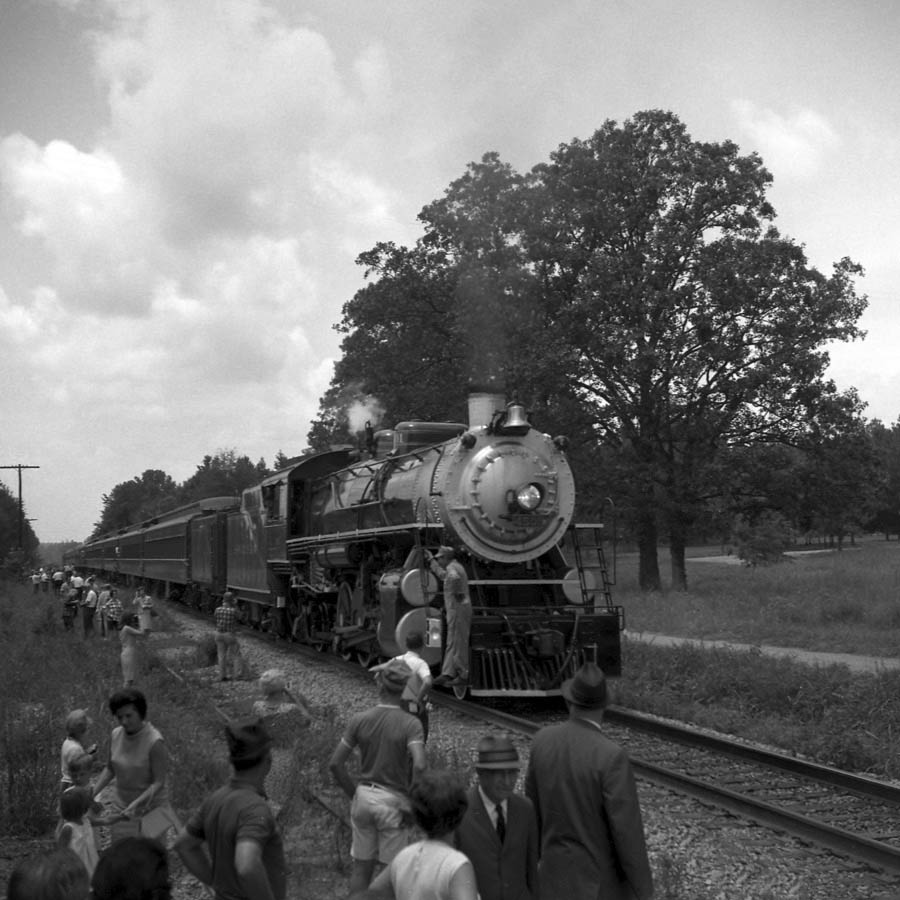
Columbiana, Al / Jul 1967 / JCH
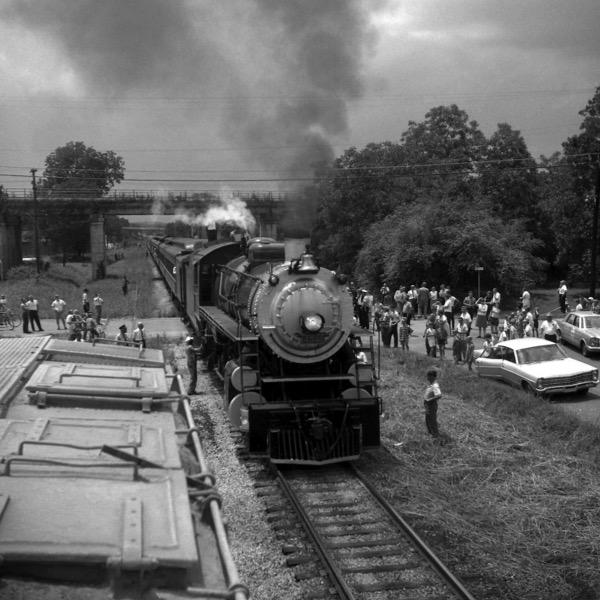
Childersburg, Al / Jul 1967 / JCH
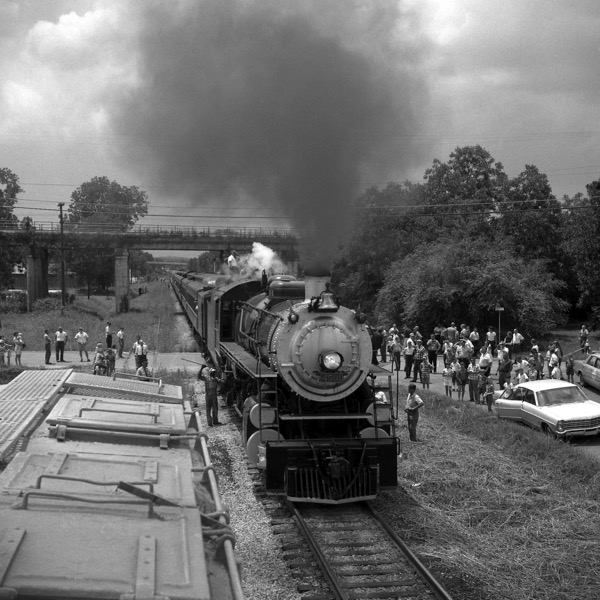
Childersburg, Al / Jul 1967 / JCH
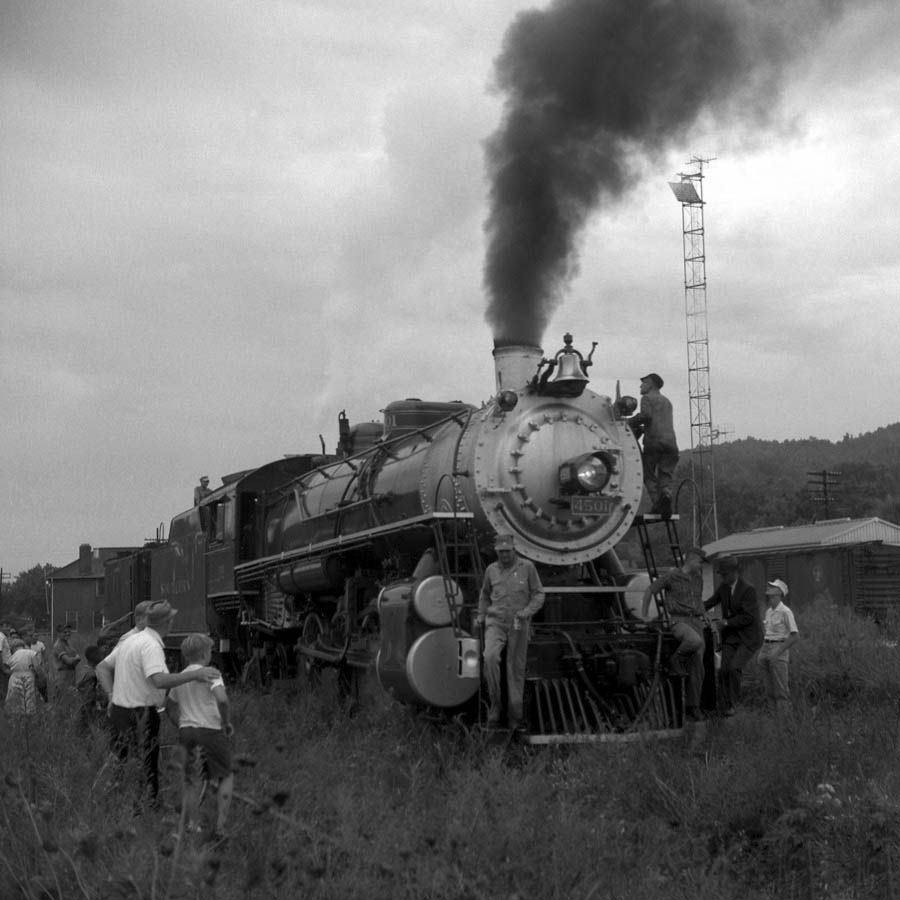
Anniston, Al / Jul 1967 / JCH
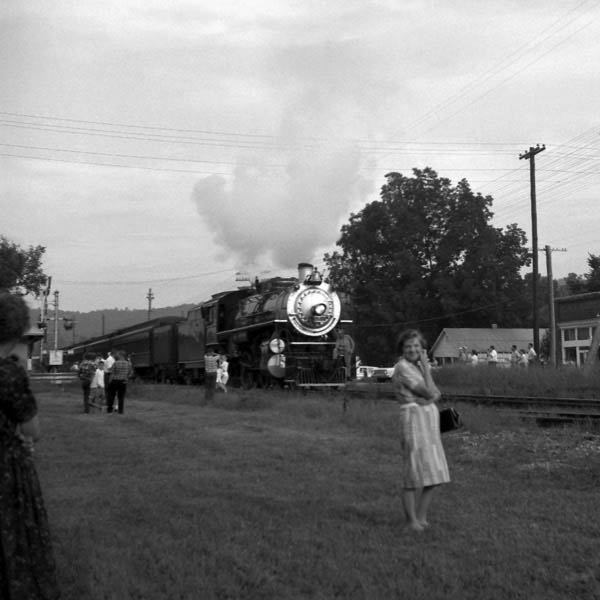
Leeds, Al / Jul 1967 / JCH

Leeds, Al / Jul 1967 / JCH
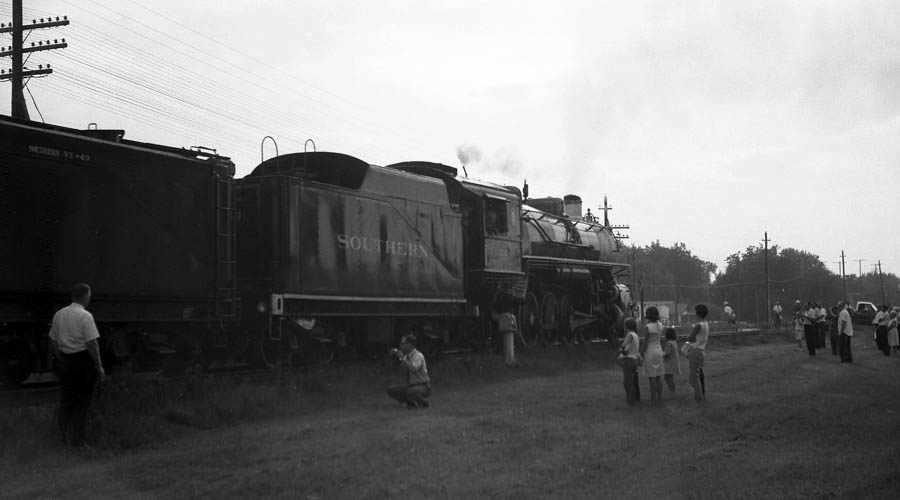
Leeds, Al / Jul 1967 / JCH
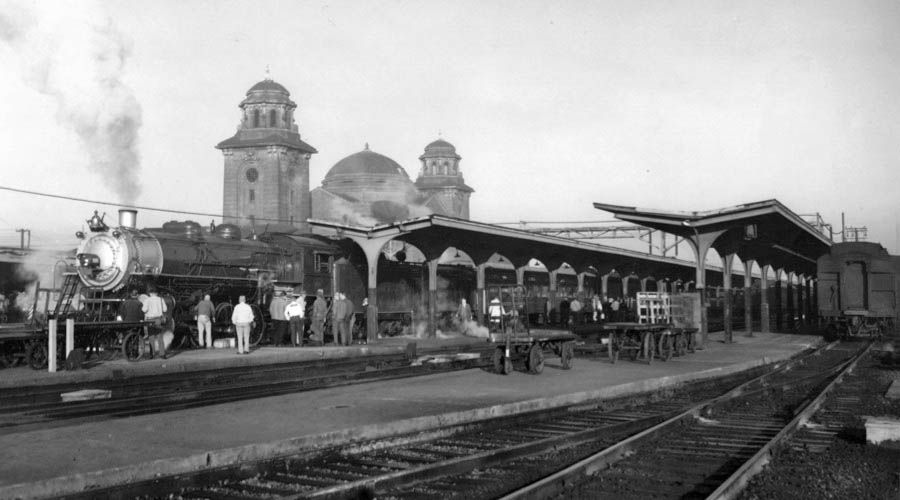
Birmingham, Al / Jul 1967 / JCH

1969 promotional flyer / collection
1968
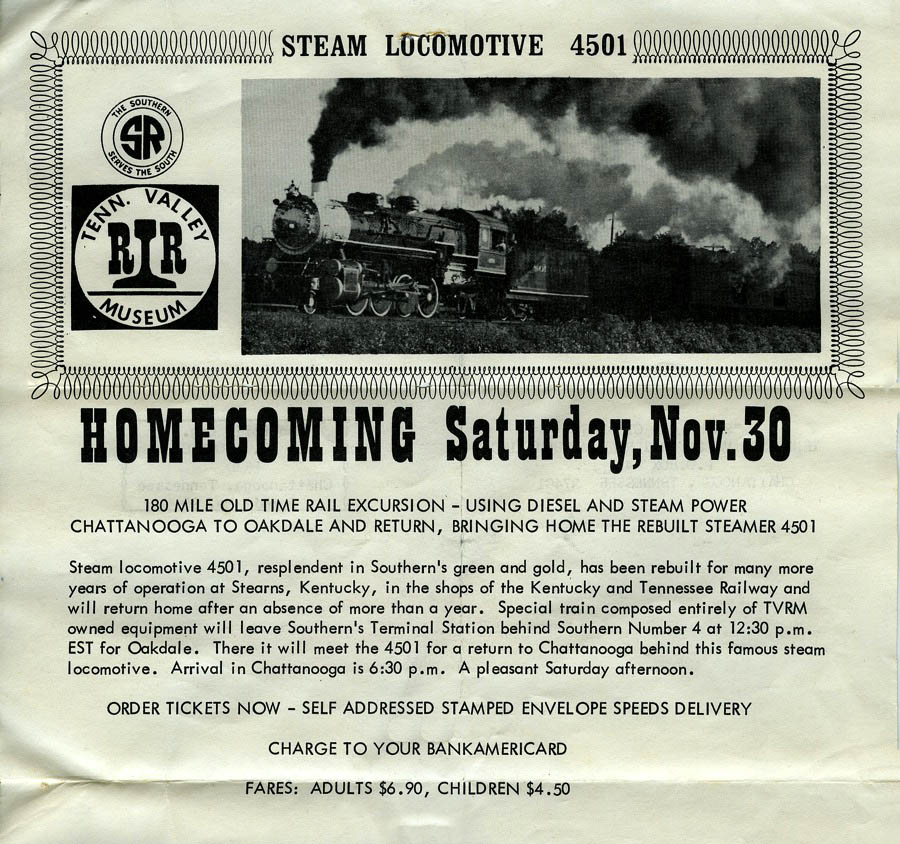
1968 promotional flyer / collection
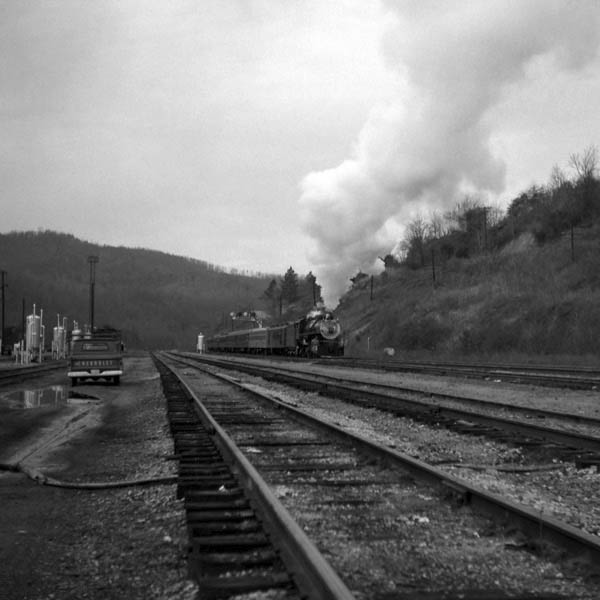
Oakdale, Tn / Nov 1968 / JCH
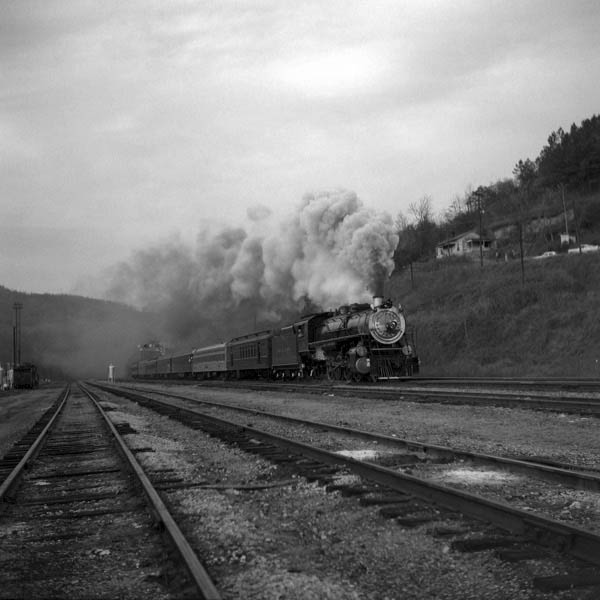
Oakdale, Tn / Nov 1968 / JCH

Southern Railway #4501
Oakdale, Tn / Nov 1968 / JCH

In 1968, after just two years of excursion service following her return to steam by Paul Merriman, 4501 went back to Stearns, Kentucky, and the Kentucky & Tennessee steam shop for an overhaul by the very men who had maintained her in coal service for a decade and a half. The overhaul completed, in November of that year 4501 made a ferry move down the Southern's "Rathole" Division, back to Chattanooga and the Tennessee Valley Railway Museum to prepare for a third excursion season. Dad caught the move at Oakdale, Tennessee, as it worked its way south, seven passenger cars in tow. While waiting for 4501 to arrive, he also caught the southbound Royal Palm and the daily "Spark Plug" — a hotshot frieght to Atlanta featuring parts used in automobile production.
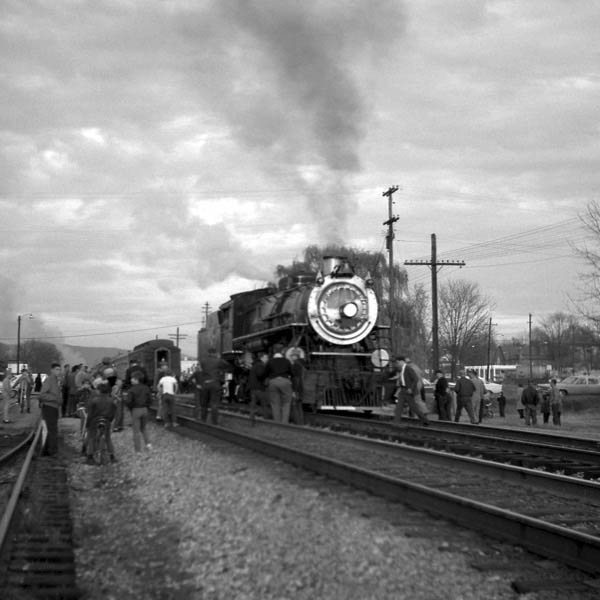
Chattanooga, Tn / Nov 1968 / JCH
1969
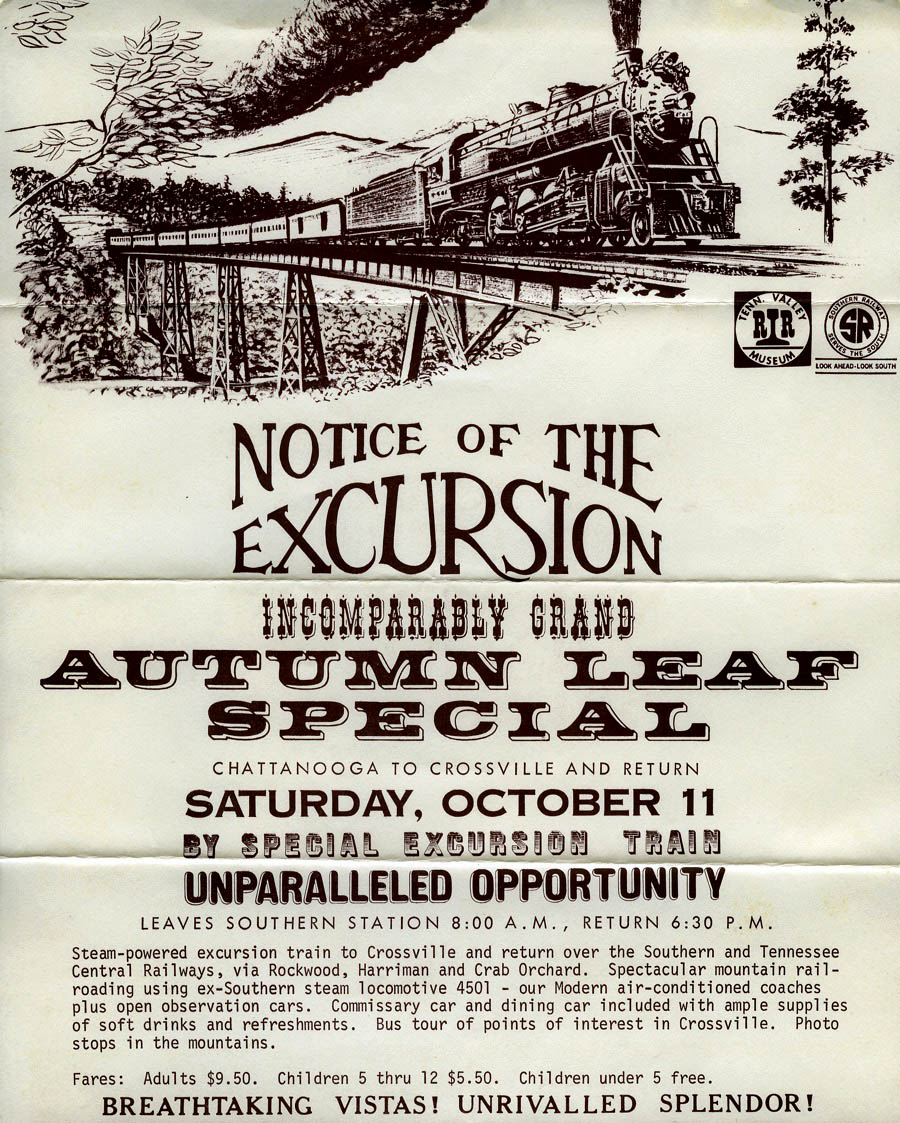
1969 promotional flyer / collection

See also our complete Tennessee Valley Railway Museum scrapbook in Preservation
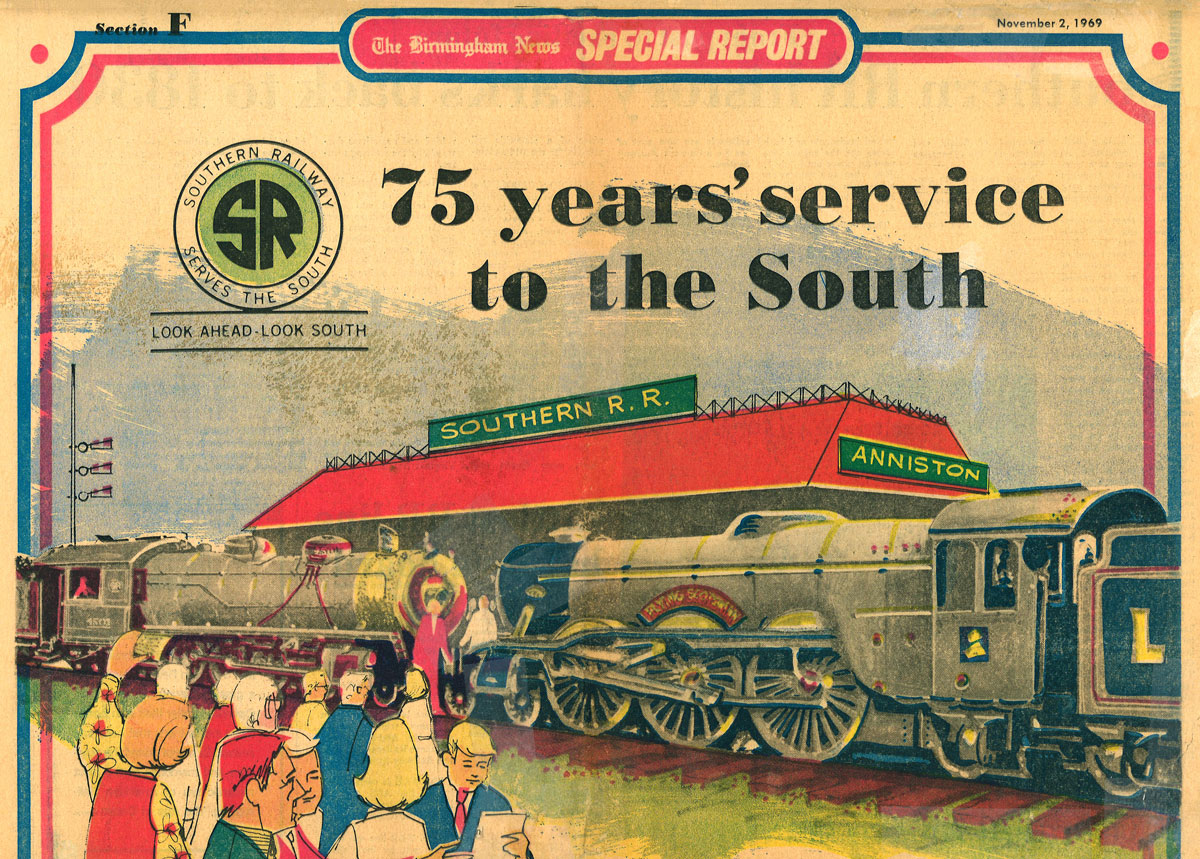
1969 newspaper clipping / collection
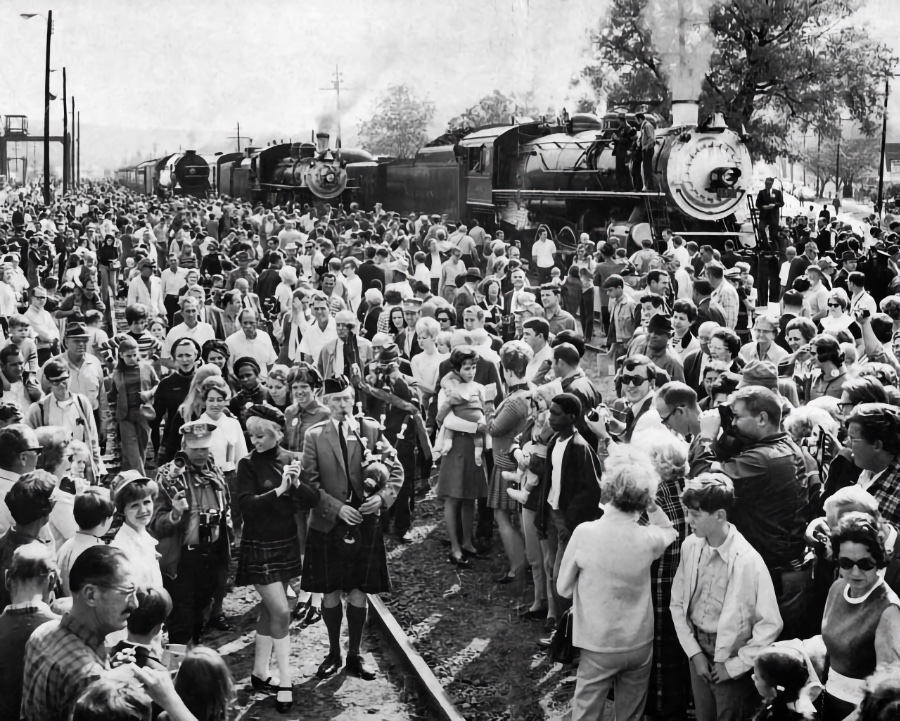
from Railroading
magazine #31 - Dec 1969 / collection
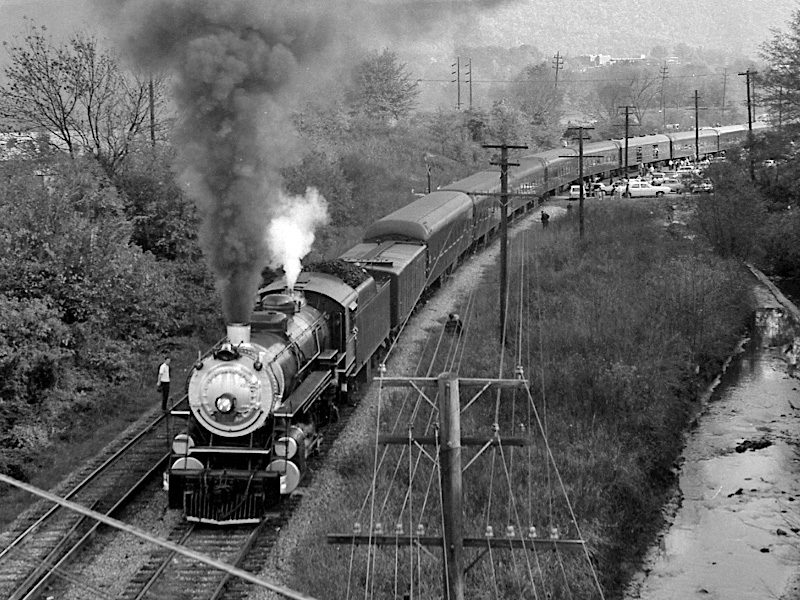
Anniston, Al / Nov 1969 / JCH
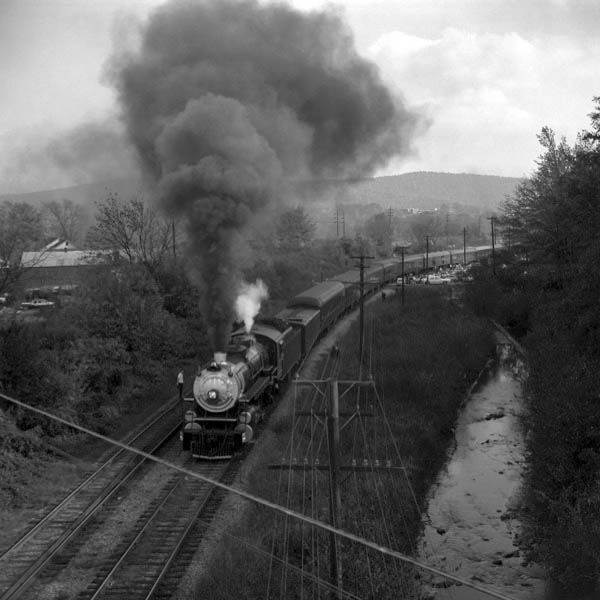
Anniston, Al / Nov 1969 / JCH
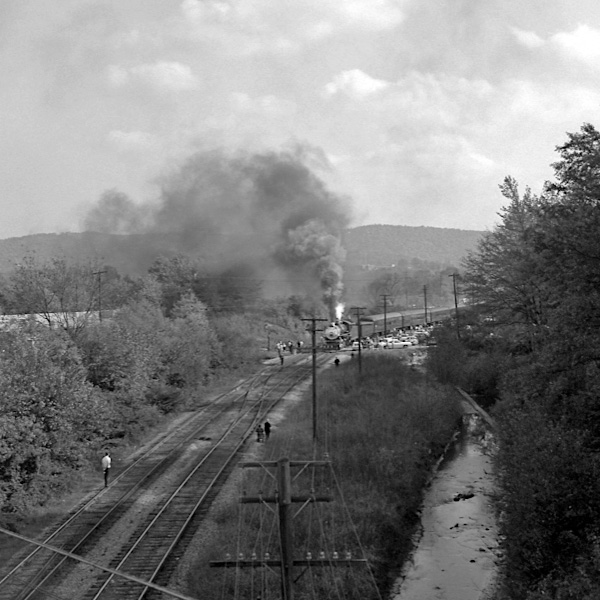
Anniston, Al / Nov 1969 / JCH
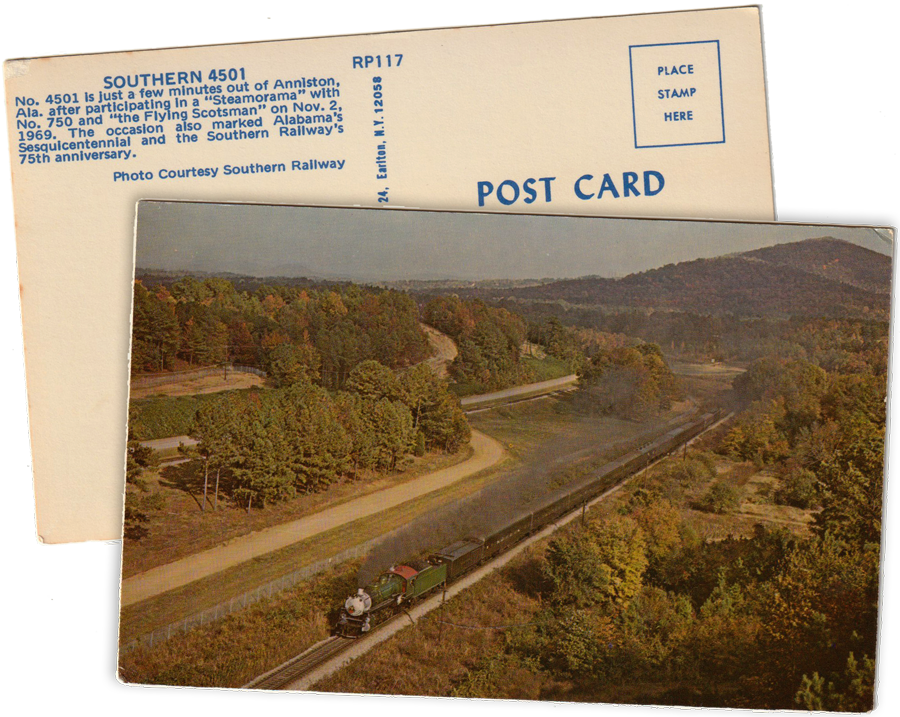

See also our complete Southern Railway 75th Anniversary scrapbook
1972

In the 1960s and 70s, a number of excursion trains were operated to and from Huntsville, Alabama, where we were living at the time. Many went to or came from Chattanooga, but other locations were used as well in relation to Huntsville. I always went down to the Huntsville depot to see the train before it left. Southern 4501 was almost always the power on the train, although on one occasion a back-to-back pair of E8s was used. But when 4501 was the locomotive, I always thought how well the 1859 Huntsville depot and the 1911 Baldwin locomotive looked together. On the occassions when the trips originated in Huntsville, there would always be a collection of passenger cars brought in during the week prior for use on the excursion train. I remember one time finding an ex Central of Georgia passenger car painted in Illinois Central colors (above), likely for use on the Seminole. Another time, Colonel Sanders of Kentucky Fried Chicken fame was down at the depot greeting people before boarding the train.
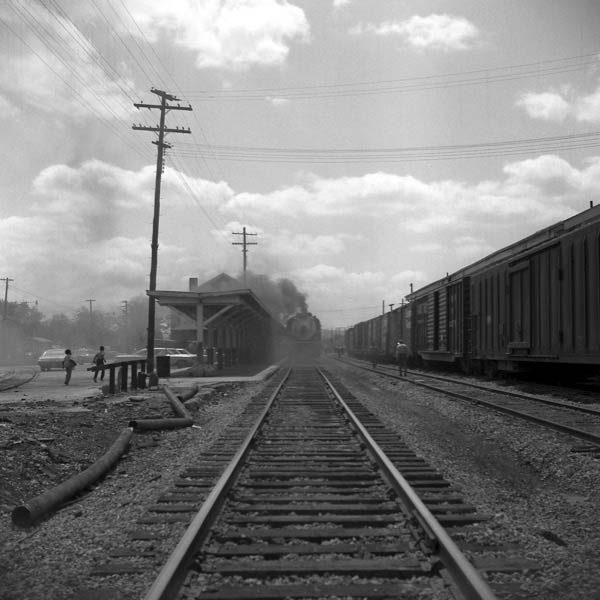
Huntsville, Al / Apr 1972 / JCH

Huntsville, Al / Apr 1972 / JCH
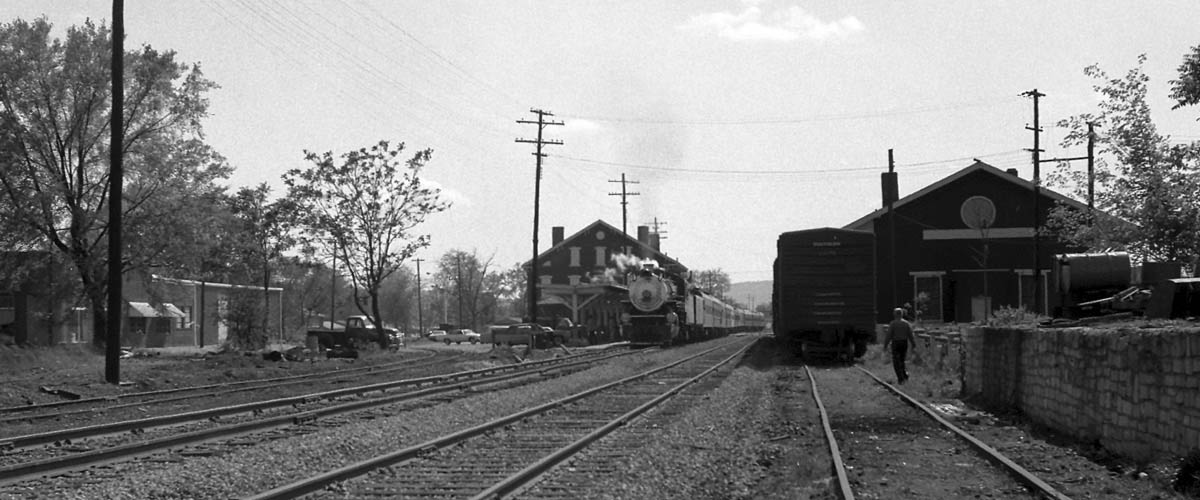
Huntsville, Al / Apr 1972 / JCH
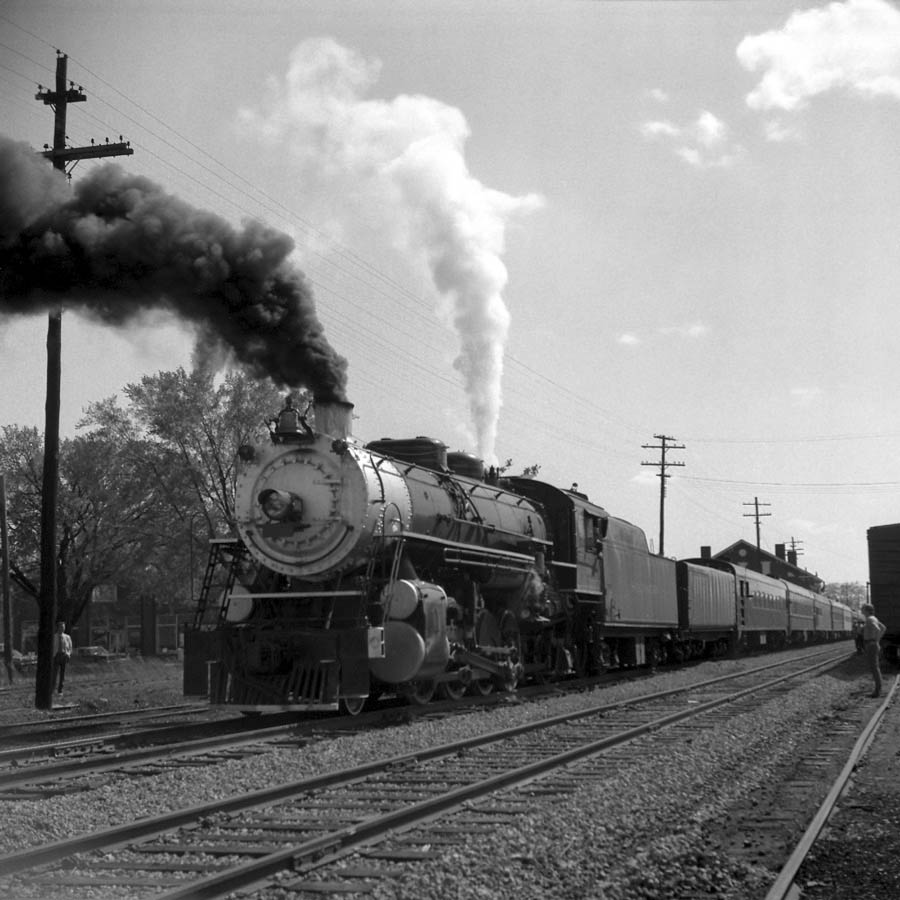
Huntsville, Al / Apr 1972 / JCH
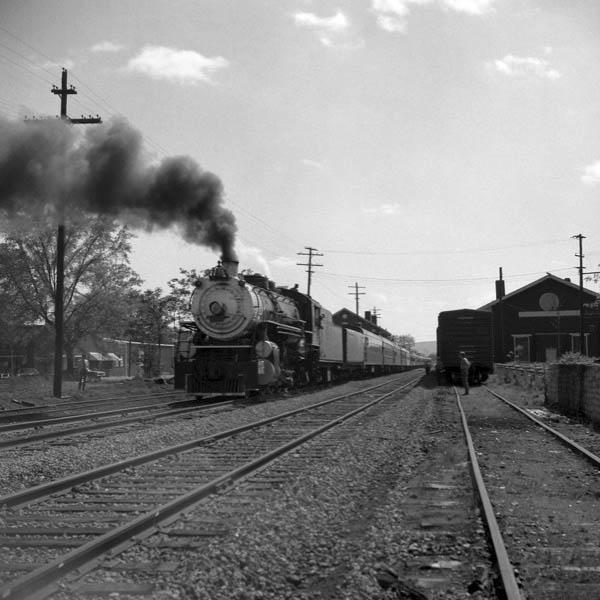
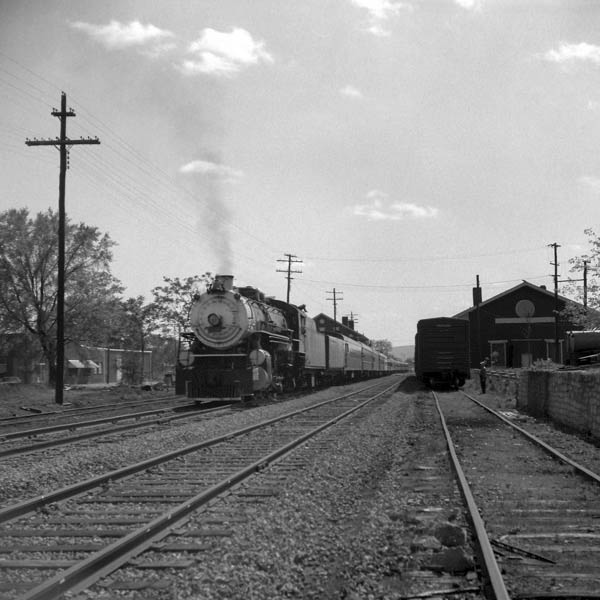
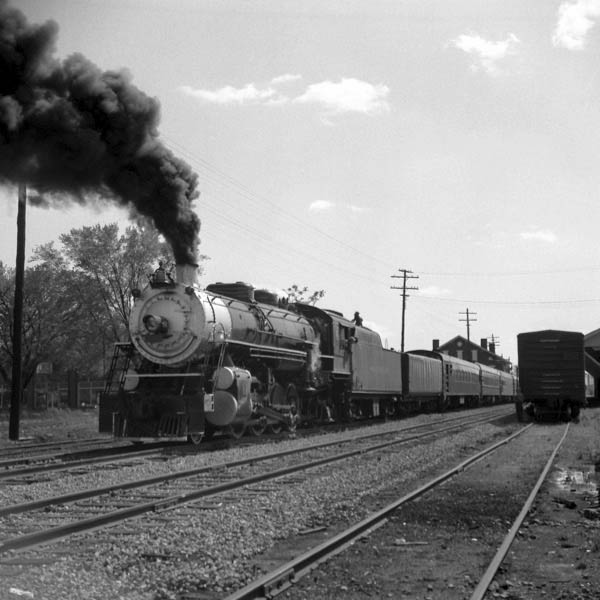
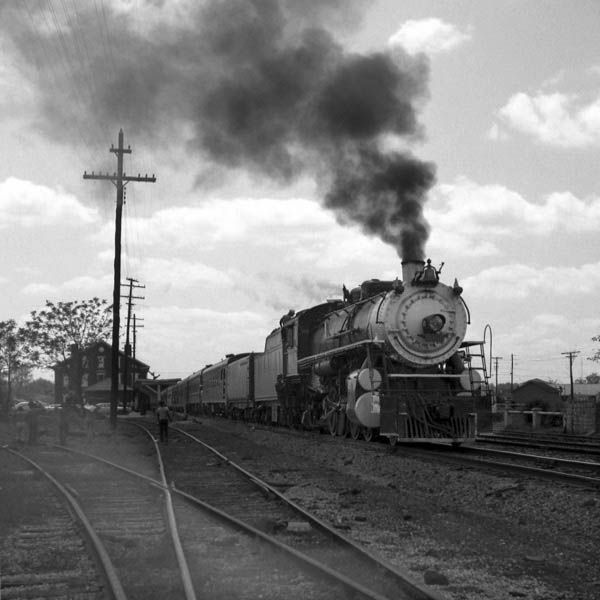
Huntsville, Al / Apr 1972 / JCH
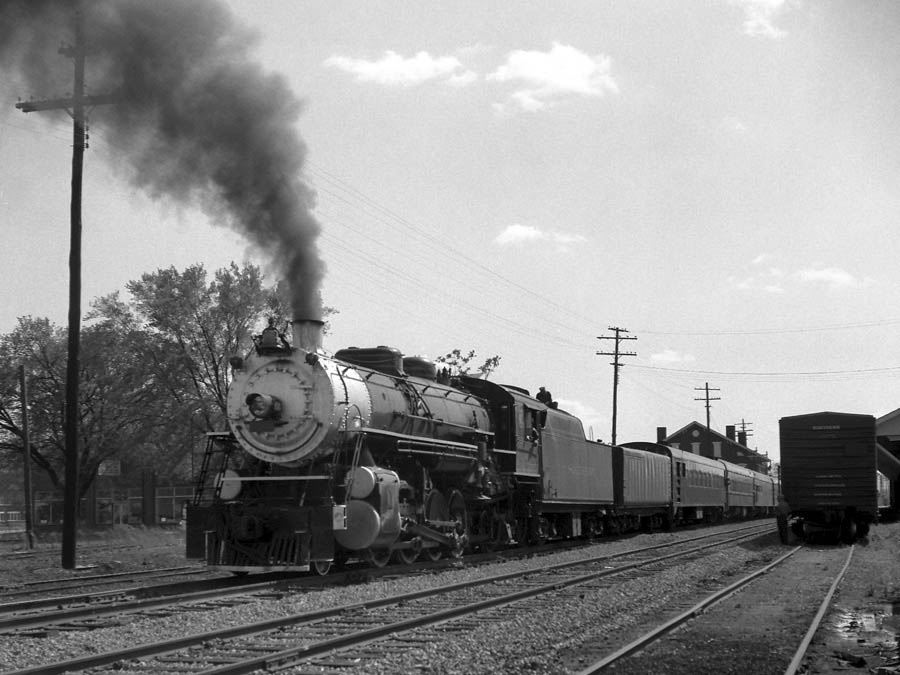
Huntsville, Al / Apr 1972 / JCH
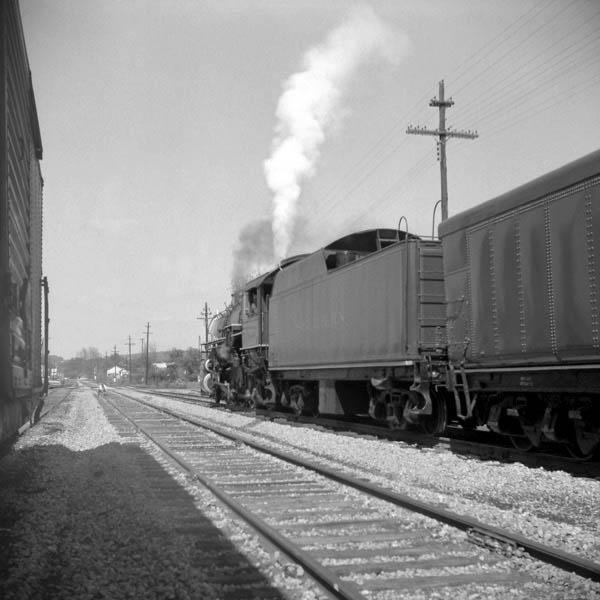
Huntsville, Al / Apr 1972 / JCH
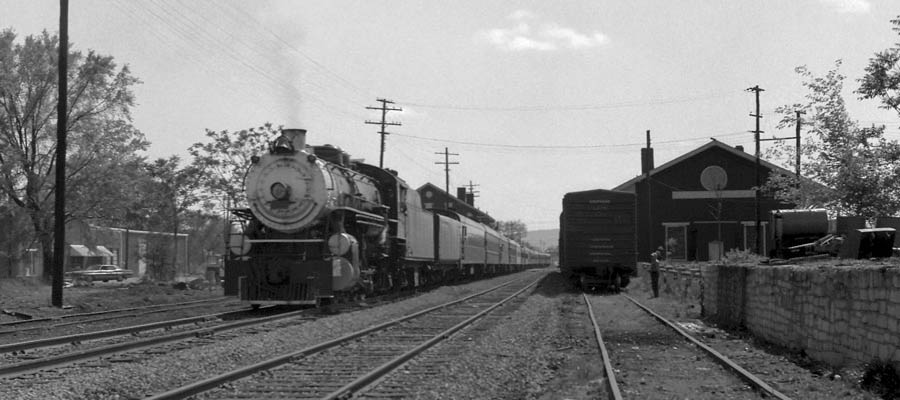
Huntsville, Al / Apr 1972 / JCH
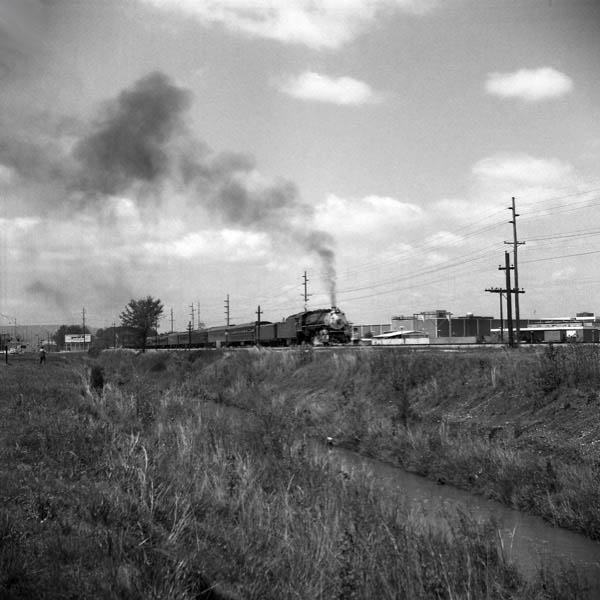
Huntsville, Al / Apr 1972 / JCH
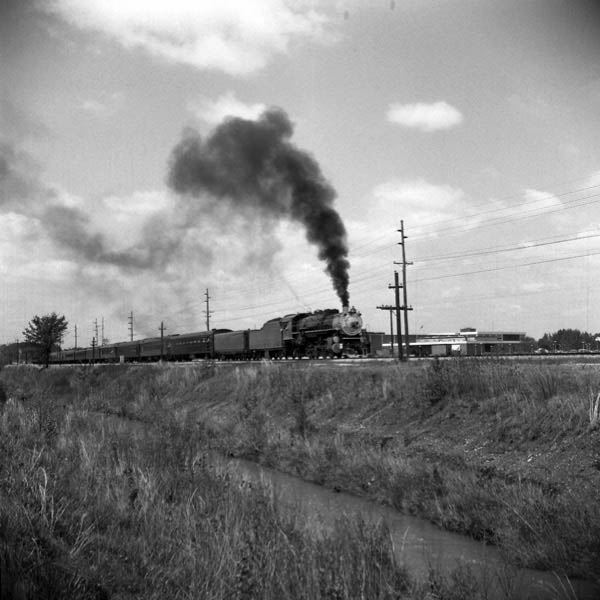
Huntsville, Al / Apr 1972 / JCH
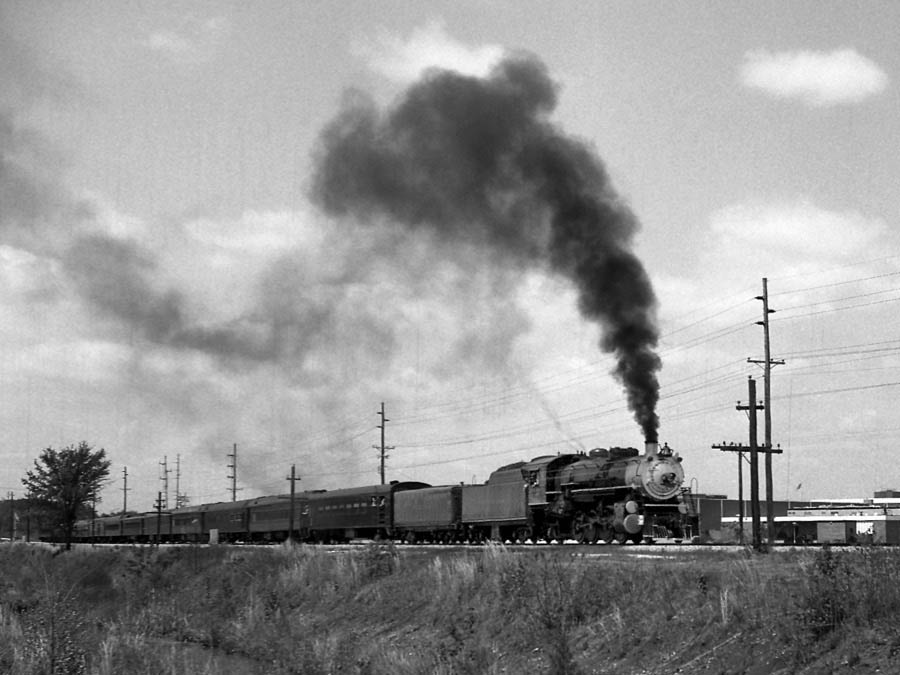
Huntsville, Al / Apr 1972 / JCH
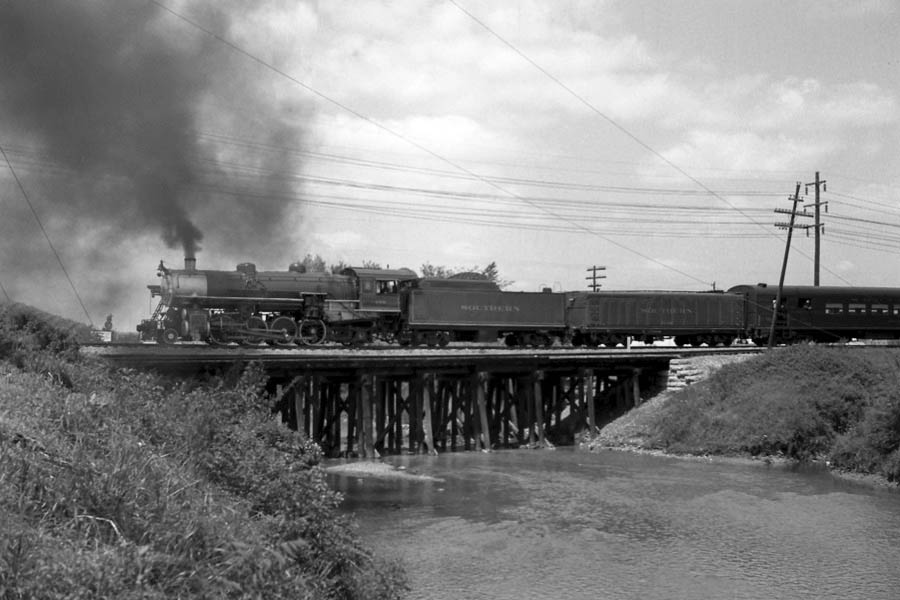
Huntsville, Al / Apr 1972 / JCH
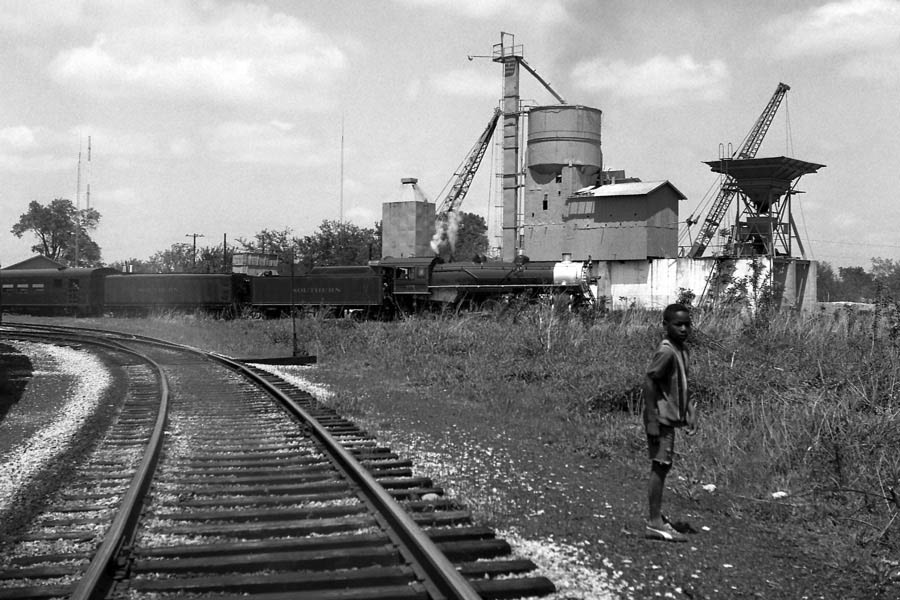
Huntsville, Al / Apr 1972 / JCH
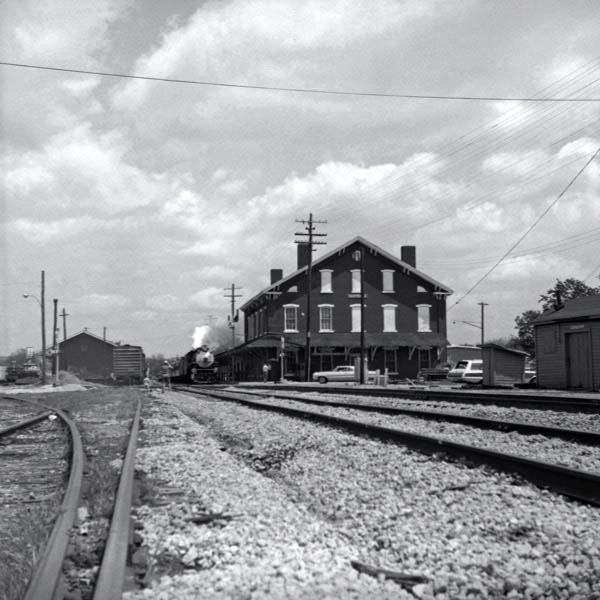
Huntsville, Al / Apr 1972 / JCH
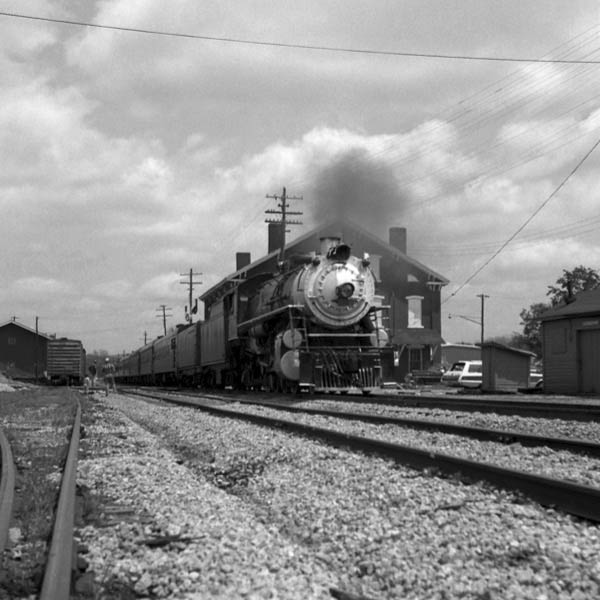
Huntsville, Al / Apr 1972 / JCH
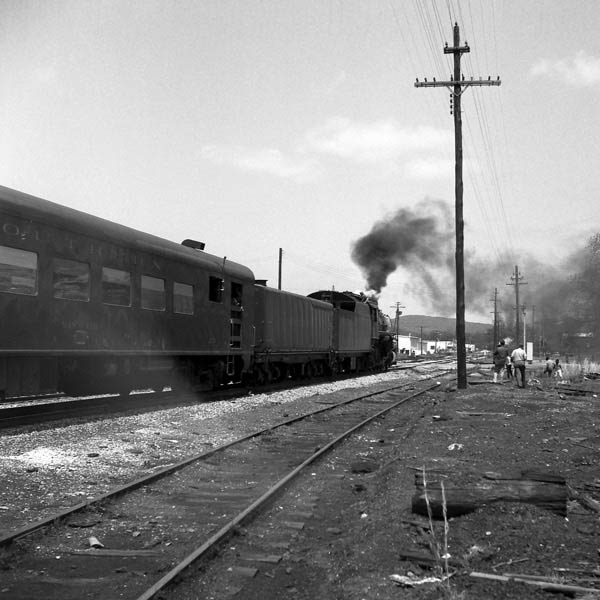
Huntsville, Al / Apr 1972 / JCH
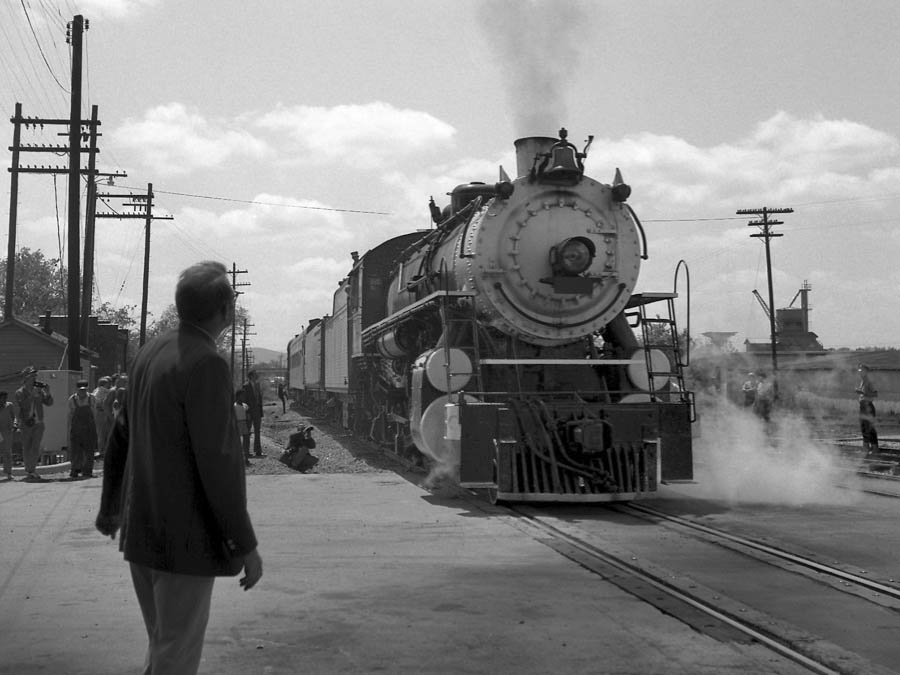
Huntsville, Al / Apr 1972 / JCH

Huntsville, Al / Apr 1972 / JCH

See also our complete Huntsville Historic Depot and Museum scrapbook in Preservation
1973

One Saturday in the fall of 1973, there was a trip on the Southern from Sheffield down to Haleyville, Alabama. We left Sheffield with the usual assortment of Southern fantrip equipment, including "Lookout Mountain" on the tail end. Two things I remember about this trip: people getting smoked on a bridge and a wreck alongside the track.
As we went southbound through Russellville, Alabama, we saw that 20 or 30 people had gathered on a wooden overpass to watch 4501 pass underneath. There was a grade on the line leading up to the overpass, and just as 4501 went under the bridge the fireman must have shoveled on some more coal. A great cloud of black smoke came up and completely enveloped the overpass. Our next view was of all the people frantically trying to fan out all the smoke!
On the return trip, there were numerous cars and trucks that drove along the side of the train on a highway. Included in the group was a fellow on a motorcycle. As cars are likely to do in bumper-to-bumper traffic, suddenly there was a quick stop in the line of people pacing the train. From my view on Lookout Mountain, I was looking right at the man on the motorcycle when he ran smack into the car ahead of him. As the front wheel of the bike hit the car's bumper, he flipped clean over the car and landed on its hood.
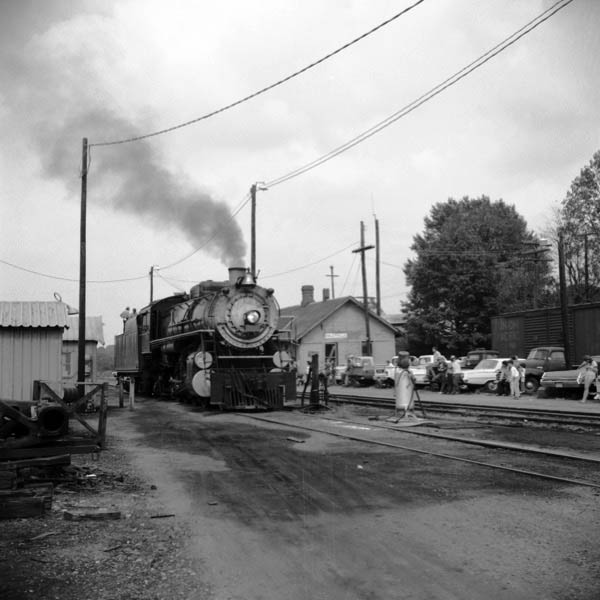
Haleyville, Al / Oct 1973 / JCH
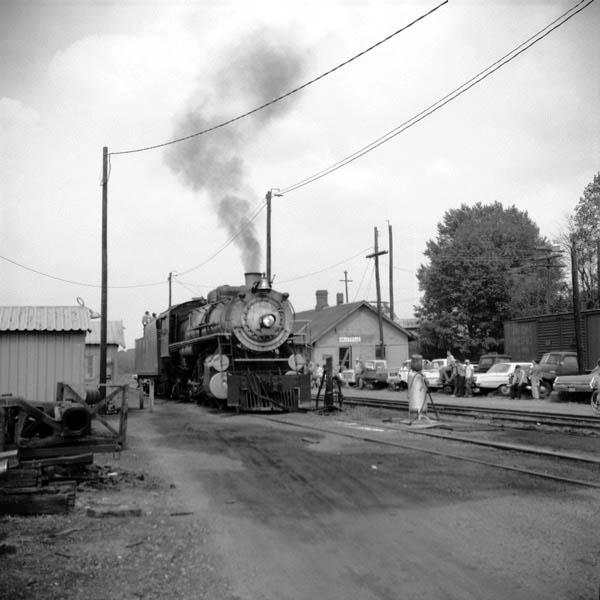
Haleyville, Al / Oct 1973 / JCH
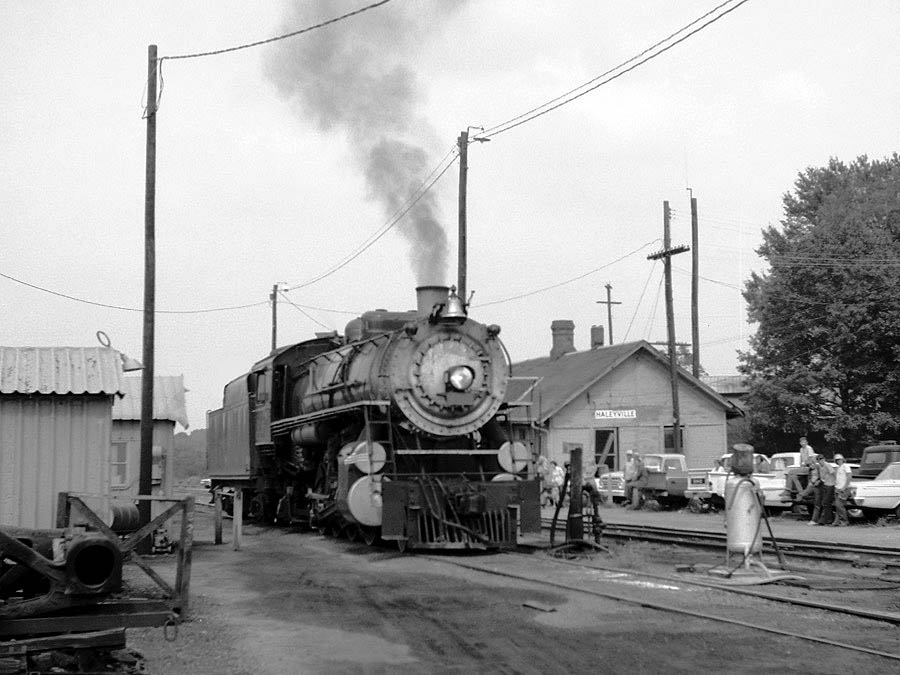
Haleyville, Al / Oct 1973 / JCH
1975
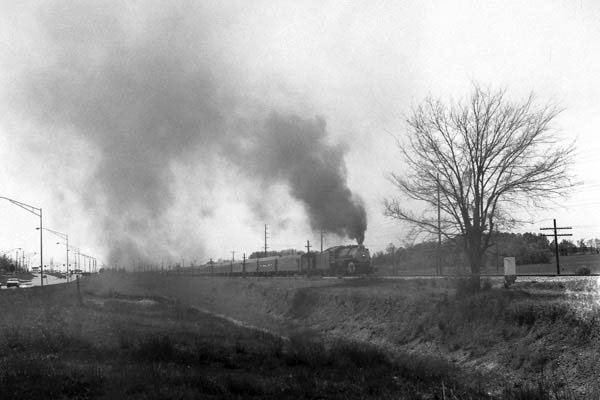
Huntsville, Al / Apr 1975 / JCH
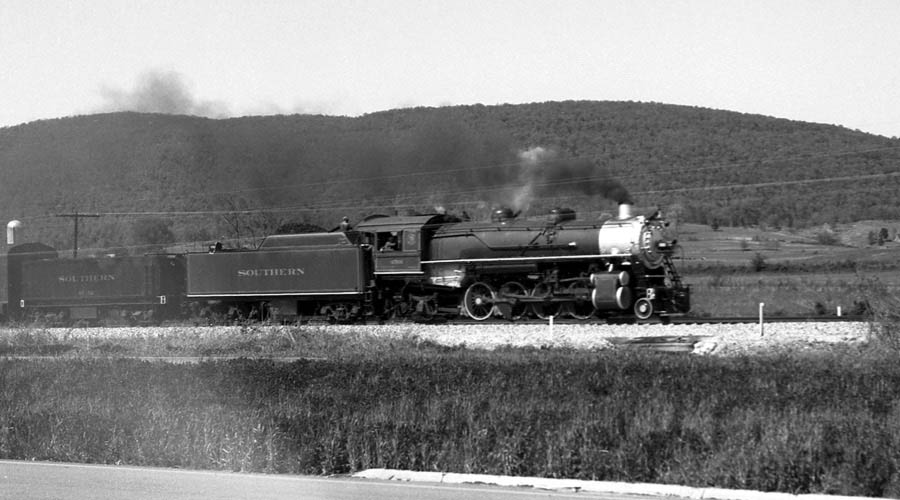
Huntsville, Al / Apr 1975 / JCH

Huntsville, Al / Apr 1975 / JCH

Huntsville, Al / Apr 1975 / JCH
1975

The Columbus Limited
One Saturday in 1975, Jack and I rode a round trip special that followed Southern passenger trains Nos. 11 and 12 — the old Birmingham to Columbus, Mississippi, locals. We left the old terminal station in Birmingham and took the old Georgia Pacific main out past Gorgas. There we stopped at the depot for some passengers. In the best Southern tradition, the conductor stepped off the car and set his yellow stool on the ground to help the passengers aboard! He even had a dark blue suit and a conductor's visor cap. What style!
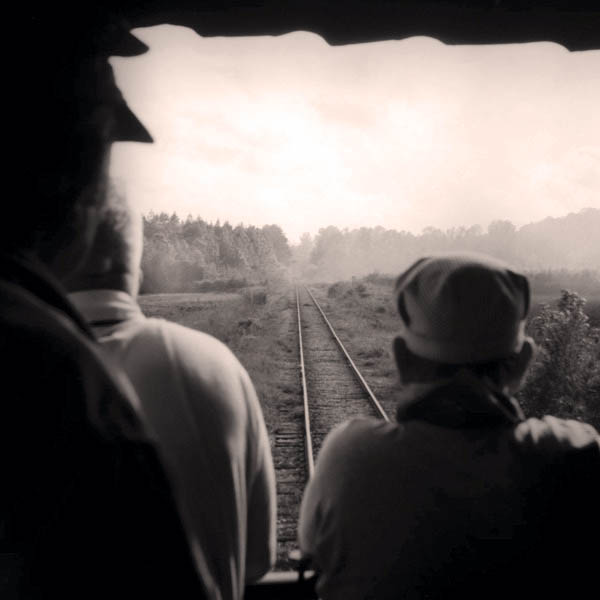 From there west to Columbus, the line was curvy and hilly with a 25 mph speed limit. 4501 had a day's work ahead of her! We were on the old Lookout Mountain car at the rear and so we could enjoy the scenery and hear 4501 work the grades. What a trip! The line was wooded most of the way with few signs of civilization anywhere. Somewhere east of Columbus we stopped for water, which was delivered via a local fire truck. We arrived in Columbus about 2 pm, several hours late, but who cared? The train was turned on the Columbus & Greenville Railway wye and 4501 was serviced at the C&G enginehouse. There were several hundred people in Columbus to watch all of this action. About 4 pm we whistled off for Birmingham, hours behind schedule. We finally arrived back at the station after midnight, about five hours late. For awhile en route it appeared the train crew would run out of legal time, but we made it back just before the limit. This trip was some rare mileage because portions of that line are no longer in existence — a year or so after the Southern merged with the Norfolk & Western, the Norfolk Southern abondoned most of it.
From there west to Columbus, the line was curvy and hilly with a 25 mph speed limit. 4501 had a day's work ahead of her! We were on the old Lookout Mountain car at the rear and so we could enjoy the scenery and hear 4501 work the grades. What a trip! The line was wooded most of the way with few signs of civilization anywhere. Somewhere east of Columbus we stopped for water, which was delivered via a local fire truck. We arrived in Columbus about 2 pm, several hours late, but who cared? The train was turned on the Columbus & Greenville Railway wye and 4501 was serviced at the C&G enginehouse. There were several hundred people in Columbus to watch all of this action. About 4 pm we whistled off for Birmingham, hours behind schedule. We finally arrived back at the station after midnight, about five hours late. For awhile en route it appeared the train crew would run out of legal time, but we made it back just before the limit. This trip was some rare mileage because portions of that line are no longer in existence — a year or so after the Southern merged with the Norfolk & Western, the Norfolk Southern abondoned most of it.
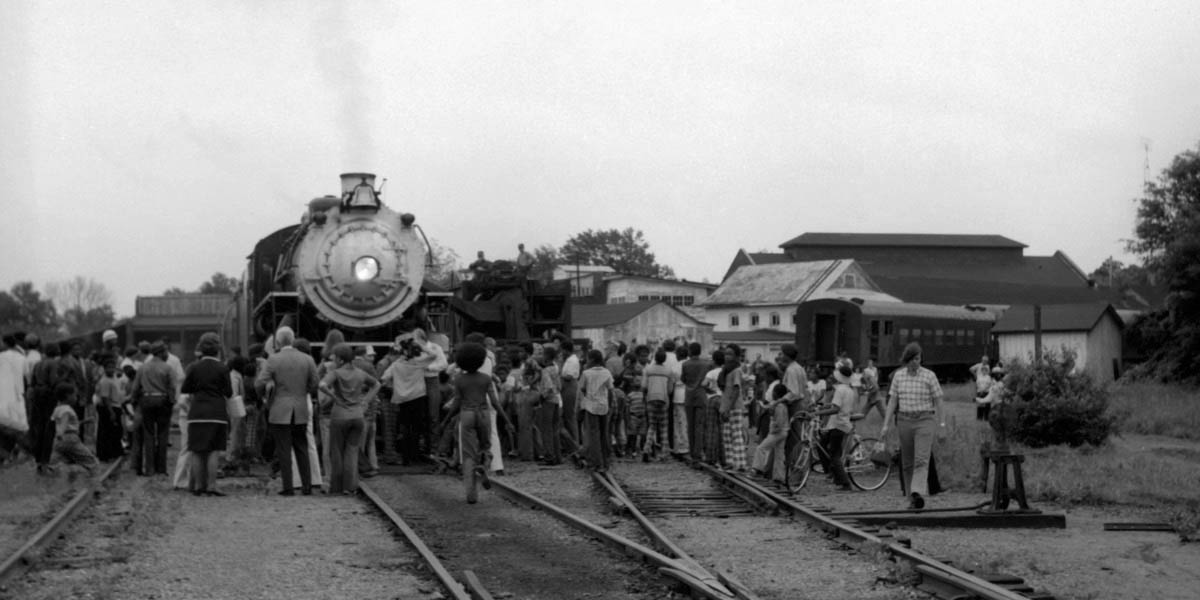
Columbus, Ms / May 1975 / JCH

Columbus, Ms / May 1975 / JCH
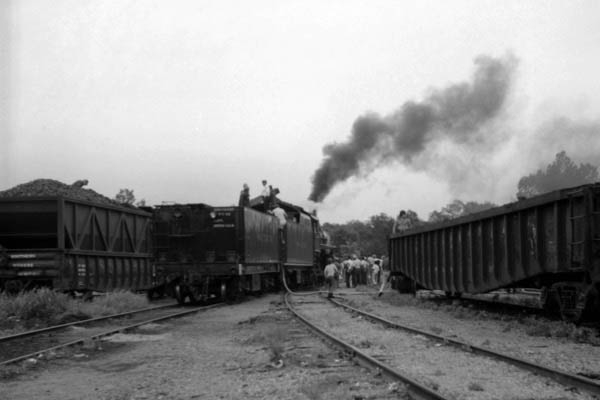
Columbus, Ms / May 1975 / JCH
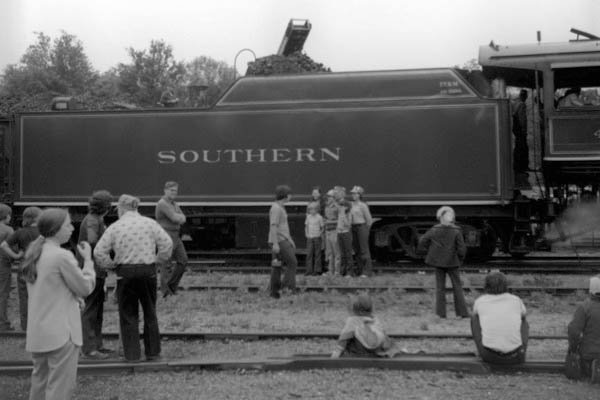
Columbus, Ms / May 1975 / JCH

Columbus, Ms / May 1975 / JCH

See also our complete Columbus & Greenville Railway premier scrapbook in Shortlines
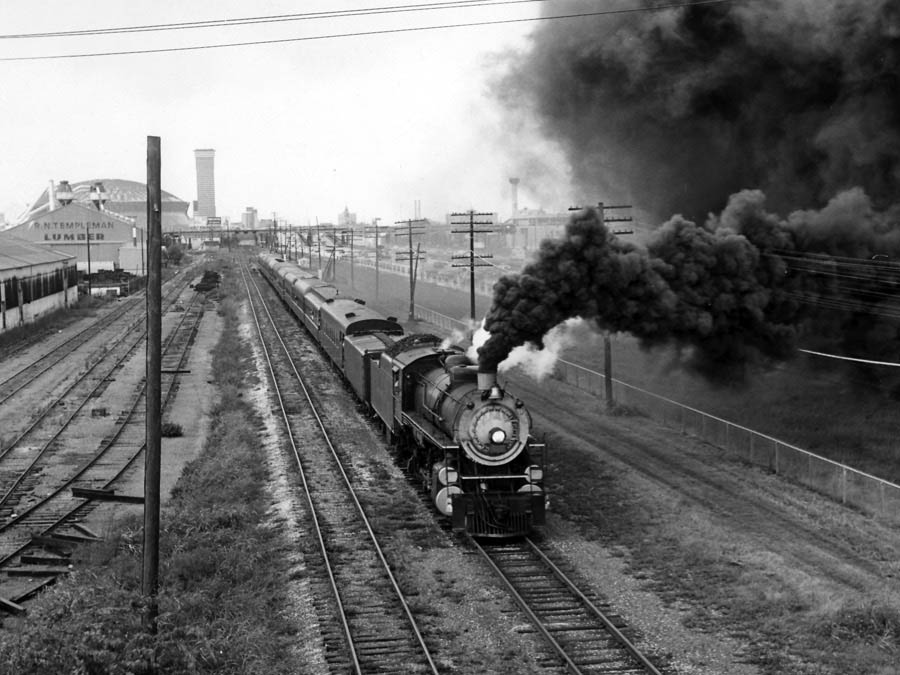
New Orleans, La / Nov 1975 / collection

New Orleans, La / Nov 1975 / collection
1977

New Orleans, La / Nov 1977 / Michael Palmieri collection
1978

Little Woods, La / Nov 1978 / collection

Little Woods, La / Nov 1978 / collection
1984
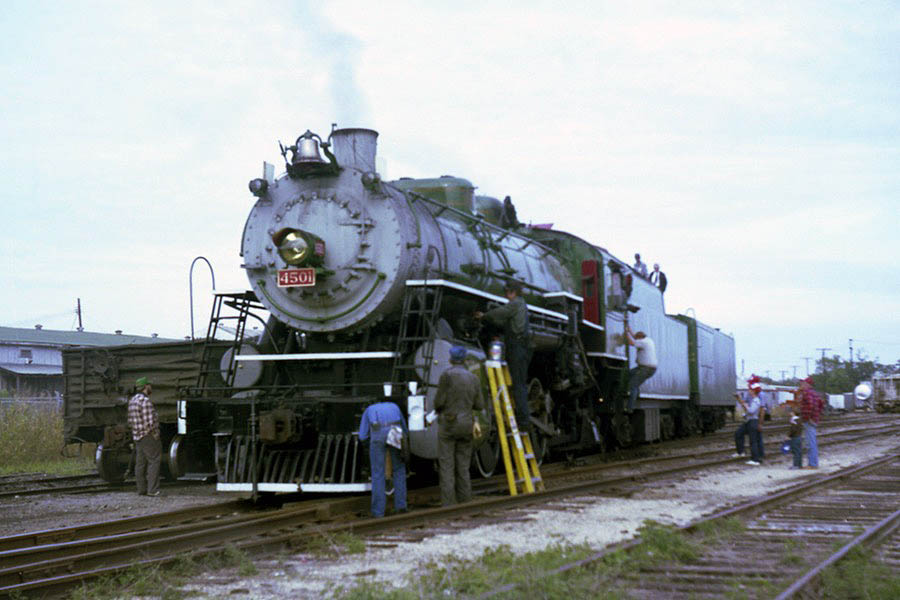
Hattiesburg, Ms / Nov 1984 / JCH
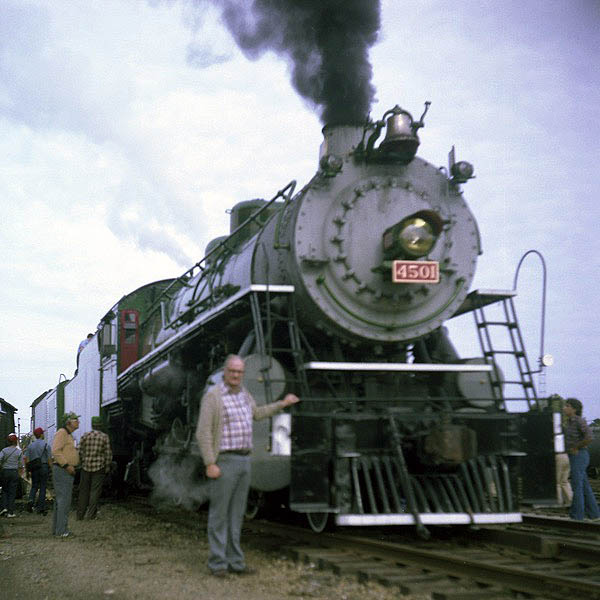
Hattiesburg, Ms / Nov 1984 / RWH
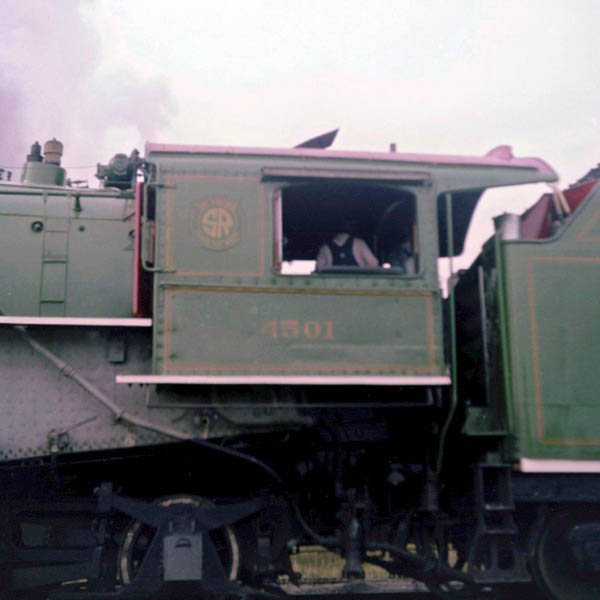
Hattiesburg, Ms / Nov 1984 / JCH

Hattiesburg, Ms / Nov 1984 / JCH
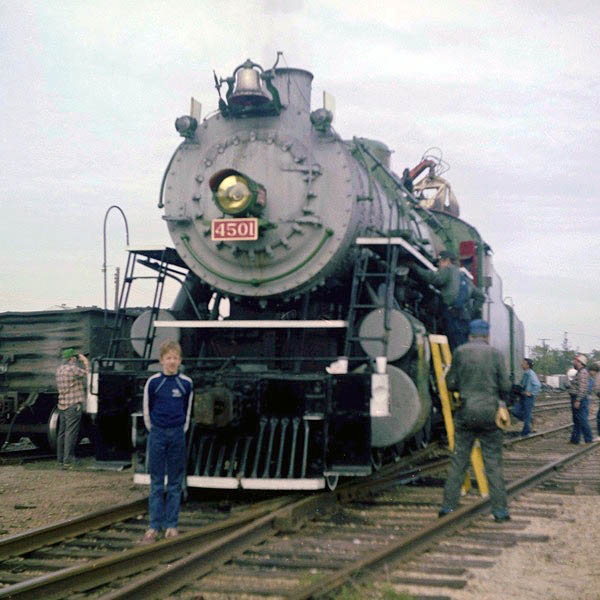
Hattiesburg, Ms / Nov 1984 / JCH
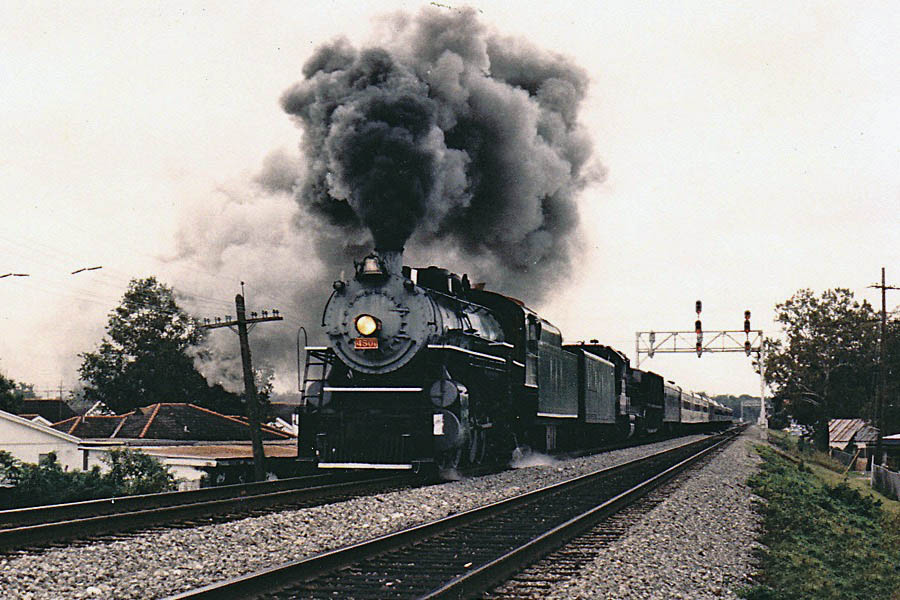
New Orleans, La / Nov 1984 / Michael Palmieri collection
1985
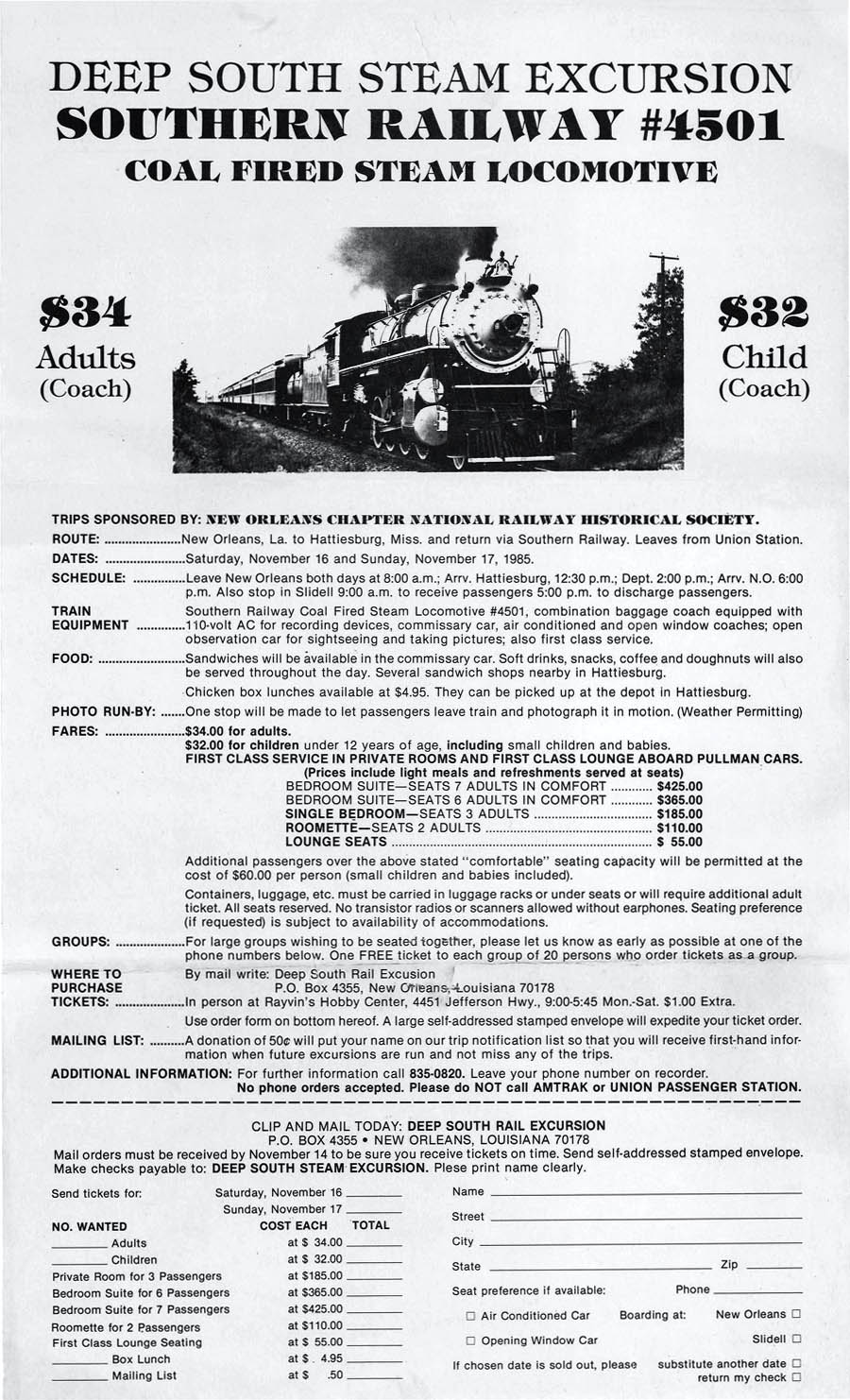
1985 promotional flyer / collection
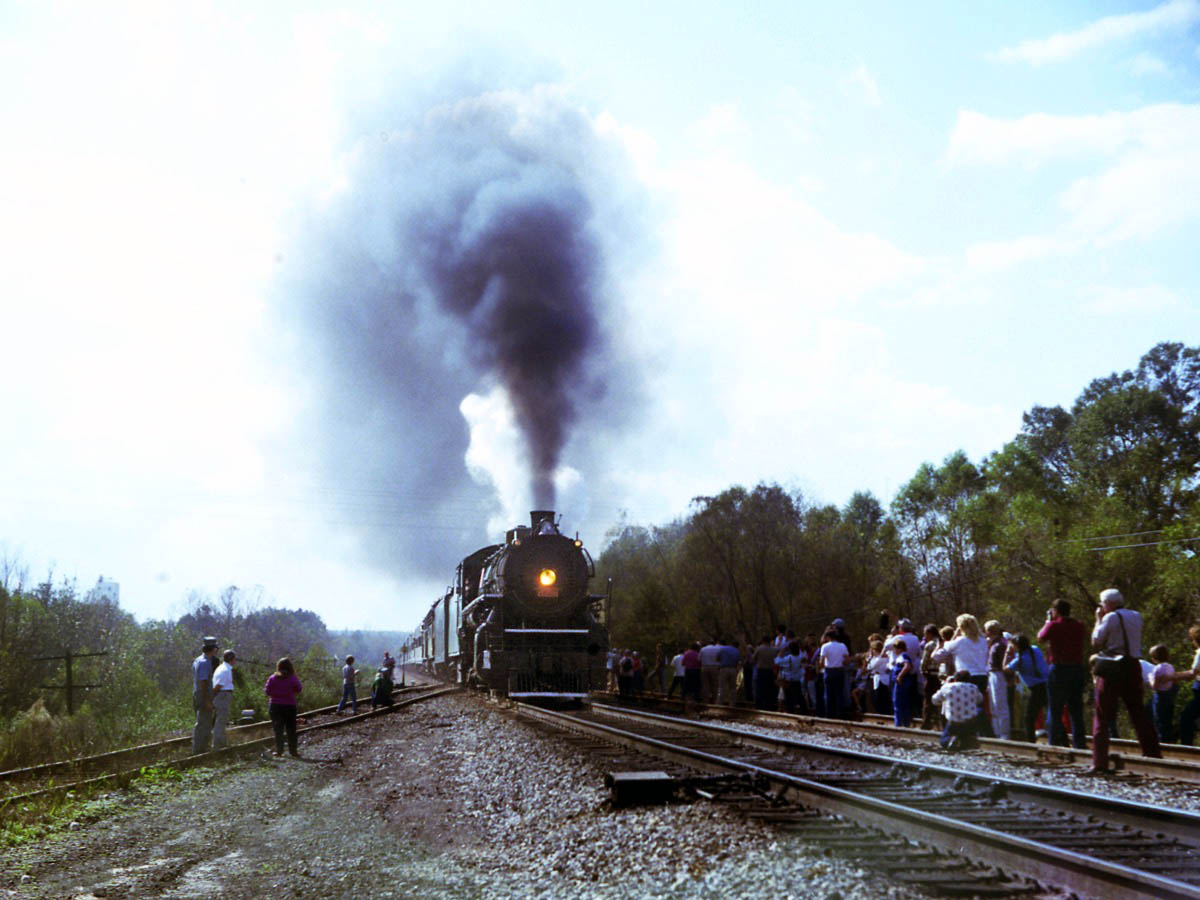
Purvis, Ms / Nov 1985 / JCH

Hattiesburg, Ms / Nov 1985 / JCH
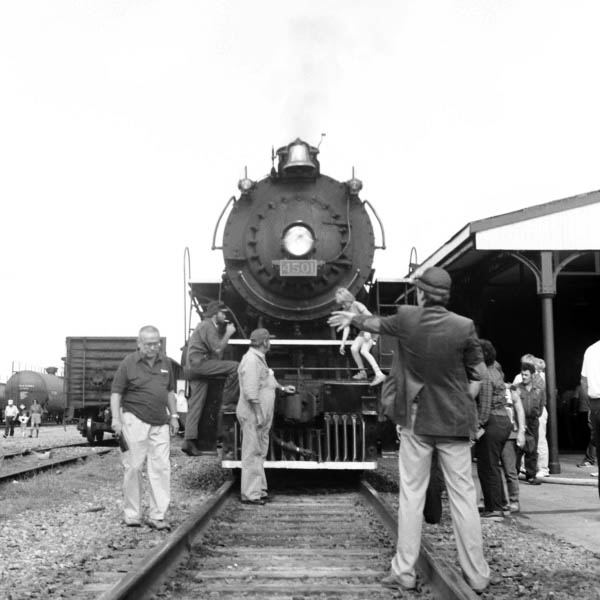
Hattiesburg, Ms / Nov 1985 / JCH
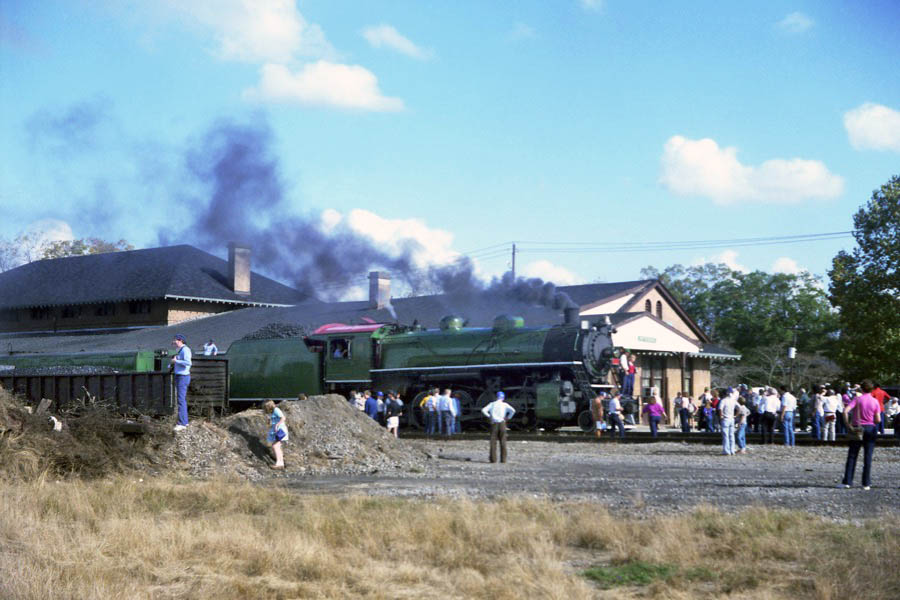
Hattiesburg, Ms / Nov 1985 / JCH

Slow and Steady Wins the Race
Usually our machines simply do what we build them to do.
But every now and then, they remind us how to live our lives.
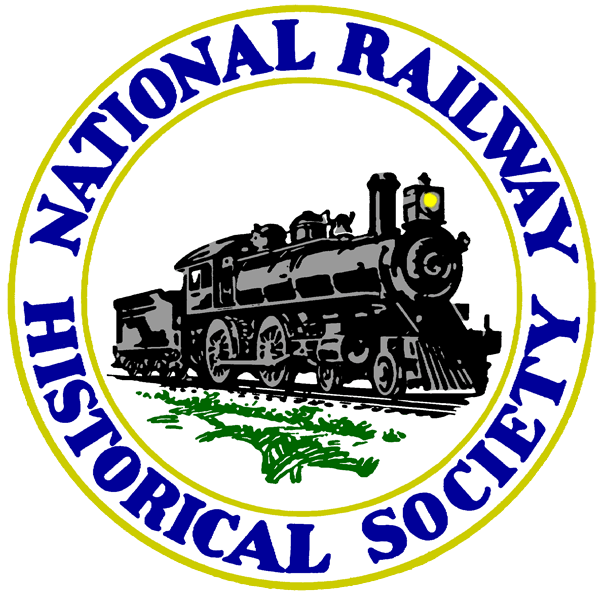 Throughout the 1970s and early 1980s, the New Orleans chapter of the National Railway Historical Society coordinated with the Southern Railway to operate annual steam excursions in the fall between New Orleans, Louisiana, and Hattiesburg, Mississippi — a 225 mile roundtrip. Like many in the hobby, I owe my deep love of railroading to my father, and during my adolescent years we greatly enjoyed our riding together on these wonderful day-long steam marathons. Indeed, these trips for me set the tone for all subsequent steam-riding adventures.
Throughout the 1970s and early 1980s, the New Orleans chapter of the National Railway Historical Society coordinated with the Southern Railway to operate annual steam excursions in the fall between New Orleans, Louisiana, and Hattiesburg, Mississippi — a 225 mile roundtrip. Like many in the hobby, I owe my deep love of railroading to my father, and during my adolescent years we greatly enjoyed our riding together on these wonderful day-long steam marathons. Indeed, these trips for me set the tone for all subsequent steam-riding adventures.
 Every November trip during the 1980s presented a challenge to its planners. The popularity of the voyage usually outweighed Southern's smaller excursion locomotives' more limited drawbar pull. I can remember arriving at New Orleans Union Passenger Terminal to find a train of coaches that seemed as long as 30 cars — too much for light Pacifics and Mikados in a solo role. As such, diesel-electric assistants were always called in for backing in those years. Sometimes this would be as ordinary as a GP38-2 (as in 1984 when #4501 was beset with bad coal), but on several occasions, two of the green "Heritage" FP7's played the necessary second fiddle to the celebrity steamer.
Every November trip during the 1980s presented a challenge to its planners. The popularity of the voyage usually outweighed Southern's smaller excursion locomotives' more limited drawbar pull. I can remember arriving at New Orleans Union Passenger Terminal to find a train of coaches that seemed as long as 30 cars — too much for light Pacifics and Mikados in a solo role. As such, diesel-electric assistants were always called in for backing in those years. Sometimes this would be as ordinary as a GP38-2 (as in 1984 when #4501 was beset with bad coal), but on several occasions, two of the green "Heritage" FP7's played the necessary second fiddle to the celebrity steamer.
 The tickets my father would purchase for us secured two seats in one of the old heavyweight coaches, but we were never found there. We preferred the tail end of the movement, always claiming a spot in "Lookout Mountain" — the steam program's beloved open observation car that racked up thousands of excursion miles over the decades. From its spacious rear platform, this young kid watched many a mile slip away along the Southern's pristine, all-welded Crescent Division, traveling northeast from NOLA. Lookout Mountain turned out to be the locale for one of my most vivid childhood memories.
The tickets my father would purchase for us secured two seats in one of the old heavyweight coaches, but we were never found there. We preferred the tail end of the movement, always claiming a spot in "Lookout Mountain" — the steam program's beloved open observation car that racked up thousands of excursion miles over the decades. From its spacious rear platform, this young kid watched many a mile slip away along the Southern's pristine, all-welded Crescent Division, traveling northeast from NOLA. Lookout Mountain turned out to be the locale for one of my most vivid childhood memories.
 It was the 1985 trip, featuring the much-loved #4501. During the lunch break in Hattiesburg, the crews turned the Mike on a nearby wye for the southbound flight home. Meanwhile, my father and I managed to gulp down the greasy box lunches that came with our tickets ... a meal always too cold and too meager. Soon the classy FP7's took there place in front of Man O' War (another well known excursion car, always at the head end on New Orleans trips). After brake tests, the 4501 once again took her rightful place on the lead. Dad and I hustled our way back to our favorite spot on the rear of the train, and with our comrades in the hobby waited for our collective departure.
It was the 1985 trip, featuring the much-loved #4501. During the lunch break in Hattiesburg, the crews turned the Mike on a nearby wye for the southbound flight home. Meanwhile, my father and I managed to gulp down the greasy box lunches that came with our tickets ... a meal always too cold and too meager. Soon the classy FP7's took there place in front of Man O' War (another well known excursion car, always at the head end on New Orleans trips). After brake tests, the 4501 once again took her rightful place on the lead. Dad and I hustled our way back to our favorite spot on the rear of the train, and with our comrades in the hobby waited for our collective departure.
Now this is what I remember: The heavy man next to me, weighed down with multiple cameras and also smelling of box lunch chicken, happened to have a radio scanner clipped to his generous belt. Suddenly it crackled to life. My young ears tuned in with great interest. It seemed the head end crew was experiencing a moment of spontaneity. "How about we let 4501 get us underway?" asked the engineer. A pregnant silence followed. The boss of the FP7's broke in with what seemed like hesitant agreement. The conductor's voice came next. His, the final word. Apparently he had no opinion on the matter, except that it was time to get underway. "Highball 4501."
 My mind was electric. No one had to explain any of this to me. I knew exactly what all this railroad chatter meant. The classy little Mikado we all loved was being handed a great challenge: 16 over worn heavyweights, all loaded to the gills with railfan fathers and sons like us, and a few patient wives. This was to be a superlative moment.
Feeling as though I had just broken the Enigma code, I quickly tugged at my father's sleeve. I felt he just had to know this news before any one else. No sooner had I finished uploading the information when we heard a whistle. Two breathy blasts from afar signaled the start of the fight.
As the slack ran out and the drawbar tightened, the whole train lurched. Everyone was immediately quiet. In the absence of Lookout Mountain chatter, what I already knew now became clear to others: No EMD prime movers could be heard getting underway; only the deep, throaty chug of a Baldwin stack drifted back to our ears.
Inches turned to feet, each one a victory. Feet became yards, and slowly the old city of Hattiesburg began passing us by. But still no noise that resembled FP7s. The message was now clear to all concerned: We were starting on our way home, with no help yet from anything that ran on diesel oil. It did not take long for our forward motion to apogee, a velocity I imagined to be no more than 8-10 miles per hour. Paul Merriam's old machine had managed to get this heavy train underway, all by herself.
My mind was electric. No one had to explain any of this to me. I knew exactly what all this railroad chatter meant. The classy little Mikado we all loved was being handed a great challenge: 16 over worn heavyweights, all loaded to the gills with railfan fathers and sons like us, and a few patient wives. This was to be a superlative moment.
Feeling as though I had just broken the Enigma code, I quickly tugged at my father's sleeve. I felt he just had to know this news before any one else. No sooner had I finished uploading the information when we heard a whistle. Two breathy blasts from afar signaled the start of the fight.
As the slack ran out and the drawbar tightened, the whole train lurched. Everyone was immediately quiet. In the absence of Lookout Mountain chatter, what I already knew now became clear to others: No EMD prime movers could be heard getting underway; only the deep, throaty chug of a Baldwin stack drifted back to our ears.
Inches turned to feet, each one a victory. Feet became yards, and slowly the old city of Hattiesburg began passing us by. But still no noise that resembled FP7s. The message was now clear to all concerned: We were starting on our way home, with no help yet from anything that ran on diesel oil. It did not take long for our forward motion to apogee, a velocity I imagined to be no more than 8-10 miles per hour. Paul Merriam's old machine had managed to get this heavy train underway, all by herself.
 My budding railfan imagination was now in full cutoff, working hard. Understand: Southern's 4501 had held in my callow mind the status of true hero for some time. To be sure, I was raised a Presbyterian, therefore taught well the dangers of idolatry. But this little Baldwin was a true temptress. My many indiscretions were obvious: I had memorized David Morgan's book. I was the only kid in my middle school who knew who Walter Dove was. I could recite light Mikado statistics to anyone who asked. (Painfully, no one ever did.)
Given this adoration, I understood well that this feat now taking place before me was perhaps more than her Baldwin designers ever imagined, at least at her age. Even from the tail end of the train, my mind's eye could see every aspect her effort: Eight 44" drivers "digging in", Walscherts gear at full cutoff, sand coming down like rain. I could picture her fireman shoveling hard; her engineer, poised, simply hoping for one good grip after another.
I had to imagine all of these sights, but I could feel their results. For what seemed like many a slow mile, as the city of Hattiesburg gave way bit by bit to Mississippi piney woods, the little Mike did her thing, and did it well. Nothing fancy, mind you. No speed to thrill a dynameter chart. No J class ease. But we were on our way, by golly. Sixteen or more coaches and two idled EMDs inching down the line. And just like me, those covered wagons were merely passengers on this ride. Their reversers in neutral, while the steam kettle they replaced slowly and steadily took care of business.
My budding railfan imagination was now in full cutoff, working hard. Understand: Southern's 4501 had held in my callow mind the status of true hero for some time. To be sure, I was raised a Presbyterian, therefore taught well the dangers of idolatry. But this little Baldwin was a true temptress. My many indiscretions were obvious: I had memorized David Morgan's book. I was the only kid in my middle school who knew who Walter Dove was. I could recite light Mikado statistics to anyone who asked. (Painfully, no one ever did.)
Given this adoration, I understood well that this feat now taking place before me was perhaps more than her Baldwin designers ever imagined, at least at her age. Even from the tail end of the train, my mind's eye could see every aspect her effort: Eight 44" drivers "digging in", Walscherts gear at full cutoff, sand coming down like rain. I could picture her fireman shoveling hard; her engineer, poised, simply hoping for one good grip after another.
I had to imagine all of these sights, but I could feel their results. For what seemed like many a slow mile, as the city of Hattiesburg gave way bit by bit to Mississippi piney woods, the little Mike did her thing, and did it well. Nothing fancy, mind you. No speed to thrill a dynameter chart. No J class ease. But we were on our way, by golly. Sixteen or more coaches and two idled EMDs inching down the line. And just like me, those covered wagons were merely passengers on this ride. Their reversers in neutral, while the steam kettle they replaced slowly and steadily took care of business.
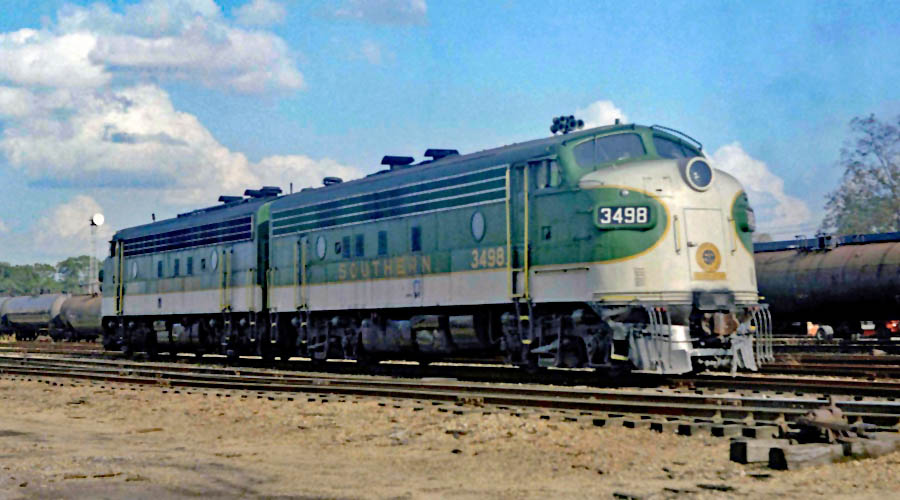 The end of this promethean struggle for acceleration was soon signaled by another crackle on my neighbor's revelatory speaker. "Engineer 4501 to engineer 3497, how about some help now?"
At least, that's what I remember he said. Two blasts from a Nathan 5-chime were quickly followed by the unmistakable resonance of 567 prime movers finally getting dressed for work. Another lurch — this time a little stronger — and the clickety-clacks soon picked up in rhythm, the way a jazz trio gets its thing together. We were taking on speed, quickly now, making our way back home to New Orleans with a little help from the Electro-Motive Division. Sheer steam determination had, I suppose by necessity, given way to diesel-electric ease.
The end of this promethean struggle for acceleration was soon signaled by another crackle on my neighbor's revelatory speaker. "Engineer 4501 to engineer 3497, how about some help now?"
At least, that's what I remember he said. Two blasts from a Nathan 5-chime were quickly followed by the unmistakable resonance of 567 prime movers finally getting dressed for work. Another lurch — this time a little stronger — and the clickety-clacks soon picked up in rhythm, the way a jazz trio gets its thing together. We were taking on speed, quickly now, making our way back home to New Orleans with a little help from the Electro-Motive Division. Sheer steam determination had, I suppose by necessity, given way to diesel-electric ease.
 As a Presbyterian minister now, I find I mostly view this life as a gift of immense grace to be received and shared, not so much a thing to be conquered through sheer will or dogged grit. But even a crack theologian can concede that every now and then gritty determination has its place among the virtues. And what's more, sometimes even our machines teach us the dignity of staying in the fight.
As a Presbyterian minister now, I find I mostly view this life as a gift of immense grace to be received and shared, not so much a thing to be conquered through sheer will or dogged grit. But even a crack theologian can concede that every now and then gritty determination has its place among the virtues. And what's more, sometimes even our machines teach us the dignity of staying in the fight.
Can staybolts and seams be our heroes? Does a boiler with brakes posses a will? I'm not sure. Is my memory of these moments a bit puffy with time? The details, distended in hindsight? Perhaps. But in my childhood memory there remain a handful of charmed minutes when an outclassed little steamer bravely took on weighty odds … and persevered.
"Slow and steady wins the race," said the tortoise to the hare.
Slow and steady indeed.
written by RWH for the Blue Ridge Chapter NRHS newsletter, 2005
1993
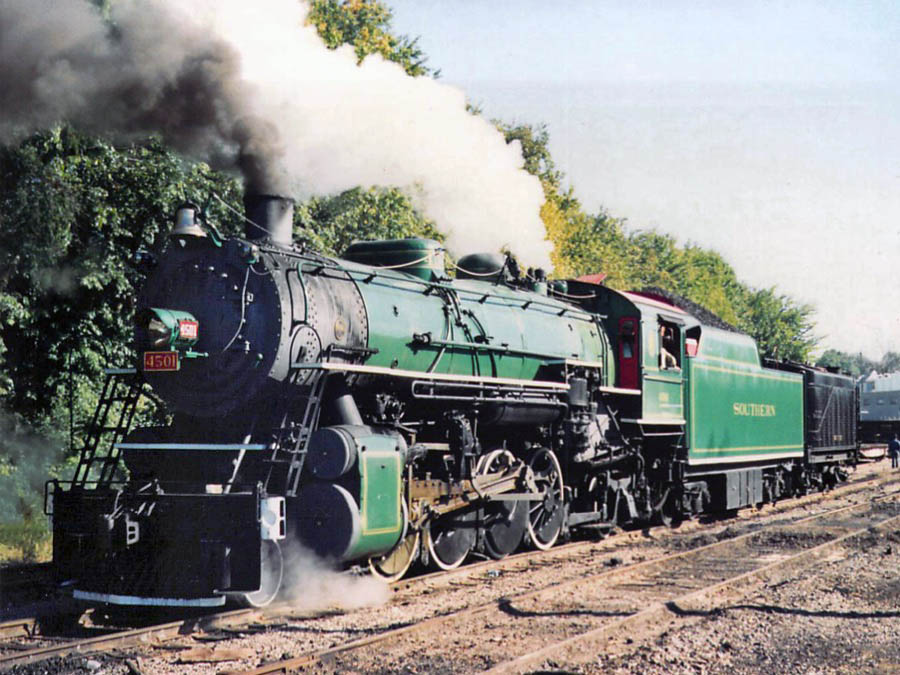
Bristol, Va / Oct 1993 / RWH
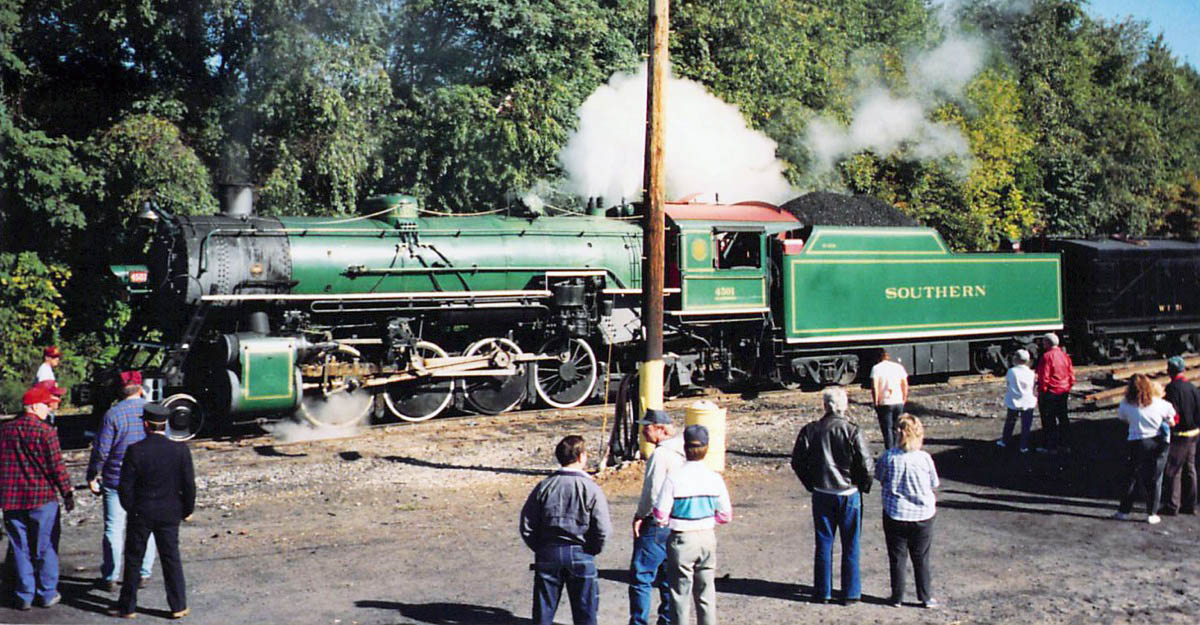
Bristol, Va / Oct 1993 / RWH
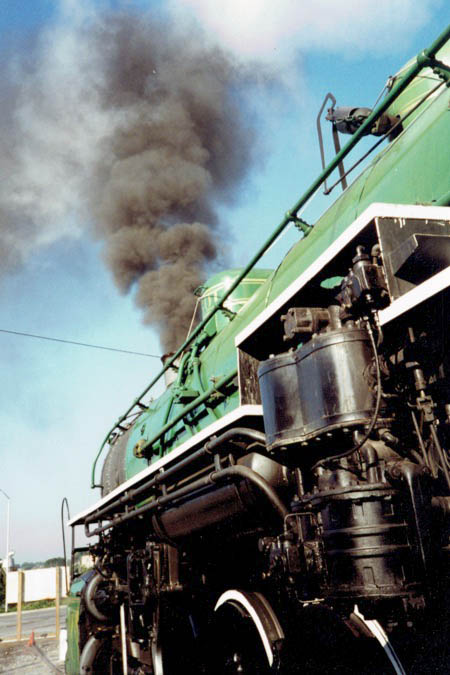
Oct 1993 / RWH

Bristol, Va / Oct 1993 / RWH
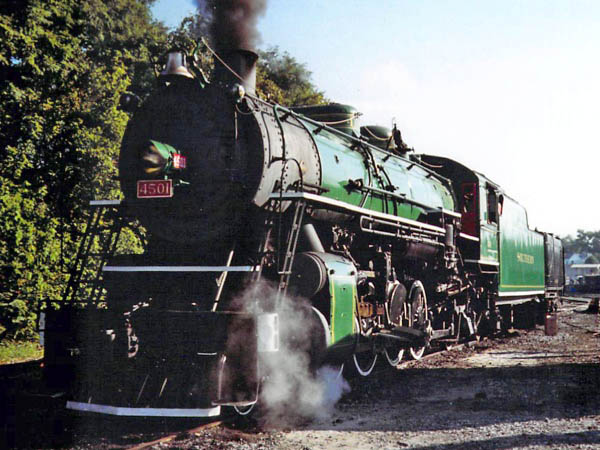
Bristol, Va / Oct 1993 / RWH
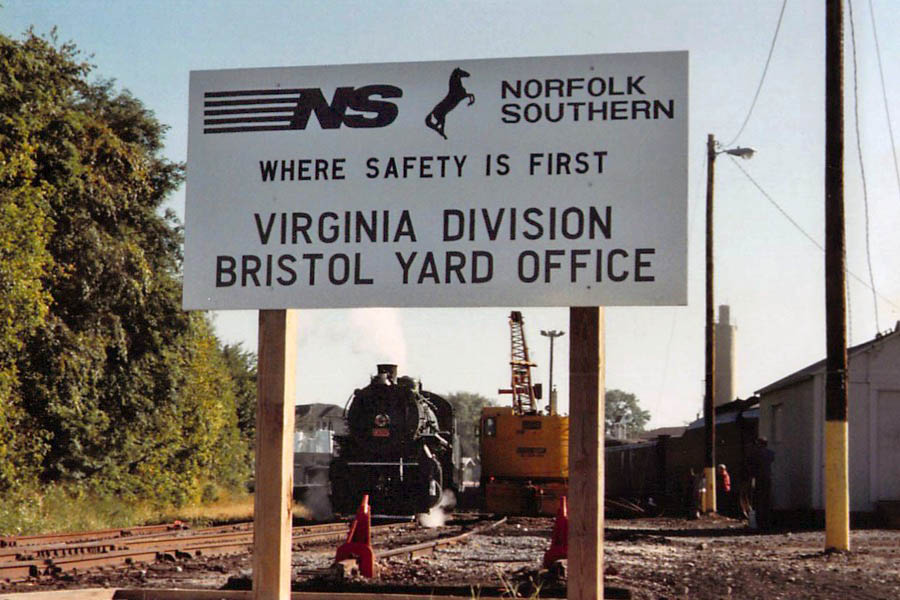
Bristol, Va / Oct 1993 / RWH
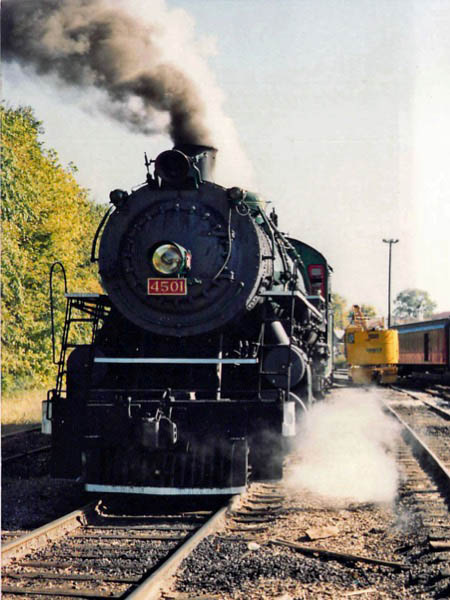
Bristol, Va / Oct 1993 / RWH
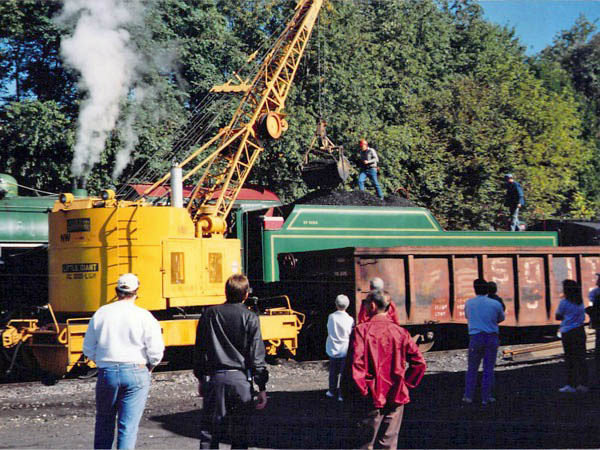
Bristol, Va / Oct 1993 / RWH
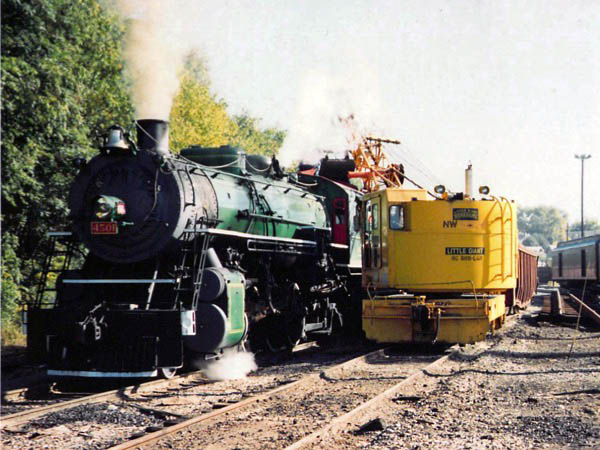
Bristol, Va / Oct 1993 / RWH
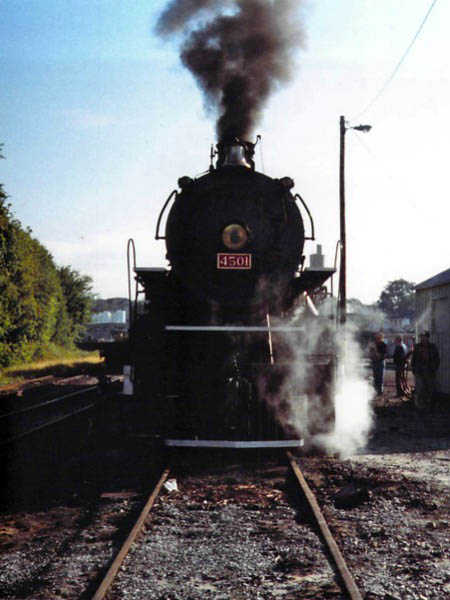

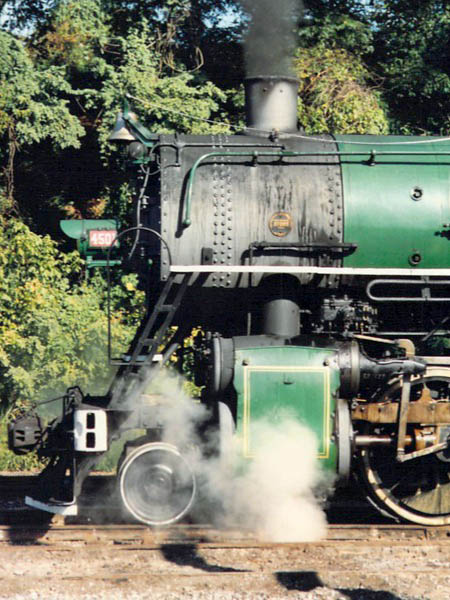
Bristol, Va / Oct 1993 / RWH

Bristol, Va / Oct 1993 / RWH

Oct 1993 / collection

See also our complete Norfolk & Western #611 featured steam scrapbook

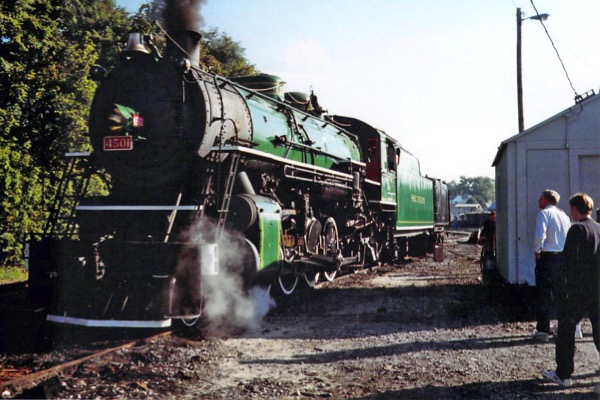 By the time I was in college, Southern #4501 was an old friend. So it was a treat to hear the news that she would be spending the night nearby during my sophomore year. I had just moved to Bristol, Tennessee, to attend a liberal arts college there. Although railfanning was not at the forefront of my mind in those college years, the word that #4501 and Norfolk & Western #611 would be tied down together overnight between weekend excursions was enough to get me out of the dorm and down to Bristol yard for an inspection. As I say, 4501 was like an old friend by that point, but I had only ever seen the big J in print or on a few VHS tapes from the early 1980s. Nothing prepares you for an up close encounter with her impressive stature and stylized lines of the J, and it was great to see them together on the side tracks for servicing. I remember that weekend well — October of 1993 — as I had only just met and begun dating my eventual college sweetheart, later bride. Her family was in town that weekend for other reasons, and I was delighted to discover that they all had a soft spot for trains. We all ventured down to the old N&W yard and inspected both locomotives, idle for the evening. The photo above shows my father-in-law-to-be inspecting Paul Merriam's project ... and my old friend.
By the time I was in college, Southern #4501 was an old friend. So it was a treat to hear the news that she would be spending the night nearby during my sophomore year. I had just moved to Bristol, Tennessee, to attend a liberal arts college there. Although railfanning was not at the forefront of my mind in those college years, the word that #4501 and Norfolk & Western #611 would be tied down together overnight between weekend excursions was enough to get me out of the dorm and down to Bristol yard for an inspection. As I say, 4501 was like an old friend by that point, but I had only ever seen the big J in print or on a few VHS tapes from the early 1980s. Nothing prepares you for an up close encounter with her impressive stature and stylized lines of the J, and it was great to see them together on the side tracks for servicing. I remember that weekend well — October of 1993 — as I had only just met and begun dating my eventual college sweetheart, later bride. Her family was in town that weekend for other reasons, and I was delighted to discover that they all had a soft spot for trains. We all ventured down to the old N&W yard and inspected both locomotives, idle for the evening. The photo above shows my father-in-law-to-be inspecting Paul Merriam's project ... and my old friend.
 Mikado Postcards
Mikado Postcards

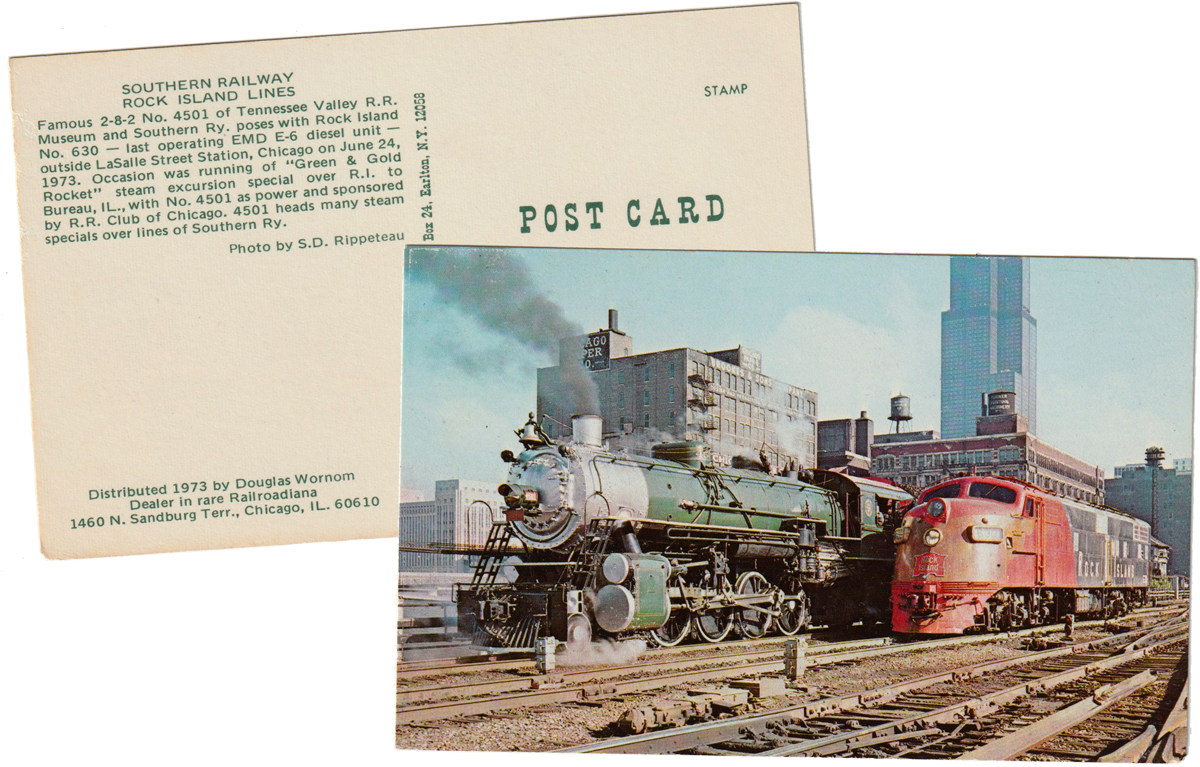
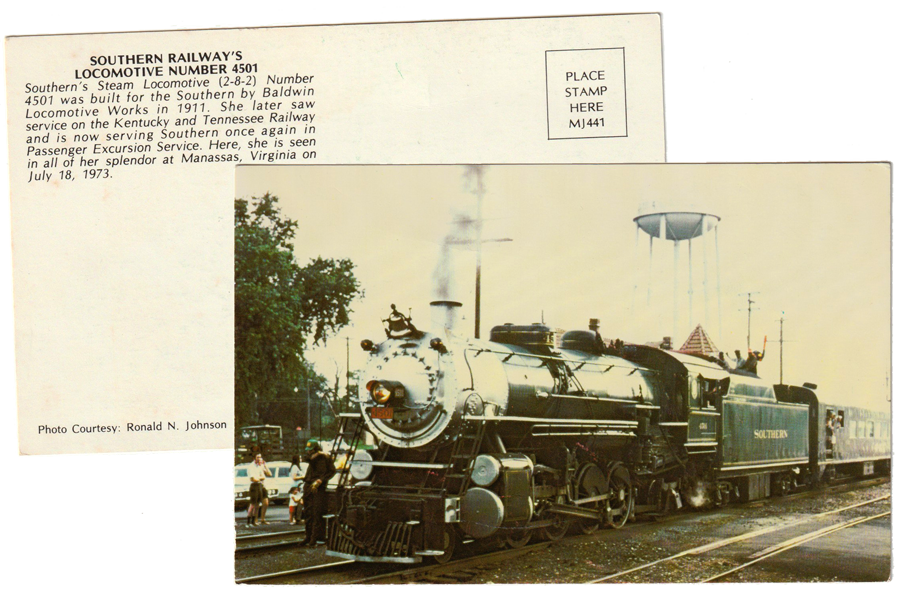
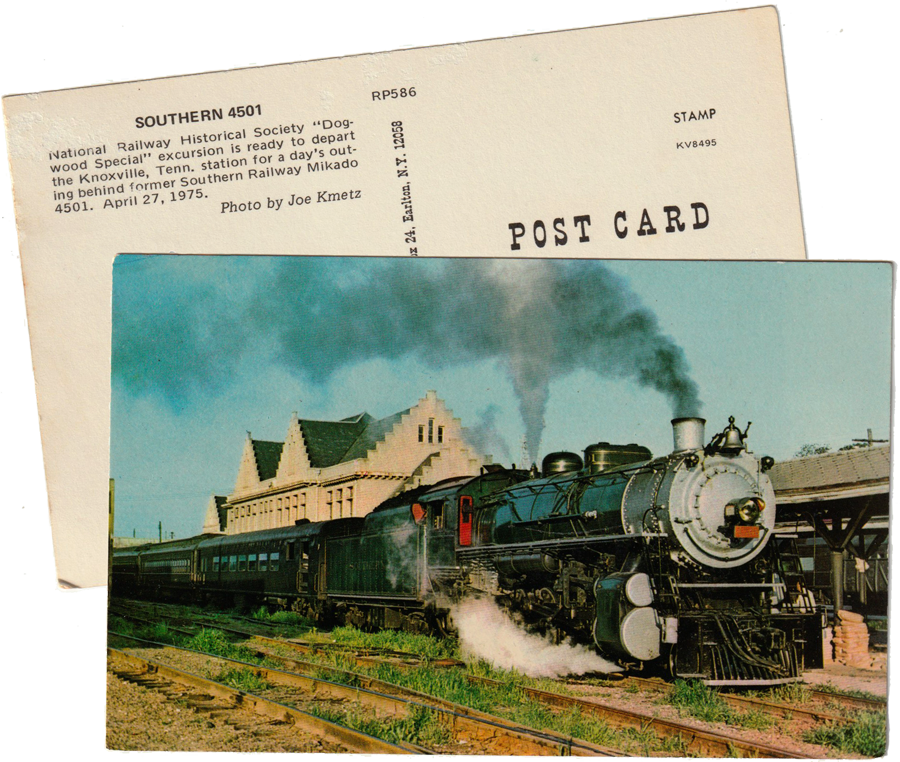
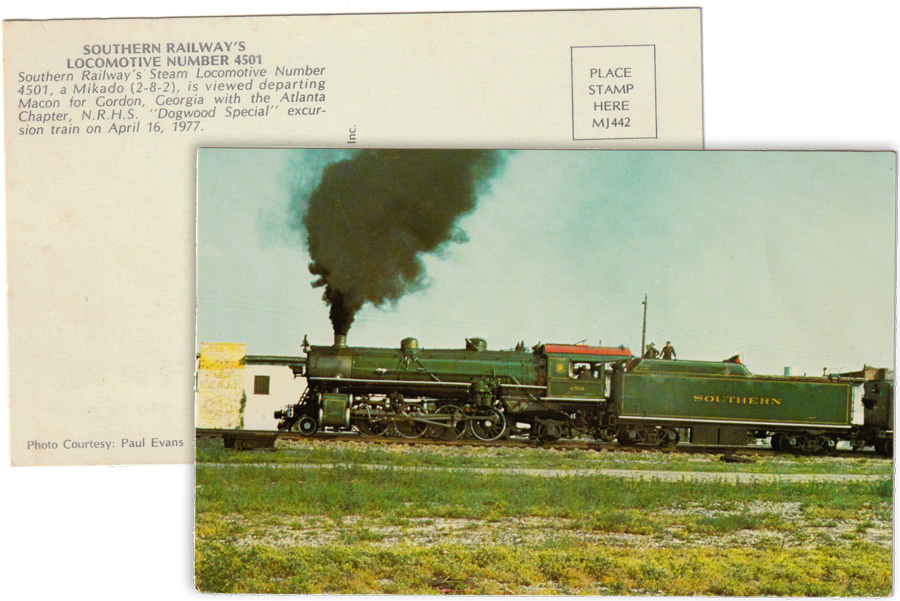
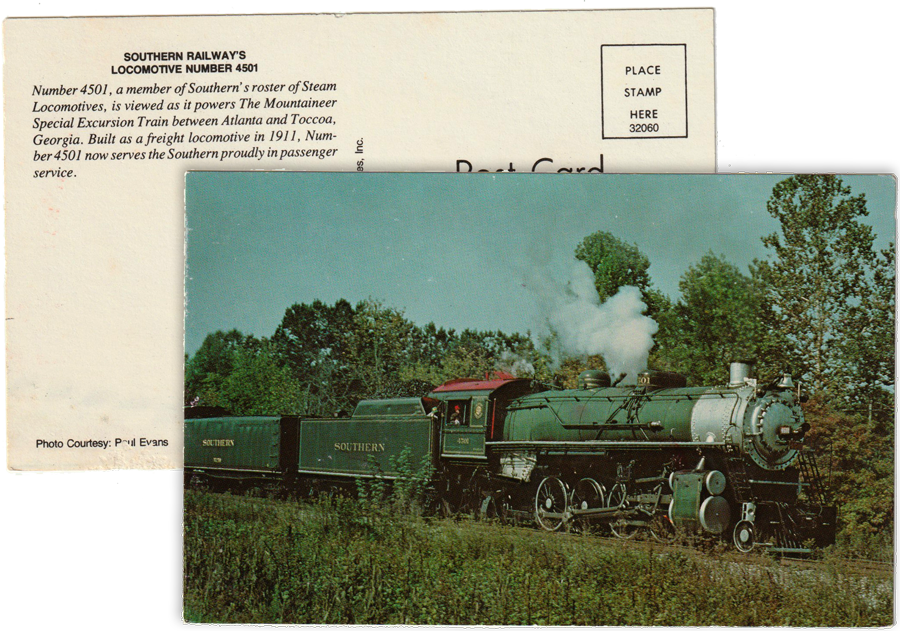
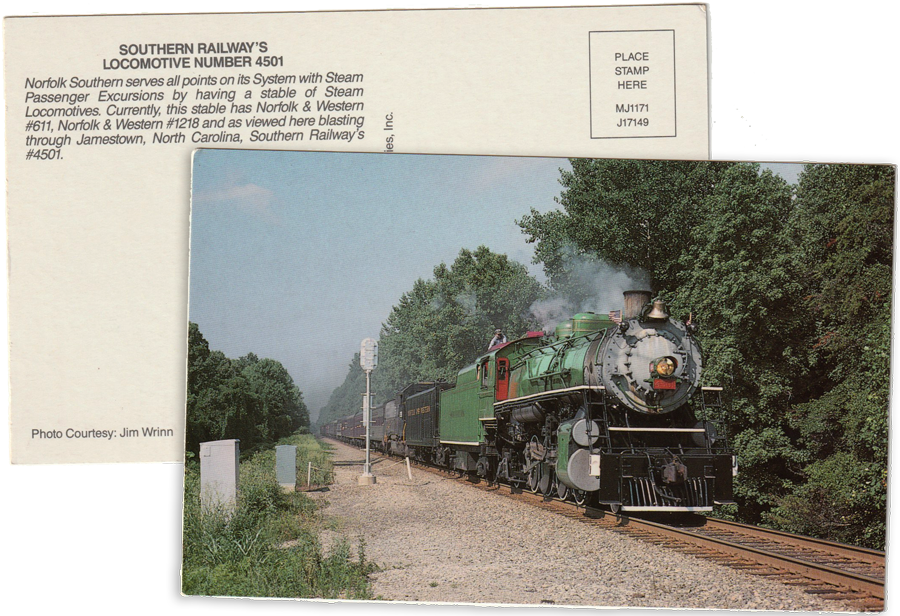
all postcards above from RWH collection
 Tennessee Valley Railroad Museum
Tennessee Valley Railroad Museum

East Chattanooga, Tn / Jun 1990 / RWH

Jun 1990 / RWH
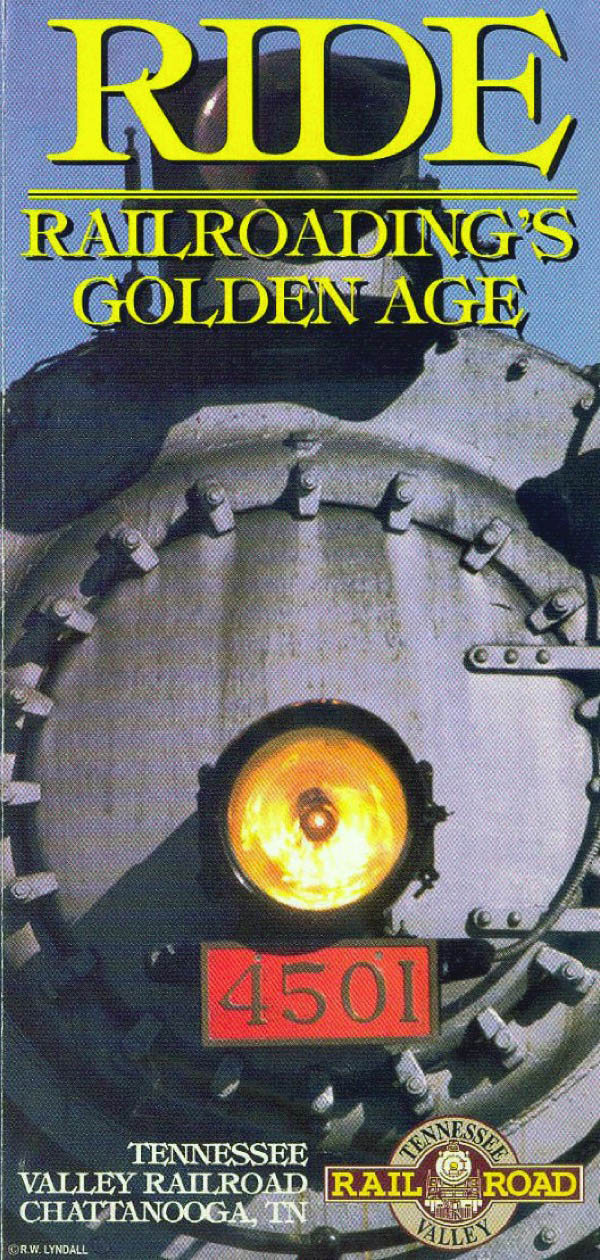
brochure / collection

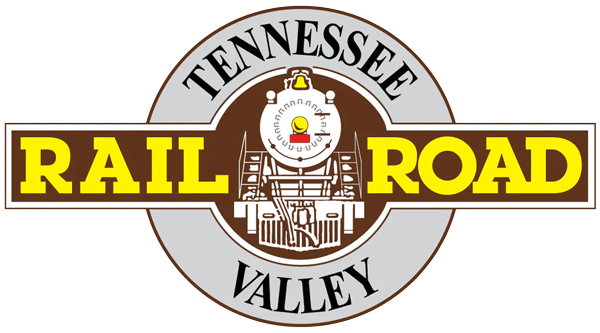 During the following 16 years [on the Kentucky & Tennessee Railway], this rather inauspicious locomotive remained in obscurity in the mountains of east/central Kentucky, until it was discovered by Robert Soule and Paul Merriman, two gentlemen on a mission to see and photograph the remaining holdouts for steam power in the east. The two men would later form the Tennessee Valley Railroad Museum in 1961. They immediately took a liking to the 12, which is different in appearance from stablemates 10 & 11. It was obviously of Southern Railway pedigree. When Soule and Merriman learned that the K&T was converting to diesel, they raised the $5,000 asking price that Mr. Bruce wanted for the 12 through TVRM, and off to Stearns they went to acquire ownership of the locomotive. After a meeting with Mr. Bruce, Merriman came back outside exclaiming “Fellas, I did it!,” to which Soule replied with, “You did what Paul?” “I bought the 4501!,” he exclaimed. Indeed, Paul Merriman had purchased with his own funds, this locomotive, instead of with TVRM funds as planned. Left standing with a $5,000 check, the members of TVRM later went back to Mr. Bruce to purchase stablemate K&T 10 for their museum.
During the following 16 years [on the Kentucky & Tennessee Railway], this rather inauspicious locomotive remained in obscurity in the mountains of east/central Kentucky, until it was discovered by Robert Soule and Paul Merriman, two gentlemen on a mission to see and photograph the remaining holdouts for steam power in the east. The two men would later form the Tennessee Valley Railroad Museum in 1961. They immediately took a liking to the 12, which is different in appearance from stablemates 10 & 11. It was obviously of Southern Railway pedigree. When Soule and Merriman learned that the K&T was converting to diesel, they raised the $5,000 asking price that Mr. Bruce wanted for the 12 through TVRM, and off to Stearns they went to acquire ownership of the locomotive. After a meeting with Mr. Bruce, Merriman came back outside exclaiming “Fellas, I did it!,” to which Soule replied with, “You did what Paul?” “I bought the 4501!,” he exclaimed. Indeed, Paul Merriman had purchased with his own funds, this locomotive, instead of with TVRM funds as planned. Left standing with a $5,000 check, the members of TVRM later went back to Mr. Bruce to purchase stablemate K&T 10 for their museum.
After that eventful day in 1964, this rather unremarkable locomotive was thrust into the spotlight, where it quickly became one of the most traveled, photographed, and inarguably one of the most famous steam locomotives in the world. Since the mid-1960s, Southern Railway 4501 has pulled countless mainline passenger excursions for the Southern (later Norfolk Southern) Railway Steam Excursion Program, and museum excursions for TVRM as well.
The 4501 ended its service in 1999 due to rising maintenance costs, but was later selected for service in the “21st Century Steam” program, being restored to service between 2011 and 2014. The “21st Century Steam” Program has since ended, but the 4501 can still be found operating over TVRM tracks today, to the delight of many happy passengers. Over the last 57 years in preservation, Southern Railway 4501 has carried hundreds of thousands of passengers on excursions all over the east and the midwestern United States, and it has been through those ticket sales, along with countless donations, that this locomotive is still operating today. So here’s to the first 110 years, and to the next 110!
The 4501 is listed on the National Register of Historic Places (#79002440).
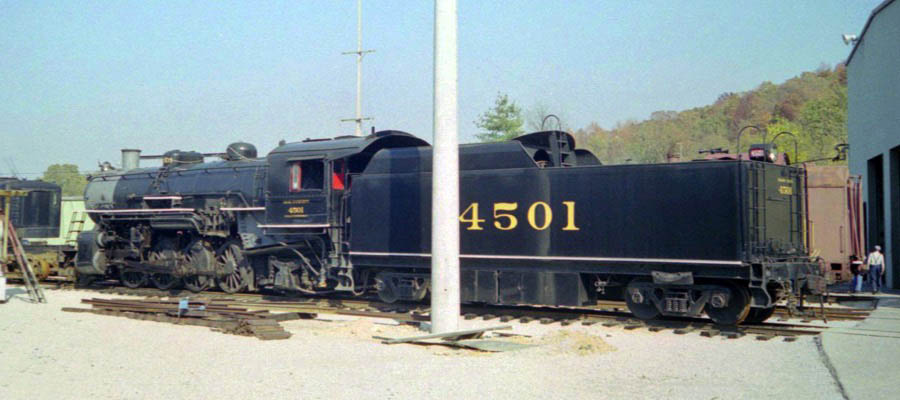
East Chattanooga, Tn / Nov 1999 / JCH
 Article
Article
TVRM's Historic Steam Locomotive #4501 Is Ready for Tennessee Valley Railfest
Sep 2014
CHATTANOOGA, TN — The Tennessee Valley Railroad Museum (TVRM) today announces the return of their iconic Steam Locomotive 4501 to operation. TVRM has been restoring Locomotive 4501 over the past three years and she will make her public debut at Tennessee Valley Railfest on September 6 & 7. The locomotive last ran in 1998 and has patiently waited for a complete overhaul. The locomotive restoration specialists at TVRM began the project in 2011 and it has continued nonstop since then. The 4501 has now rolled out of Soule Shops in East Chattanooga looking better than ever. After testing and various final adjustments, the locomotive will make its public debut at the Railfest celebration.
"This is a dream come true," said TVRM spokesperson Steve Freer. "Many of us at TVRM grew up riding behind 4501 (often simply referred to as "the 01") and loved every minute of it. With the diminishing demand for main line rail excursions in the 1990's, large locomotives were relegated to storage or display. However, 4501 is returning to active operation. It is a great day for TVRM and we are thrilled to make this example of living history available to the public."
Railfest is an annual celebration of railroading at TVRM, which includes train rides, special exhibits, interesting displays, model railroads, children's activities, live entertainment, and more. The public debut of Locomotive 4501 will feature a public dedication at at Railfest.
Locomotive 4501 has an interesting history: She was built for Southern Railway in 1911 and worked for 37 years before being forced out of service by a wave of modern diesel locomotives. Instead of being scrapped as so many other steamers were, 4501 was sold in 1948 to the Kentucky & Tennessee Railway in Stearns, Kentucky, to haul coal from mines served by the K&T. After 16 years serving the K&T, 4501 was sold to Chattanooga railroad enthusiast Paul Merriman in 1964. Merriman was a TVRM founder and president at the time, and brought Locomotive 4501 to Chattanooga for display and possible operation. This is just what the fledgling museum needed, as 4501 was a highly visible symbol of steam railroading.
Shortly thereafter, Southern Railway leased the engine from TVRM to be used throughout their system as a roving ambassador and to pull public rail excursions, which continued until 1994. Back in home in Chattanooga, TVRM was able to operate the locomotive until its boiler certification ran out in 1998. Since other steam locomotives were operating at TVRM at the time, 4501 rested in semi-retirement until 2011 when Norfolk Southern inaugurated their "21st Century Steam" program. 21st Century Steam is a program of excursions for Norfolk Southern employees and the general public, utilizing steam locomotives on a limited number of trips on Norfolk Southern rail lines. TVRM's Locomotive 630 has been participating in the programs since 2011, and now with the help of many contributors, including Norfolk Southern, 4501 will join the program in 2015.
Tennessee Valley Railroad Museum
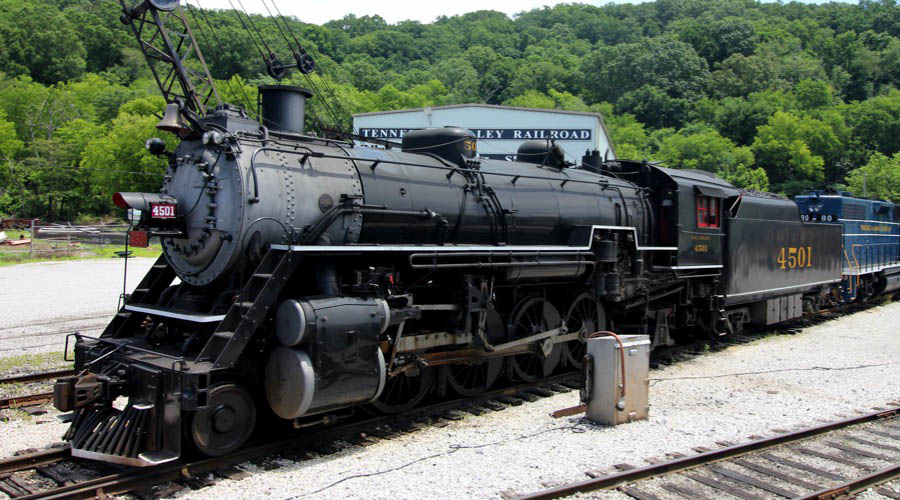
East Chattanooga, Tn / Jun 2019 / RWH
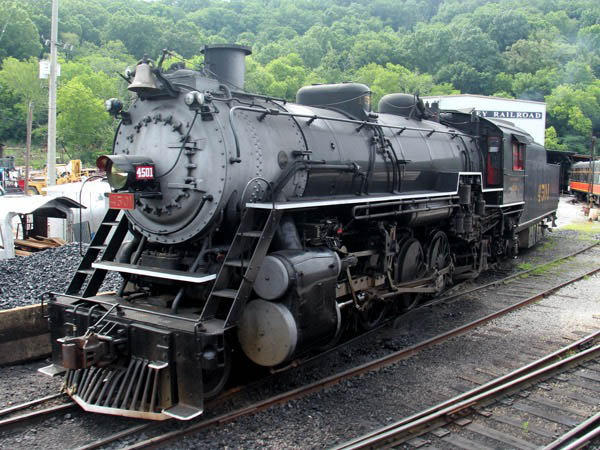
East Chattanooga, Tn / Jun 2019 / RWH
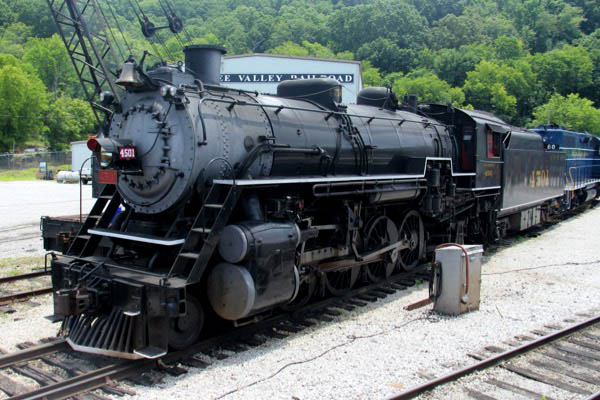
Jun 2019 / RWH
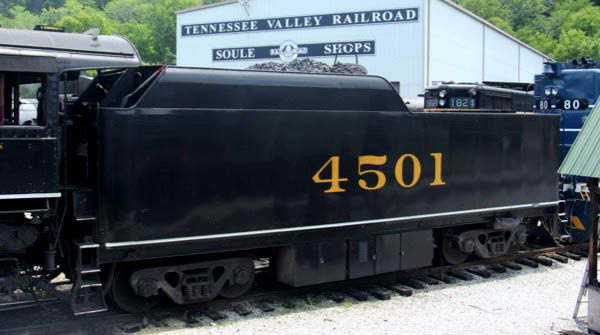
Jun 2019 / RWH

East Chattanooga, Tn / Jun 2019 / RWH

East Chattanooga, Tn / Aug 2021 / RWH
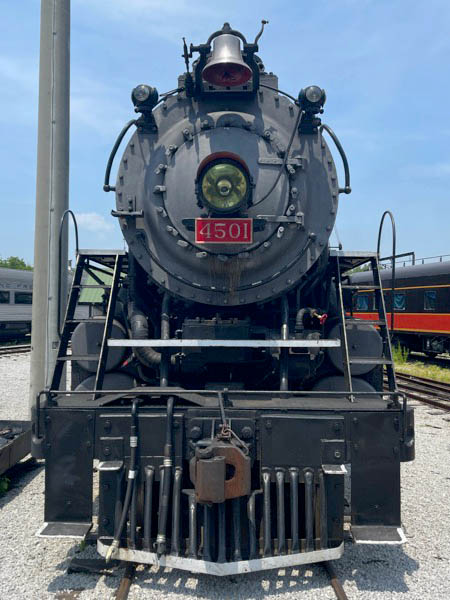
Aug 2021 / RWH
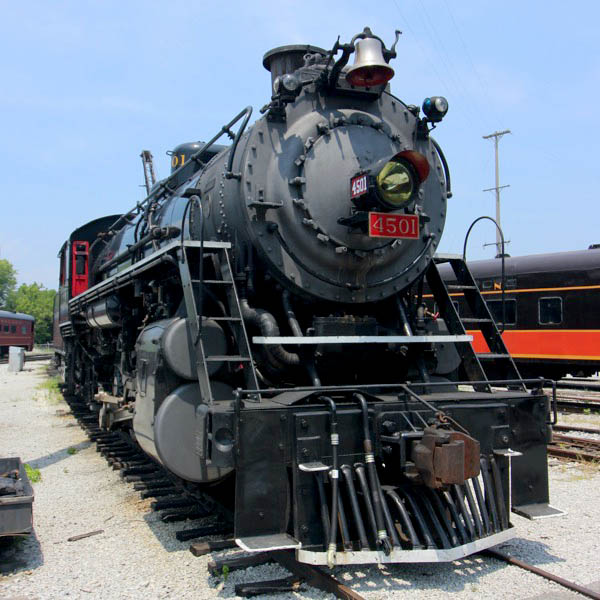
East Chattanooga, Tn / Aug 2021 / RWH
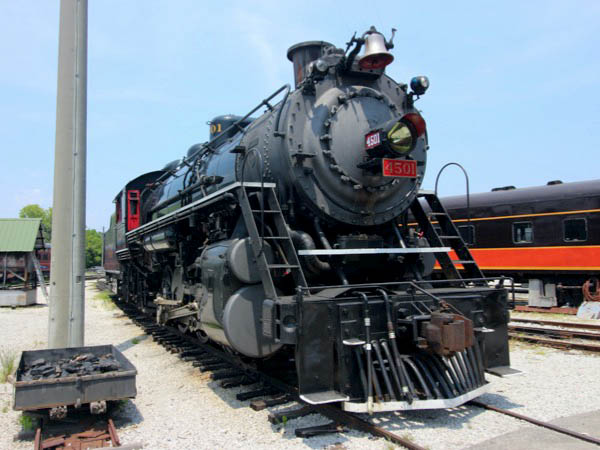
East Chattanooga, Tn / Aug 2021 / RWH
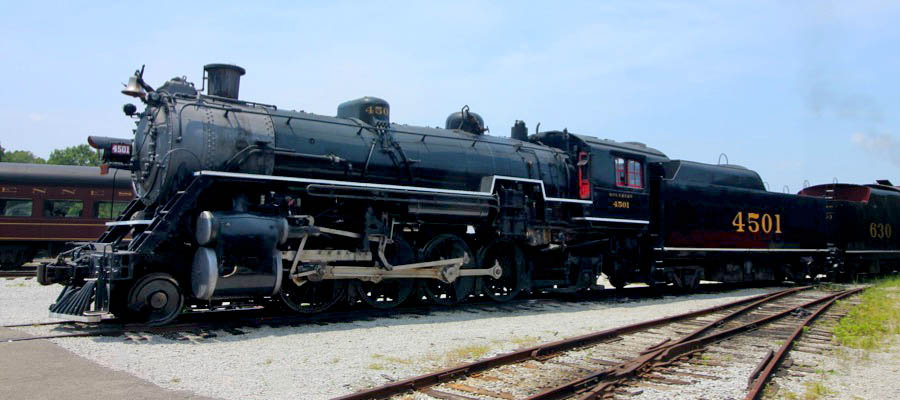
East Chattanooga, Tn / Aug 2021 / RWH
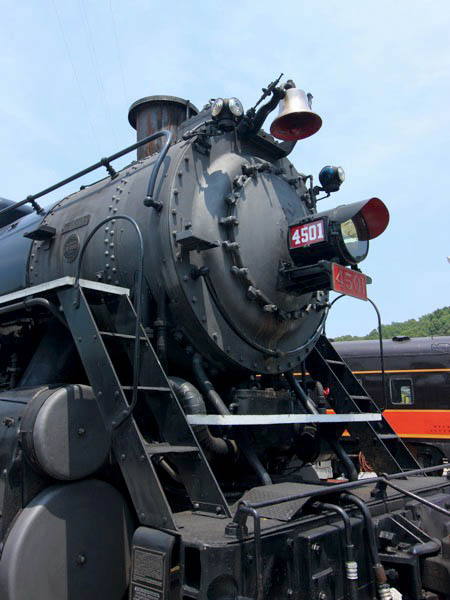
Aug 2021 / RWH
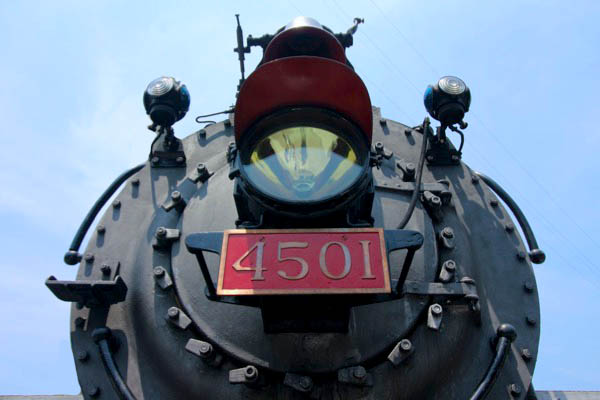
Aug 2021 / RWH
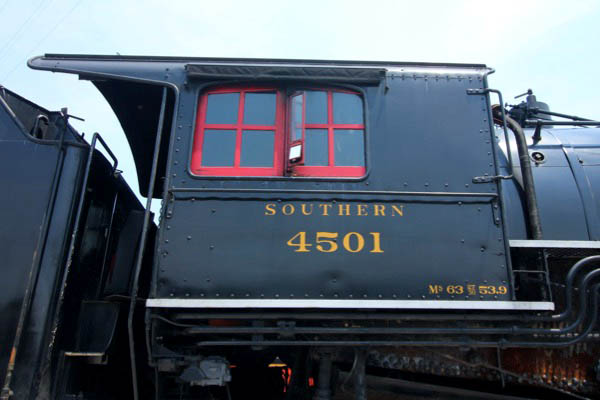
Aug 2021 / RWH
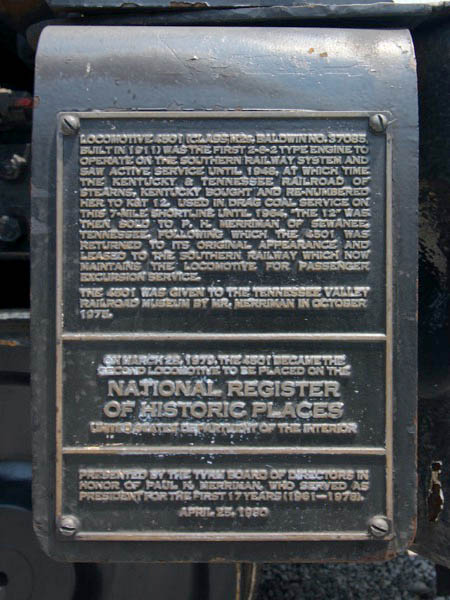
Aug 2021 / RWH

Aug 2021 / RWH
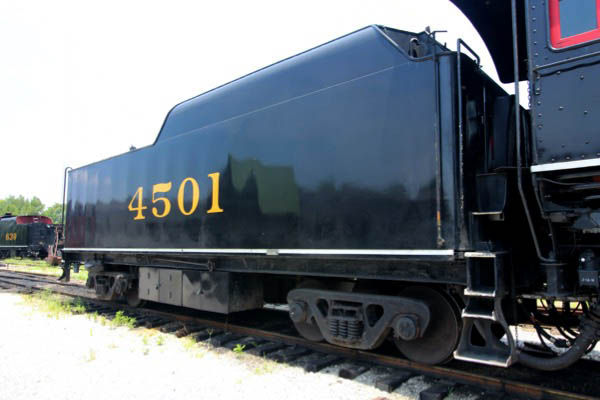
Aug 2021 / RWH

See also our complete Tennessee Valley Railroad Museum steam scrapbook in Preservation
 Clippings
Clippings

from Steam Locomotive & Railroad Tradition
#17 - Feb 1967 / collection
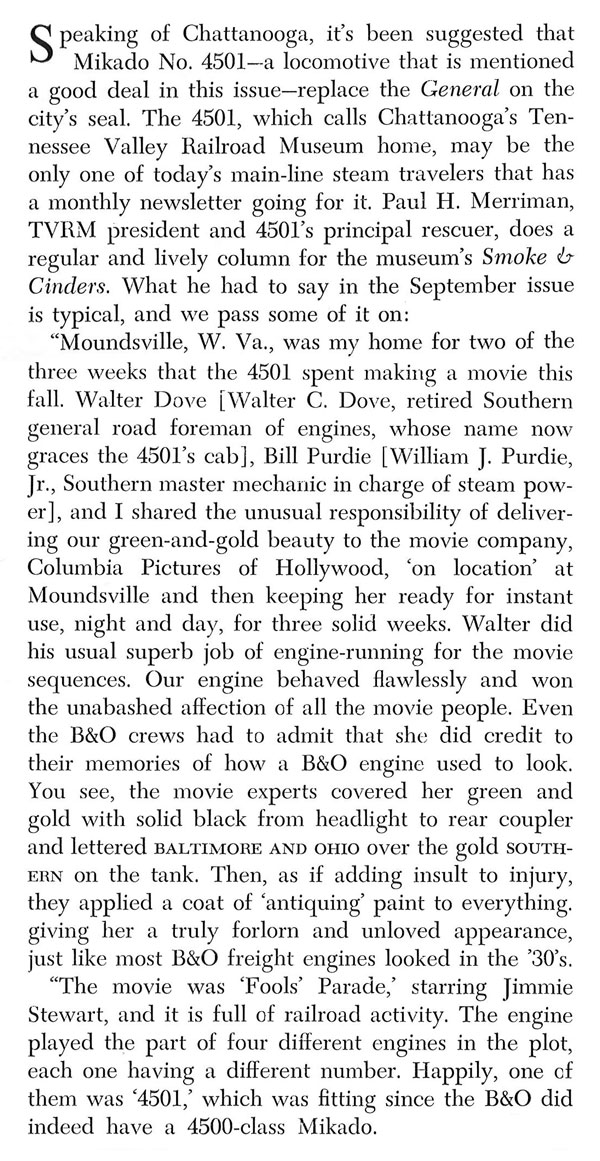
from Railroading
- Nov 1970 / collection

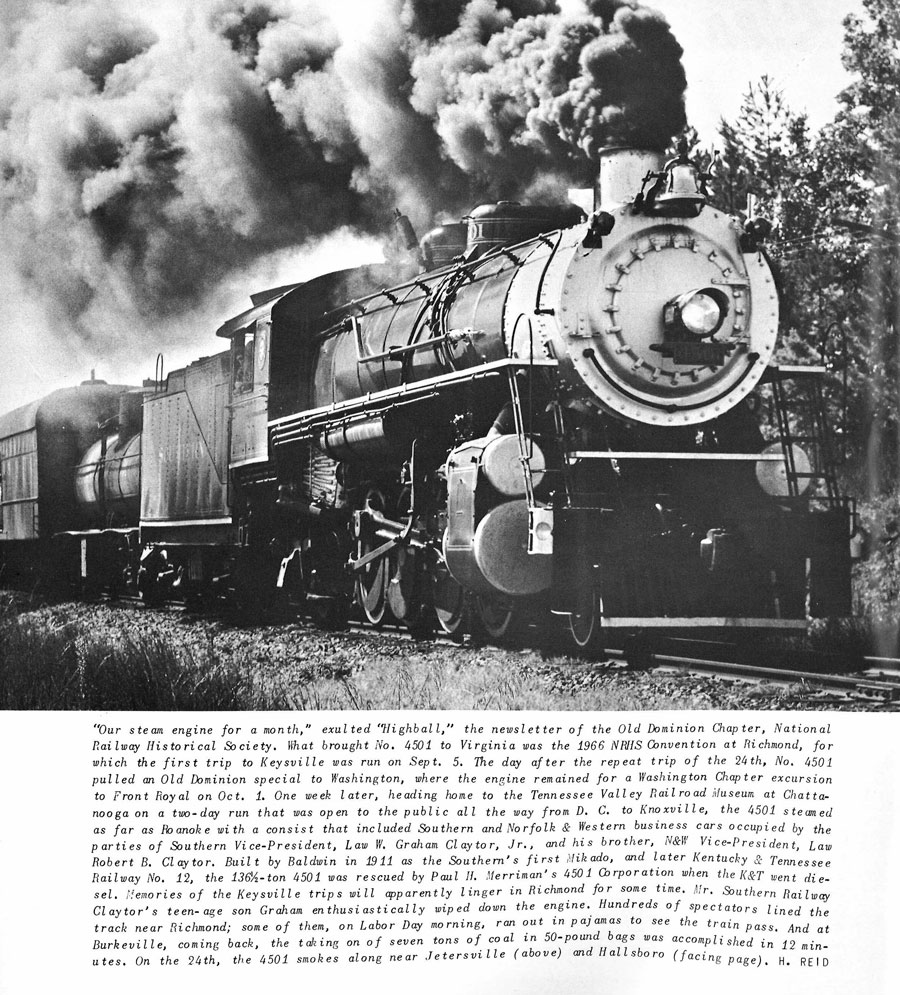
from Steam Locomotive & Railroad Tradition
#17 - Feb 1967 / collection
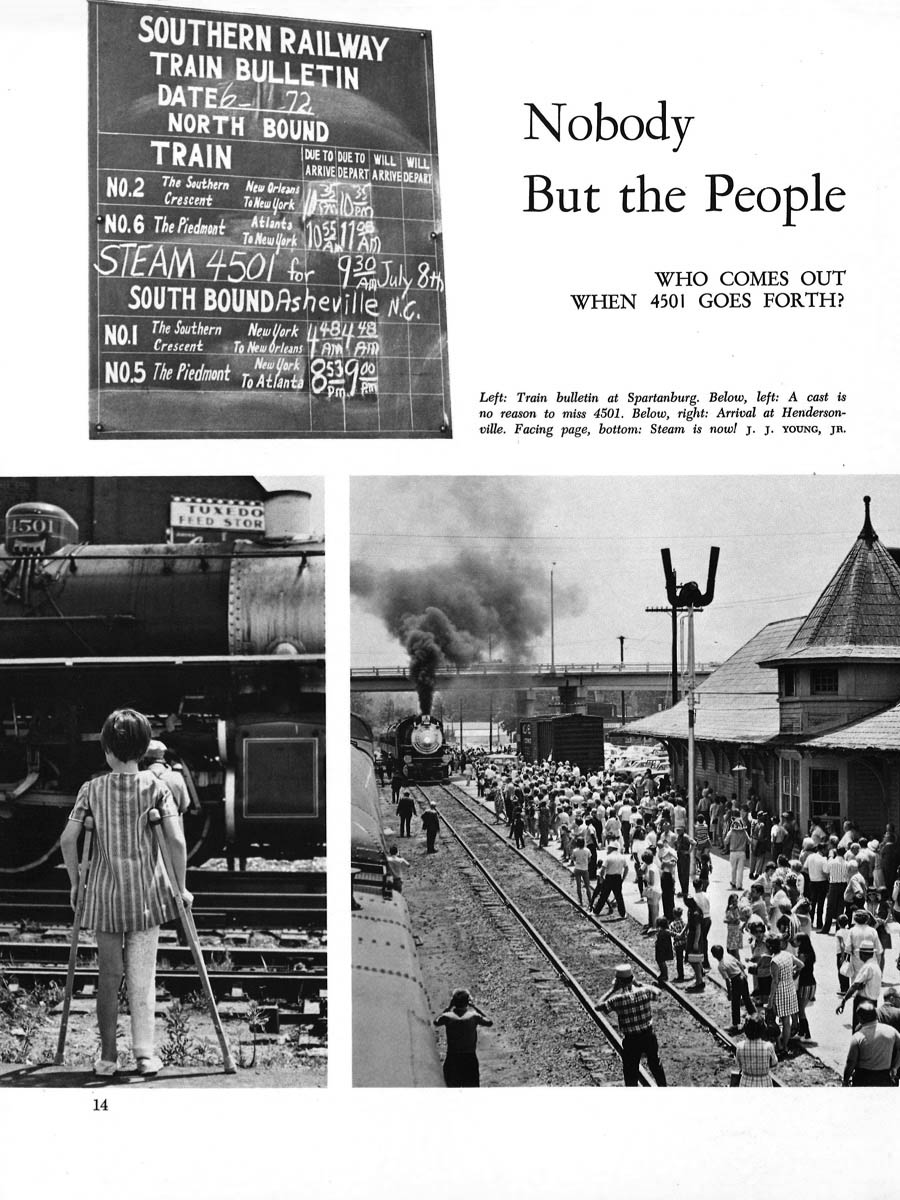
from Railroading
magazine #46 - First Quarter 1973 / collection
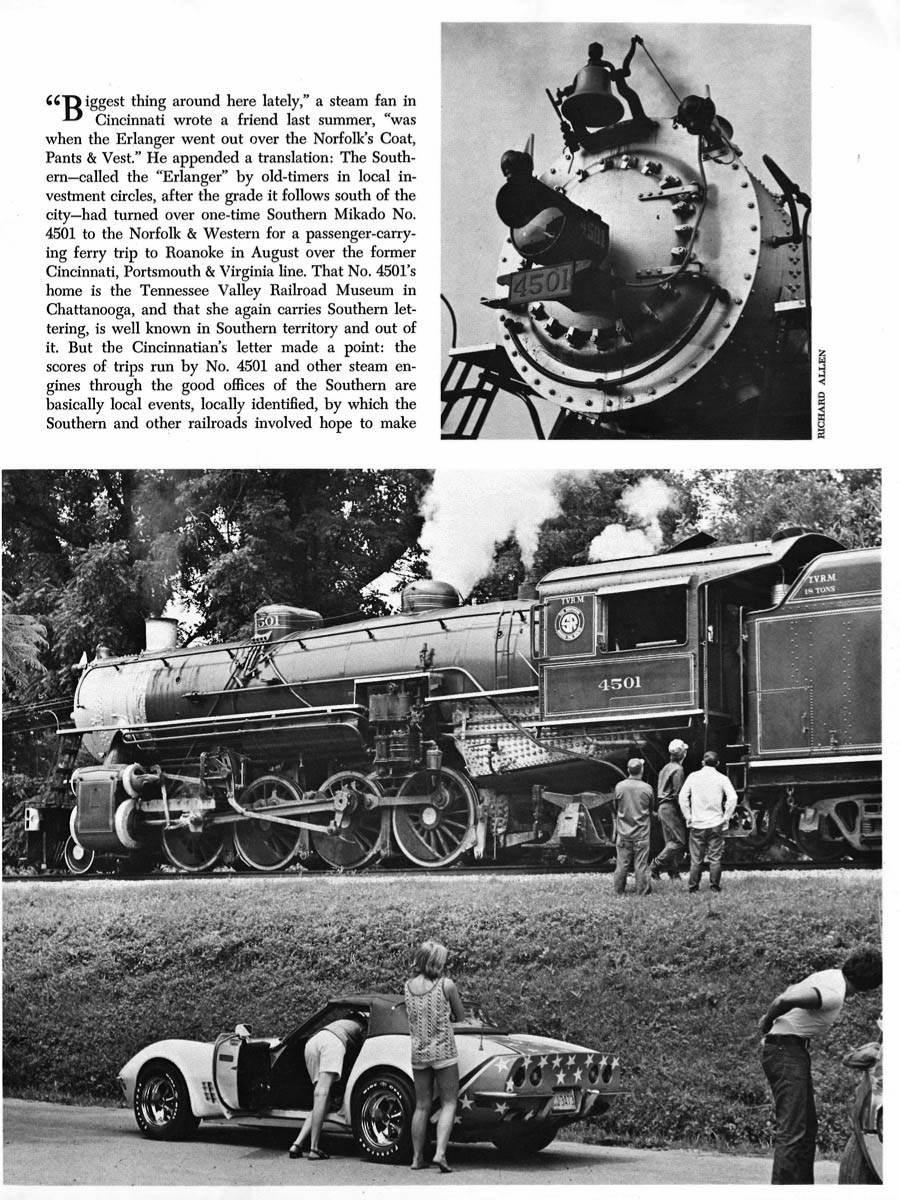
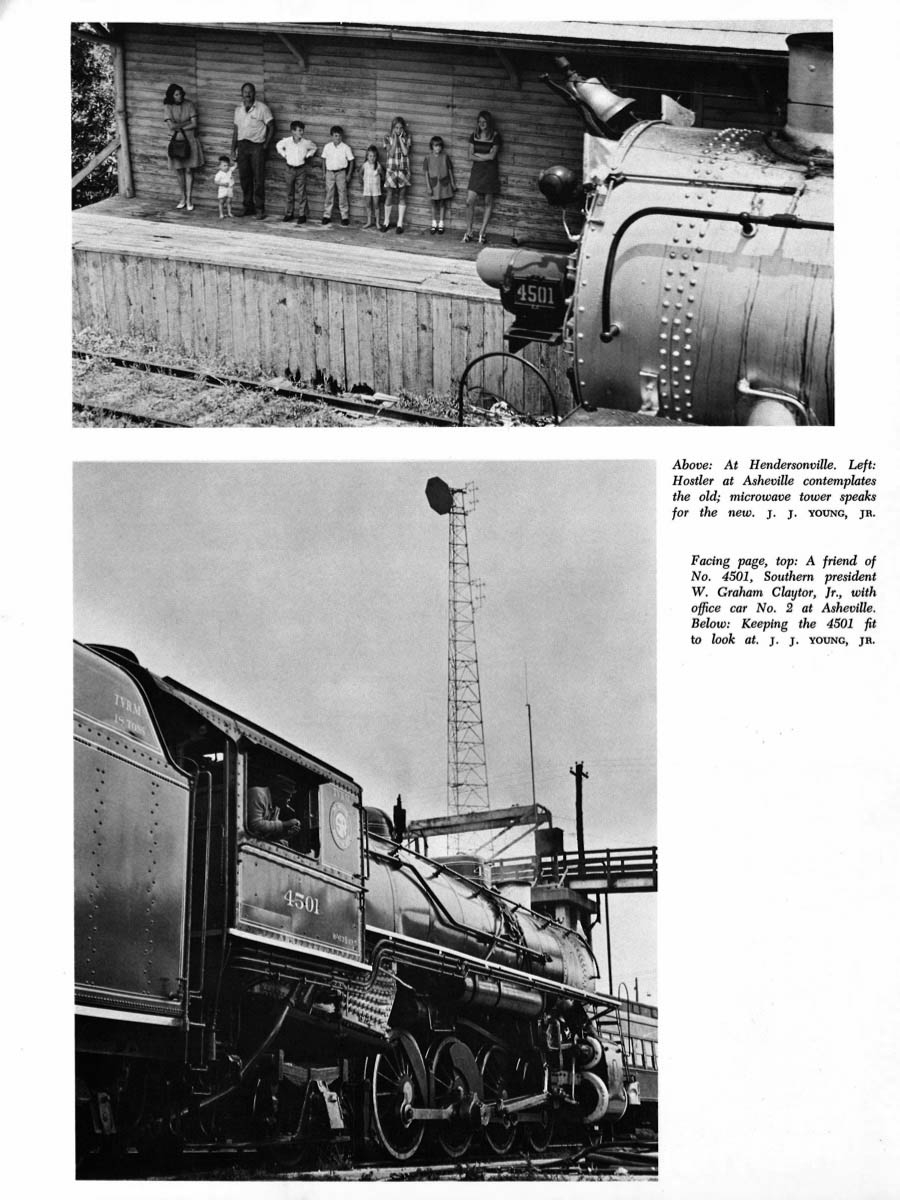
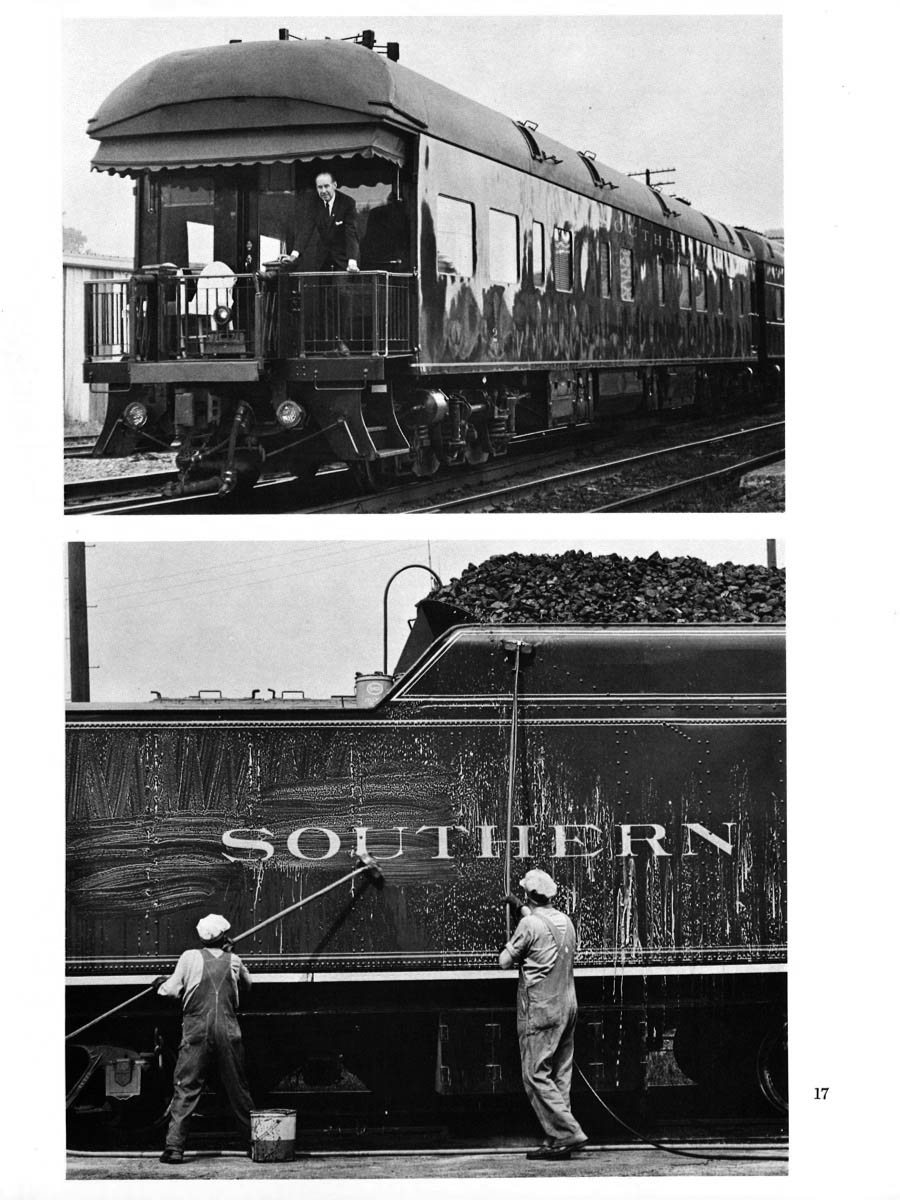
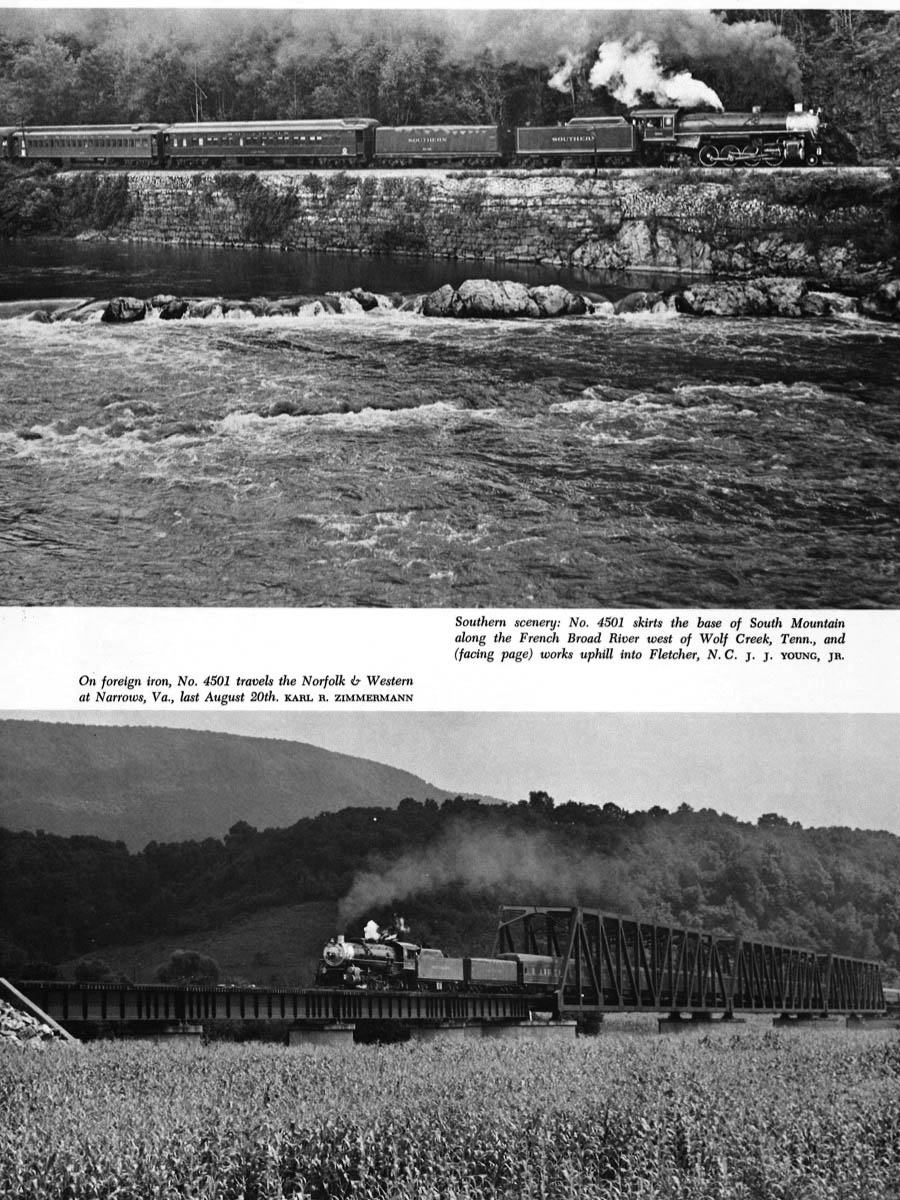
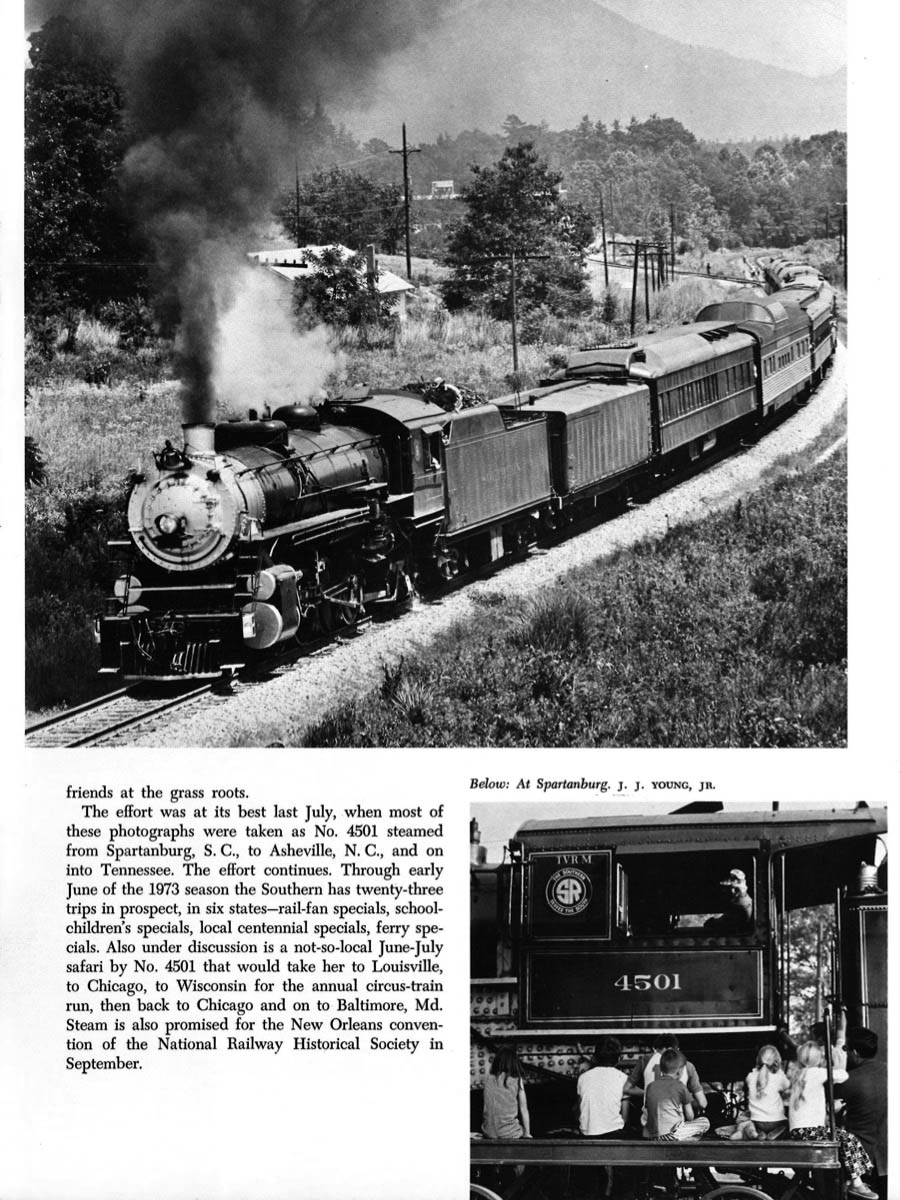
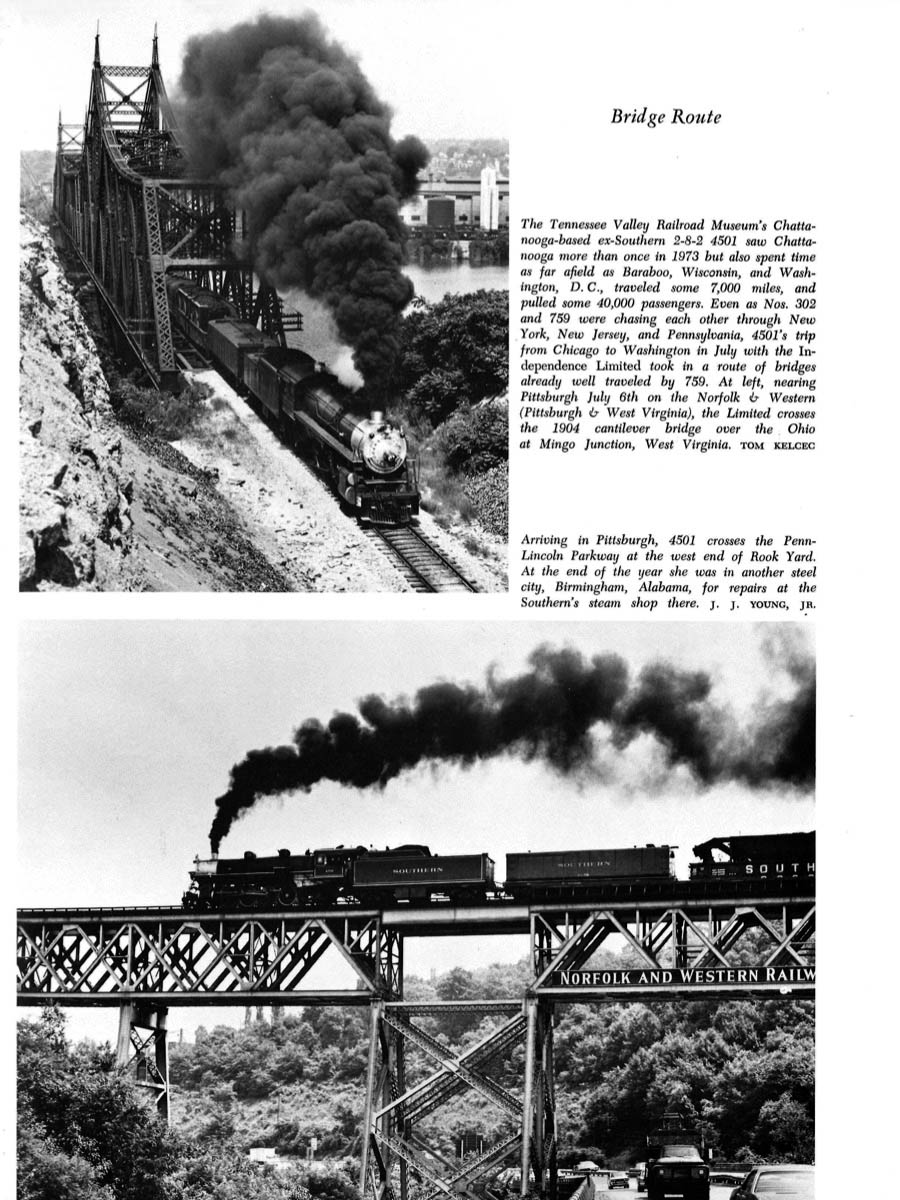
from Railroading
magazine #49 - First Quarter 1974 / collection
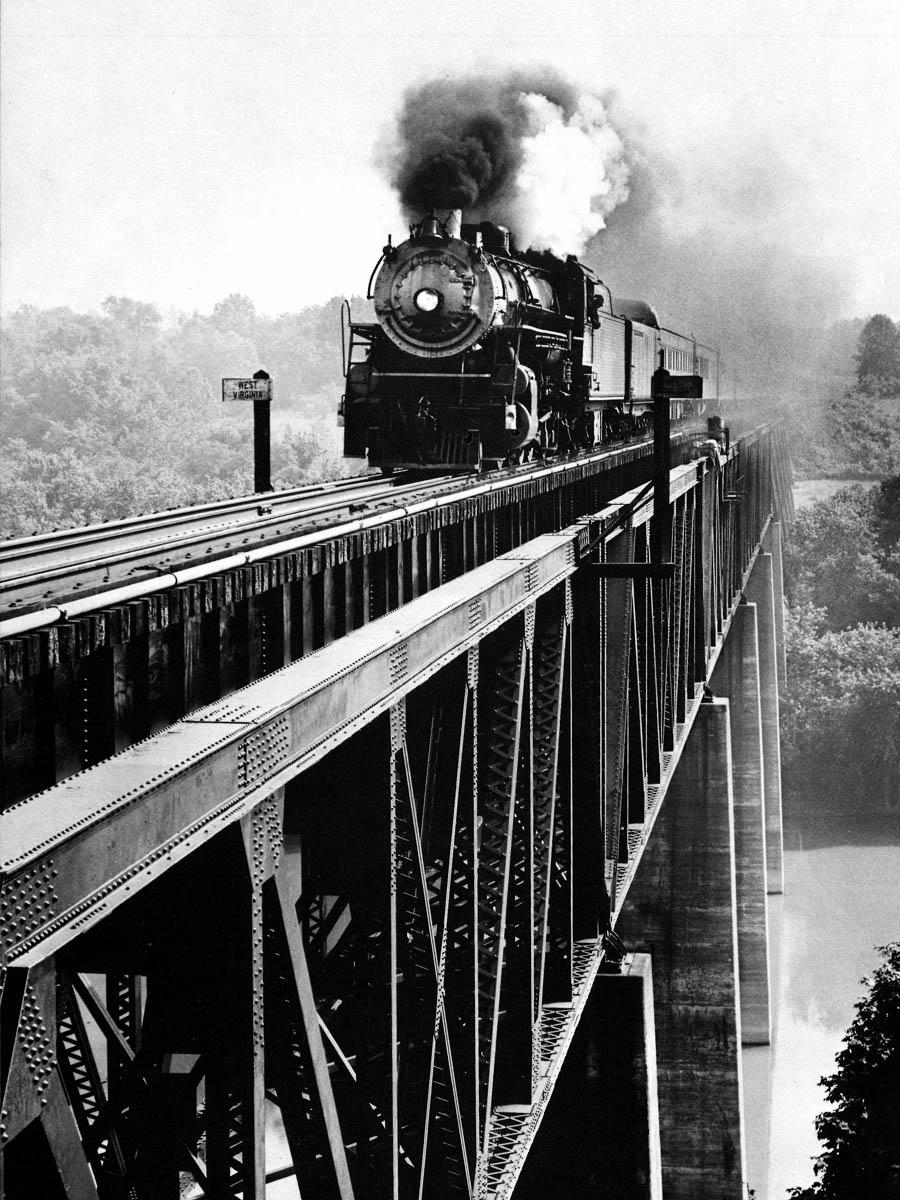
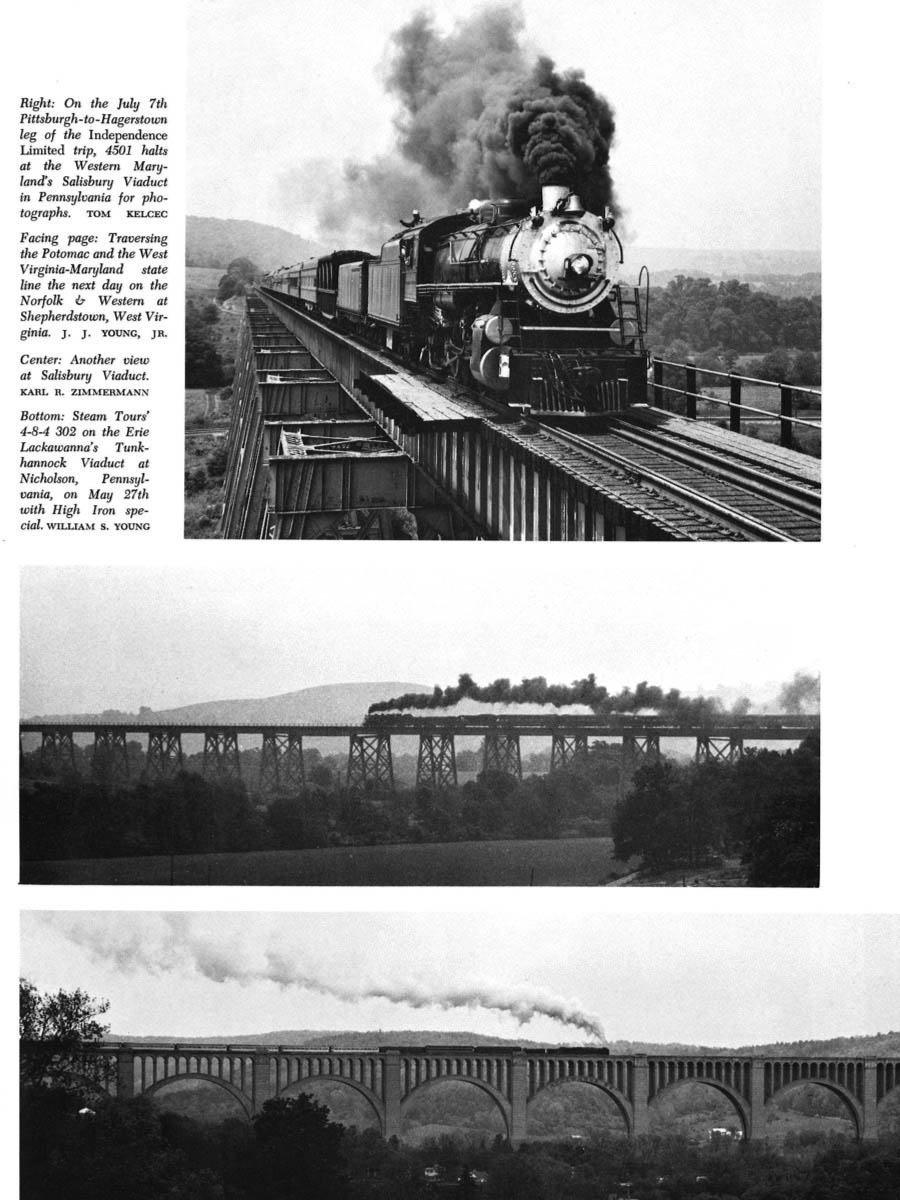
 Lagniappe
Lagniappe
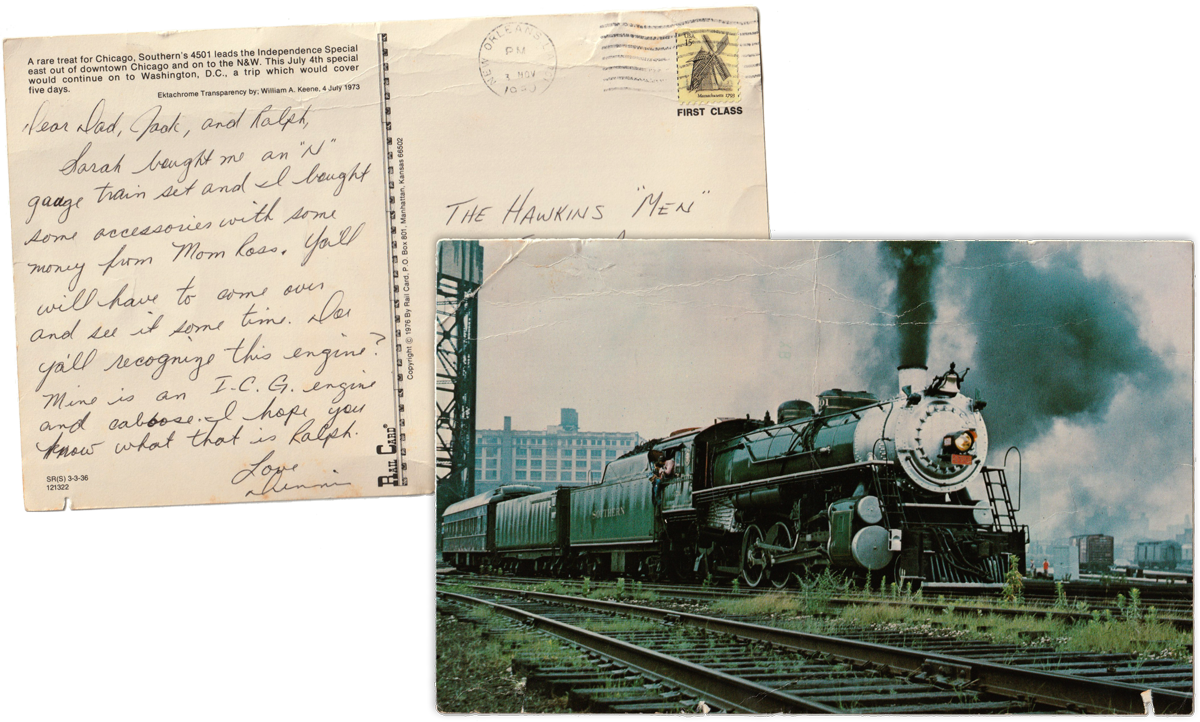
personal postcard / collection
Links / Sources
- Mikado Locomotive No. 4501 - Wikipedia article
- 4501 - A Photographic Collection
- Southern Steam Excursion Trips
- Southern Steam Trips - info on New Orleans trips
- David P. Morgan, Locomotive 4501 (Kalmbach, 1968)

